| |
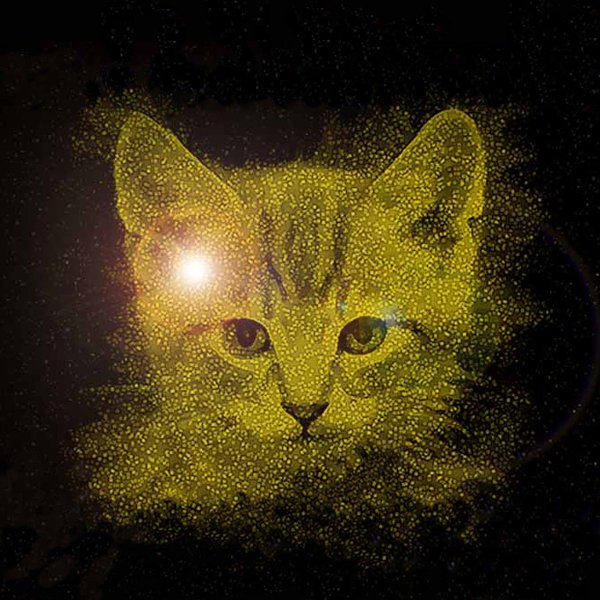 Welcome to The Grendelverse - Examining the
universe with ever improving virtual senses, we are learning
more each day. Some findings are
challenging fundamental
principles, while
others present entirely new questions. Fascinating mysteries
abound. Join the Grendelcat for
an independent review of the latest
developments. Welcome to The Grendelverse - Examining the
universe with ever improving virtual senses, we are learning
more each day. Some findings are
challenging fundamental
principles, while
others present entirely new questions. Fascinating mysteries
abound. Join the Grendelcat for
an independent review of the latest
developments.
[Last Update: November 9th, 2023. Last Overhaul: May 25th, 2021]
|
|
Here Comes The Sun
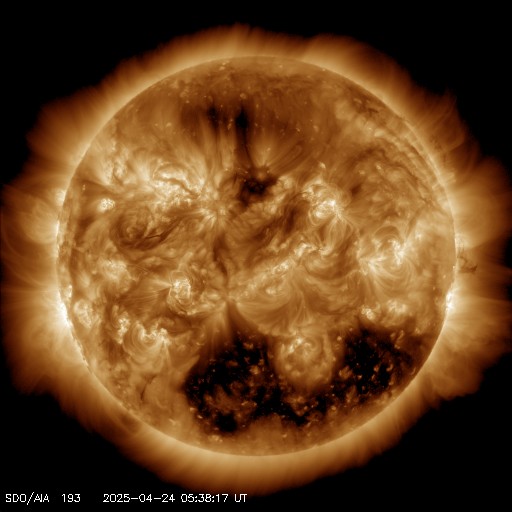
(SDO/GSFC/NASA Service)
Touching
Upon The
Sleepy Sun - As the story goes, the Sun is a
sphere of hot plasma. Deep within, nuclear fusion
churns several hundred million metric tons of
hydrogen into helium every second. This fusion reaction transmits
light slowly out of the solar body over thousands of years.
Finally the light emerges, and after a brief 8 minute
space-ride, it bathes the Earth's surface in life sustaining
illumination.
The Sun is postulated to have been around for about 4.5
billion years, and to have enough hydrogen fuel to keep going
for another 5 billion years or so. Within the Sun, a
theoretical dynamo of convective processes sustains emission of
a generally homogenous spectrum of light, while also generating
fluctuating surface features, solar wind, magnetism and
polarity. These features include a
roiling chaos of sunspots, towering solar twisters, massive
filament structures, magnetic loops, solar flares and coronal
mass ejections. Yet this cacophony is not random.
Instead, our sun's song pulses with an 11 year alternating
magnetic pole-flipping cadence of sunspot cycles.
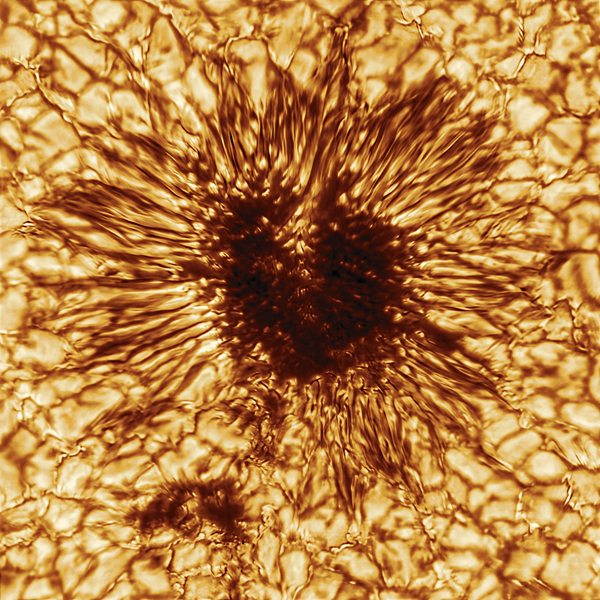 Spicules
are the smallest feature we see on the Sun. Of course, at Sun scales, 'smallest' is a relative term. Spicules are
radiating plasma jets moving 60 miles a second with lengths up
to 6000 miles. There are 10 million spicules blanketing
the surface of the sun at a time, each appearing and receding
over a brief 5-10 minute lifespan. Models suggest they are
sculpted by tangled magnetic field lines. Once they are
pulled above the surface, they straighten and expel magnetic
waves and solar material at high speed. Spicules
are the smallest feature we see on the Sun. Of course, at Sun scales, 'smallest' is a relative term. Spicules are
radiating plasma jets moving 60 miles a second with lengths up
to 6000 miles. There are 10 million spicules blanketing
the surface of the sun at a time, each appearing and receding
over a brief 5-10 minute lifespan. Models suggest they are
sculpted by tangled magnetic field lines. Once they are
pulled above the surface, they straighten and expel magnetic
waves and solar material at high speed.
Next up we have the granules. Thought to be caused by
convective currents, the surface of the sun appears grainy due
to these roughly thousand mile wide cells. There are
around 4 million of these covering the sun at a time, and like spicules,
granules also have brief 8-20 minute lives before dissipating.
Amidst this granulated ocean, sun spots sometimes
emerge correlated to magnetic field motions. These
fields can become twisted and tangled and when the fields cross,
this can lead to solar outbursts. The polarity of sunspots
and their orientation follow general rules through lifecycle
progression. Sunspots classified as Alpha are unipolar and
tend to be the calmest. Beta class sunspots are bipolar
with a simple division between polarity regions. Things
sometimes get mixed up over Beta clusters causing an occasional
flare, though Betas are generally mild mannered.
After Beta class sunspots, there are various mixtures and
combinations of Beta, Delta, and Gamma classes describing more
complex formations. As the field lines arc above, they can
loft streams of matter into coronal rains. The
complex polarity can tangle the field lines angling above
sometimes leading to major flare flashes,
filament releases and coronal mass ejections.
Solar flares launch spikes of radiation arriving at earth 8
minutes later. Unless we can figure out how to use quantum
entanglement to communicate faster than light, no detector would
be able to outrace the light of the flare to provide a warning
one was on the way. So, studying sunspots and predicting
probability of flare generation is the best we can do. The
GOES satellite
X-Ray flux feeds can be useful to determine the severity of
these events after the fact. Spikes in the M range are
serious flares, and if you happen to see it go more than a
few notches into X class range, it is a miracle you still have
internet and are seeing it at all.
In addition to light emission and flares, the sun projects
somewhat slower moving gusts of
particles in the solar wind as vast amorphous
features called coronal holes open up around the sun and spiral
material outward into the solar system like a twirling figure
skater discharging a super-soaker. These solar
winds include elements across the periodic table.
Solar Wind Monitor
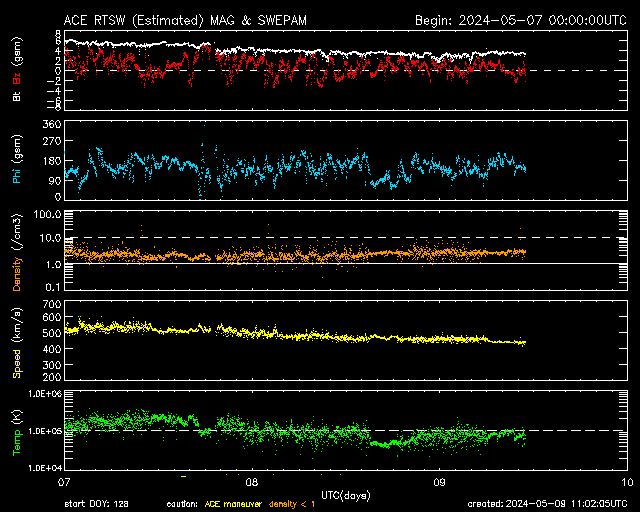
[Bz (North/South field orientation),
Phi Angle,
Density, Speed,
Temperature]
(DSCOVR/NOAA Service)
NOAA Space Weather Prediction Center:
Real Time Solar Wind
ENLIL Solar Wind Spiral
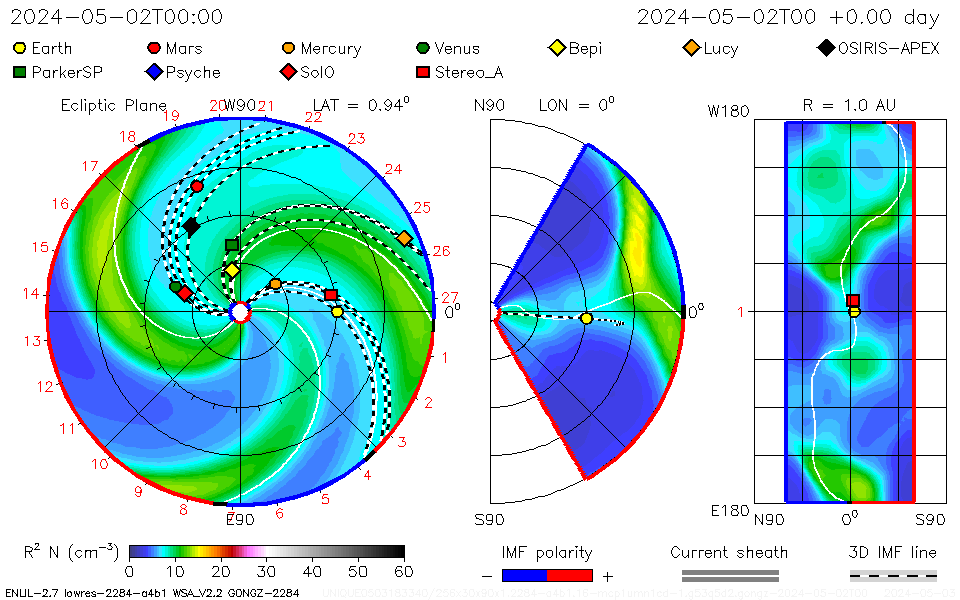
(iSWA Cygnet)
Energetic particle flows and electromagnetic fields modulate
planetary ionospheres throughout the solar system. An obvious symptom of
this energy transfer are auroras lighting up the poles of planets during solar storms.
Auroras are seen on all planets with a
significant magnetosphere. Solar output cycles and outbursts have also
been correlated across many planets and moons with weather patterns,
earthquakes, geysers, and volcanic activity.
Lack of solar activity during the ebb of the 11 year cycle
and during occasional extended solar minimums also has an
important effect. When the Sun's heliosphere weakens, its shielding
against cosmic background radiation decreases. Cosmic ray counts rise
during periods of weak solar output. This increases
volcanic activity and atmospheric cloud production, and it impacts
biology as well. In terms of human health, we have a solar wind sweet spot between
too much and not enough which is tracked
in the Kp Index.
Kp Index
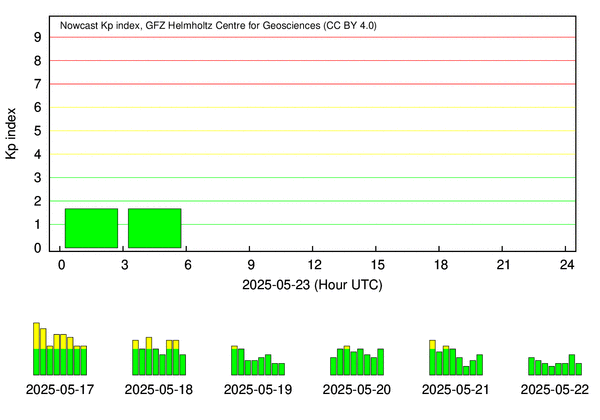
Health risks are associated both to Kp over
4 or remaining at
0 for consecutive intervals.
These health effects last 12-18 hours from the time of the
event.
(NOAA Service)
Health Risk Chart - Space Weather News.
One of the least established concepts
in science hovers around what is happening on the surface of the
sun and how it can emit a continuous frequency spectrum known as
blackbody radiation. One fascinating theory is that
metallic hydrogen in a plasma state forms a lattice similar to
graphite and could be the explanation of the behaviors at the
surface of our sun. Kirchhoff's law of thermal
radiation is in the process of being debunked as this study
progresses and serious people in the field are taking notice.
In addition to shaking the pillars of astrophysics, this
also calls into question mechanisms for star formation.
Some plasma theorists take issue with
the standard accretion model of the Sun suggesting instead,
stars are shocked into
existence as toroidal plasmoid spheres and that those same energy flows may
persist and modulate the cyclical behaviors of stars. Some
have even suggested these flows could be a primary mechanism
lighting up the stellar photosphere like Auroras do on Earth but
in full glow mode.
Energy flows
necessary to support plasmoids or to light up the gas
surrounding a star like a light bulb may be discovered as powerful currents and charged particle flows
seem to be hiding everywhere we
look a bit closer. To understand if energies from the
galaxy or cosmos create stars on filaments or supercharge stars into a plasma glow mode,
we need to check the battery to see how much juice they're
getting.
One way to do that is to investigate the heliosphere
boundary where the Sun's solar wind meets the interstellar
medium at the edge of the Sun's heliopause. Our understanding of this important boundary is limited.
Critical interactions are taking place with charged / neutral
particle flows, dust clouds, magnetic fields, plasma current,
cosmic radiation and even the rippling galactic energy sheet, but the periphery of the heliosphere is very far away.
Only the Voyager probes have crossed
into the boundary and phoned home to tell their tale.
Both have provided tantalizing hints about what might be going
on, but we have much to learn. An unexpected update
from Voyager 2 was recently accomplished using a deep space
network dish. New findings indicate plasma density
readings are exceeding expectations. This could mean the
interstellar medium is less empty than expected or that the heliosphere
boundary can be variable and sometimes much wider than expected.
It could also mean that conditions are changing.
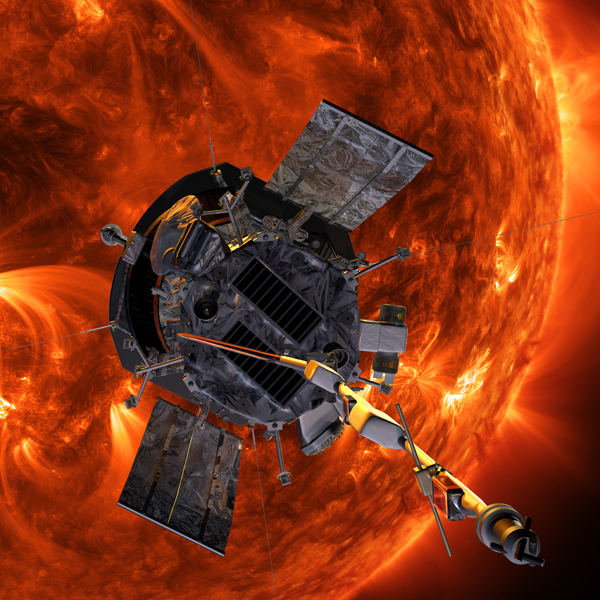 In the other direction looking toward the Sun, investigations
are rocketing forward.
The
Parker Solar Probe has become the fastest object ever tossed by humans into the heavens.
The reason for all this haste is that the Parker Probe is
zipping past the sun at increasingly closer ranges attempting to
unlock the mysteries of the corona and to better understand
solar wind and space weather. It will keep breaking the
speed record on every pass. If all goes according to plan,
Parker should hit a max relative velocity in 2025 of 430,000 MPH.
In the other direction looking toward the Sun, investigations
are rocketing forward.
The
Parker Solar Probe has become the fastest object ever tossed by humans into the heavens.
The reason for all this haste is that the Parker Probe is
zipping past the sun at increasingly closer ranges attempting to
unlock the mysteries of the corona and to better understand
solar wind and space weather. It will keep breaking the
speed record on every pass. If all goes according to plan,
Parker should hit a max relative velocity in 2025 of 430,000 MPH.
It is hoped that this probe may uncover clues about the
mechanics of the solar cycle and regular magnetic poles flips.
The causes of Grand
Solar Minima (Maunder,
Dalton,
Spörer - wiki) may also be better understood. This
would be timely, as it appears we are headed for another Grand
minimum within the next few solar cycles and nobody knows how deeply
the sun will sleep or for how long.
Various other probes and observation platforms are peering at
the sun with an eye toward improving our understanding.
(Solar
Orbiter,
Hi-C,
SOHO,
GOES,
SDO,
STEREO,
DSCOVR,
Swarm,
Hinode,
PICARD,
Glory,
RHESSI,
ACE,
Wind,
POLMAG). A revolution in our capacity to comprehend
what the Sun is doing is well underway. Predicting what
the Sun is making plans to do beyond sunspot cycle generalities
may prove to be vital to our survival. In order to do
this, many are calling for the next observation satellite to be
deployed to the L5 Lagrange point to provide a high resolution
view of the face of the sun before it turns to face Earth.
Beyond learning how to persistently cohabitate
with our Sun, perhaps learning to effectively harness this
mighty engine is the great
hurdle we must overcome to progress our civilization to the next
level as
Kardashev suggests. The secrets that our Sun has yet
to reveal are sure to be of the most epic importance to
humanity. So . . . stay tuned.
-
Sun - NASA.
- Solar
Flare - by Sentient Cement / Grendelcat Lair demo.
Song by Timmy about a solar flare. Investigates the
question of who might have concerns after a really big one.
-
How long does it take light to get out from the inside of the
Sun? - by Dr. Sten Odenwald / NASA IMAGE Education Center.
Spoiler alert: They have it narrowed down to somewhere between
4,000 to millions of years for light to escape the Sun.
This nebulous framework and the theoretical processes around it
could be said to be a the epicenter of the dispute between
plasma theory and the rest.
-
Glory in the Sky: New Satellite Set to Monitor the Sun and
Reflected Heat to Determine Climate Effects - by Anne Minard
/ Scientific American 22FEB11.
-
NASA science satellite lost . . .by William Harwood / CNet
04MAR11.
-
What Causes the Sun's Magnetic Field Flip
- by Mike Wall /
Space.com 12AUG13.
- Deep Space Climate Observatory (DSCOVR):
NOAA’s New Deep Space Solar Monitoring Satellite Launches by
Brian Dunbar / NASA 11FEB15.
- STEREO:
Two Satellites Have Spent 10 Years Staring at the Sun - by
Darren Orf / Popular Mechanics 25OCT16
-
Modern Solar Grand Maximum Ends: ‘Little Ice Age’ Cooling
Coming! - by Kenneth Richard / Principia Scientific 11APR17.
-
Scientists Uncover Origins of the Sun’s Swirling Spicules -
by Lina Tran / NASA 22JUN17.
-
Solar Minimum Is Coming - by NASA 27JUN17.
-
The Parker Satellite Explained! "NASA Touches the Sun!"
- by
Sky Scholar P. M. Robitaille (YT) 07JAN18.
-
The Sun Is Spitting Out Strange Patterns of Gamma Rays and No
One Knows Why - by Shannon Hall / Scientific American
28MAR18.
-
What is Solar Wind? - by Nola Taylor Redd / Space.com
19MAY18.
-
Parker Solar Probe Launches On Historic Journey To Touch The Sun
- by Science Daily 12AUG18.
-
The Chill of Solar Minimum - by Tony Phillips 27SEP18.
-
Parker Solar Probe Breaks Record, Becomes Closest Spacecraft to
Sun by Sarah Frazier / Goddard 29OCT18.
-
Central Nervous System Responses to Simulated Galactic Cosmic
Rays - by Egle Cekanaviciute et al. / NCBI 20NOV18.
Among the health effects from cosmic rays and cognition and
psychology: Diminished motor function and reaction time,
migraines, seizures, depression, anxiety, emotional instability,
cognitive loss, and probably suicide rate. Note: We are
entering modern cosmic ray maximum.
-
The Solar and Interplanetary Causes of Superstorms by Xing
Meng et al. / JGR SPace Physics 30APR19.
-
NASA Ties Launch Failures of Climate-Science Missions to
Aluminum Manufacturer - by Mike Wall / Space.com 01MAY19.
-
Electric Current Neutralization in Solar Active Regions and its
Relation to Magnetic Shear and Eruptive Activity - by Ellis
A. Avallone et al / Solar Atmospheric and Interplanetary
Environment 01MAY19.
-
The Sun Is Stranger Than Astrophysicists Imagined - by
Natalie Wolchover / Quanta Magazine 01MAY19.
-
Solar Activity Forecast For Next Decade Favorable For
Exploration - by Abigail Tabor / NASA 12JUN19.
-
NASA's Mission To Touch The Sun Surprises During First Data
Delivery - by Jackson Ryan / CNet 01AUG19.
-
When Will the Sun Die? - by JoAnna Wendel / Space.com
07AUG19.
-
Temporal and Spatial Evolutions of a Large Sunspot Group and Great Auroral
Storms Around the Carrington Event in 1859 - by Hayakawa et al. 29AUG19.
-
NASA's Record-Breaking Parker Solar Probe Aces 3rd Sun Flyby-
by Mike Wall / Space.com 04SEP19.
-
Cosmic Rays are Nearing a Space Age Maximum - by Dr. Tony
Phillips / Space Weather 03OCT19.
-
Voyager 2 Illuminates Boundary of Interstellar Space - by
Calla Cofield / JPL 04NOV19.
-
Voyager 2's Trip to Interstellar Space Deepens Some Mysteries
Beyond Our Solar System - by Mike Wall / Space.com 04NOV19.
-
There's a Violent Battle Between Solar Wind and Cosmic Rays, and
Voyager 2 Just Passed Through it - by Brandom Specktor /
Live Science 22NOV19.
-
NASA's Parker Probe Sheds New Light On The Sun - by Sarah
Frazier / NASA Goddard Space Flight Center 04DEC19. 5
discoveries so far and counting . . .
-
Parker Solar Probe: We're Missing Something Fundamental About
The Sun - by Nicole Casal Moore / University Of Michigan
04DEC19. Solar wind and particle flows have been found to
be tremendously more dynamic than expected. "Rotational flows are 10 to 20 times greater than
what standard models of the sun predict."
-
Abrupt Shrinking of Solar Corona in the Late 1990s - by
Virtanen et al. / Astrophysical Journal 27JAN20.
-
The Near-Sun Dust Environment: Initial Observations from Parker
Solar Probe - by J.R. Szalay et al. / American Astronomical
Society 03FEB20.
-
Solar photosphere magnetization - by Véronique Bommier / EDP
Sciences 06FEB20.
-
On the shape of the local bubble - by Lorenzo Zaninetti /
Turin, Italy 07FEB20. Evidence for the supermassive star
that used to exist in this region before our sun and other solar
neighbors were formed.
-
Lagrange mission to provide solar warning - by ESA 12FEB20.
-
Dependence of Intensities of Major Geomagnetic Storms (Dst ≤-100
nT) on Associated Solar Wind Parameters - by Gui-Ming Le et
al. / NASA ADS 01MAR20. Density is more important than
speed in the effect of solar storms.
-
Turbulent convection at the heart of stellar activity - by
Max Planck 09MAR20.
-
The IAC presents the video of the POLMAG project - by IAC
13MAR20. A focus on understanding the sun's magnetic
personality.
-
The Effect of Magnetic Field Strength on Star Formation - by
Benjamin Wu et al. / Astrophysical Journal 17MAR20.
-
The Role of Magnetic Fields in the Formation of Stars - by
Derek Ward-Thompson / Frontiers 19MAR20. Not much has
really changed since
this 1980 version.
-
Large-Scale Solar Magnetic Fields - by M. L. Demidov et al.
/ Solar Physics 15APR20.
-
Electromagnetic induction heating as a driver of volcanic
activity on massive rocky planets - by Kristina Kislyakova
and Lena Noack / Astronomy and Astrophysics 15APR20.
-
Electric current evolution at the footpoints of solar eruptions
- by Krzysztof Barczynski et al. / 20APR20.
-
Toward a New Paradigm in the Analysis of Asteroseismic
Lightcurves - by Juan Carlos Suárez et al. / Frontiers in
Astronomy and Space Sciences 21APR20. Emission and
convective dynamos don't work like they thought.
-
Research provides new insights into the evolution of stars -
by Lindsey Valich / Rochester 24APR20. Plasma doesn't
behave like they thought at high pressure.
-
New Insight Into Parker Solar Probe's Early Observations -
by Sarah Frazier / NASA's Goddard Space Flight Center 29APR20.
-
Rings and arcs around evolved stars. II. The Carbon Star AFGL
3068 and the Planetary Nebulae NGC 6543, NGC 7009 and NGC 7027
- by M.A. Guerrero et al. / 30APR20.
-
The Sun is pretty dull - by Birgit Krummheuer et al. / Max
Planck Institute 30APR20. Stars like ours seem to flare a
lot more than ours does, at least from what we've seen so far.
-
Weird country-size 'campfires' on the sun revealed in
closest-ever photos - by Meghan Bartels / Space.com 16JUL20.
- ...Galactic
Cosmic Ray LET Spectra in Lunar Orbit... - by M.D. Looper et
al. / AGU 04NOV20. We have achieved historical cosmic ray
max.
-
NASA Contacts Voyager 2 Using Upgraded Deep Space Network Dish
- by Calla Cofield / NASA 02NOV20.
-
Inouye Solar Telescope Releases First Image of a Sunspot -
by NSO/AURA/NSF 03DEC20.
-
The relevance of nuclear reactions for Standard Solar Models
construction - by Francesco L. Villante et al. / Front.
Earth Sci 11DEC20.
-
Energy Partition in the Sun - Liquid Metallic Hydrogen Model -
by PM Robitaille - by PM Robitialle / Sky Scholar (YT) 12DEC20.
-
Nuclear Reactions in the Sun! - by PM Robitialle / Sky
Scholar (YT) 29DEC20.
-
Seismology & Surface Tension - on the Sun! - by PM
Robitialle / Sky Scholar (YT) 06JAN21.
-
Downflowing umbral flashes as an evidence of standing waves in
sunspot umbrae - by T. Felipe et al. / A&A 11JAN21.
-
Experimental Supporting Evidence - Lattice Confinement Fusion
Reactions & the Sun! - by PM Robitialle / Sky Scholar (YT)
12JAN21.
-
Prominence instability and CMEs triggered by massive coronal
rain in the solar atmosphere - by Z. Vashalomidze et al. /
AANDA 28SEP21. Coronal Rain.
-
NASA's superfast Parker Solar Probe just broke it[s] own speed
record at the sun - by Elizabeth Howell / Space 23NOV21.
-
The Parker Solar Probe is getting pelted by hypervelocity dust.
Could it damage the spacecraft? - by Andy Tomaswick /
Universe Today 30NOV21.
-
Space Probe Launched in 1977 Begins Beaming Back 'Impossible'
Data from Beyond the Solar System - by Mike Landry / Western
Journal 20MAY22.
-
Magnetic Field Observations in the Very Local Interstellar
Medium by Voyagers 1 and 2 - by L.F. Burlaga et al. /
Astrophysics Journal 15JUN22.
-
The Chromosphere & Second Solar Spectrum: Monitoring the
Chemical Playground of the Sun! - by PM Robitialle / Sky
Scholar (YT) 12DEC22.
-
Hubble Detects Ghostly Glow Surrounding Our Solar System -
by Timothy Carleton and Rogier Windhorst / Arizona State
University - NASA 08DEC22.
-
Relative Solar Abundances of the Elements: A 100 year
perspective - by PM Robitialle / Sky
Scholar (YT) 12DEC22.
-
Higher metal abundances do not solve the solar problem - by
G. Buldgen et al. / Astronomy & Astrophysics 14DEC22.
-
Astrophysics Papers vs Einstein Coefficients: Chemical
Coordination & The Second Solar Spectrum - by PM Robitialle
/ Sky Scholar (YT) 26DEC22.
-
Beryllium - Hide and Seek in the Sun! - by PM Robitialle /
Sky Scholar (YT) 01JAN23.
-
The Second Solar Spectrum and The Enigmatic Sodium D1 Line - by PM Robitialle
/ Sky Scholar (YT) 25MAR23.
-
Helium, Fireflies & The Sun: Group II Elements & the temperature
of the Corona - by PM Robitialle / Sky Scholar (YT) 28APR23.
- Image: Sunspot by NSO/AURA/NSF (CC4.0)
Link
- Image: Parker Probe by Steve Gribben / NASA / Johns Hopkins /
APL
(Public Domain)
Link |
|
|
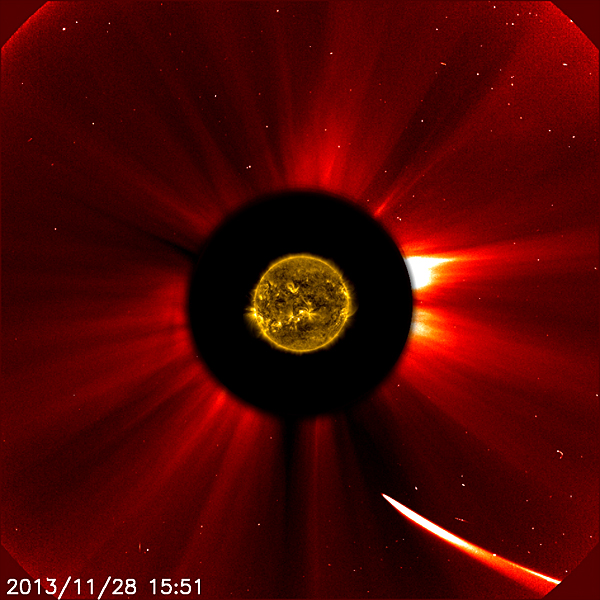 Other Stuff Touching The Sun - An
astounding phenomenon that gets almost no media attention is the
frequent visitors our Sun entertains. Turns out, she
often invites astral visitors into her parlor, but many that
fall into her clutches are never let go. Other Stuff Touching The Sun - An
astounding phenomenon that gets almost no media attention is the
frequent visitors our Sun entertains. Turns out, she
often invites astral visitors into her parlor, but many that
fall into her clutches are never let go.
Oddly, it has
been noted that she almost always throws a tantrum when her
guest arrives. These tantrums come in the form of CME's
that are apparently triggered by these sun diving comets.
The vids of these events are stunning. Also noteworthy are
a famous subset of these sun visitors known as Kreutz Sungrazers
all tied back to the breakup of a comet 326 AD.
-
List Of Kreutz Sungrazers - Wiki.
-
Sun-Diving Comet & CME - Ben Davidson / Suspicious Observers
24FEB15.
-
Sun Diving Comet Nov 25th, 2018 - Skywatcher88 25NOV18.
-
Hubble Watches Comet ATLAS Disintegrate Into More Than Two Dozen
Pieces - by Hubble, NASA, ESA D. Jewitt (UCLA), and Q. Ye
(University of Maryland) 28APR20.
-
Unusual triple comet flies past the Sun - by Julie Celestial /
The Watchers 14AUG20.
- Image: Sungrazing Comet I S O N by ESA&NASA/SOHO/SDO
(Public Domain)
Link |
|
|
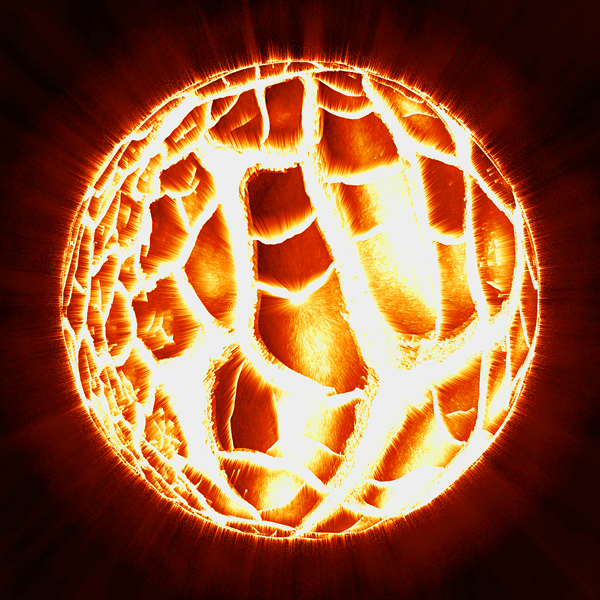 Touched
By The Sun - A classic sun theory returning to the spotlight
is that of our Sun having the capability of producing a nova
release like those observed among other stars. Resulting
cataclysms could have impacted humanity profoundly if this has
happened in relatively recent times. There are various
estimates about when the last nova might have taken place.
4,000 B.C. is a popular one correlated to the
Noah flood / Sumerian event. These events appear to be cyclical.
Confirmations of cyclical catastrophes have been published
recently lining up with a 6000 year Heinrich Bond modulation
going back several cycles. Touched
By The Sun - A classic sun theory returning to the spotlight
is that of our Sun having the capability of producing a nova
release like those observed among other stars. Resulting
cataclysms could have impacted humanity profoundly if this has
happened in relatively recent times. There are various
estimates about when the last nova might have taken place.
4,000 B.C. is a popular one correlated to the
Noah flood / Sumerian event. These events appear to be cyclical.
Confirmations of cyclical catastrophes have been published
recently lining up with a 6000 year Heinrich Bond modulation
going back several cycles.
Some theories suggest that if our sun was to go nova, a side
effect could be the destabilization of the Earth's crust.
A declassified hypothesis called The Adam and Eve
story has added intrigue to this hypothesis. Are tales of
a sun nova and/or crust displacement catastrophe interwoven into theologies and embedded in
archeological findings around the globe?
Versions of these
debates have been underway for centuries. There were so many facets,
and facets within facets, I
ended up creating a separate Lairticle page for this.
It is quite a fascinating rabbit hole
to investigate and while initially I included this as a fringe
lark, Nova discoveries in particular along with some amazing
geology findings recently are starting to dwindle my skepticism
and kindle my concern.
-
Cyclical Sun Nova Crust
Displacement - Lairticle.
- Image: Crackshelled Sun by LoganArt (Pixabay)
Link |
|
|
|
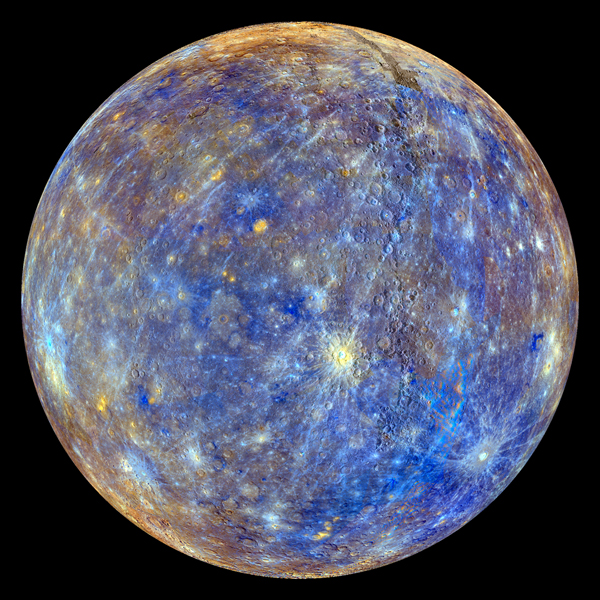 Mercury,
Breaker of Models - The existence of this extremely compact
dense ball of mostly metal whipping so closely around the Sun
continues to elude explanation as to its manner of formation and
some of its features. It has developed a reputation for
being a model breaker, for example, being the only planet that
deviates from the general trend of planets being more dense the
further away they are from the Sun. Mercury,
Breaker of Models - The existence of this extremely compact
dense ball of mostly metal whipping so closely around the Sun
continues to elude explanation as to its manner of formation and
some of its features. It has developed a reputation for
being a model breaker, for example, being the only planet that
deviates from the general trend of planets being more dense the
further away they are from the Sun.
One hypothesis is that Mercury is the leftover core from a
cataclysmic planetary crash. This is supported by the
oblong warbling orbit whipping it close and then farther from
the sun each 88 day Mercurial year. Others have suggested Mercury
might once have been a gas giant like we have been finding so
frequently near stars like ours elsewhere in the Milky Way and
that it has had it's atmosphere blown away or eaten by the Sun
leaving nothing but a metallic core. These theories aren't
mutually exclusive.
Mercury also presents an anomaly of "small hollows" scattered
across the metallic surface discovered by the Messenger probe.
Messenger ended its mission by adding its own 50 foot crater with a grand finale in
2015 slamming into the surface.
The next probe on the way to dig even deeper is Bepi Columbo
with a scheduled arrival for flyby braking starting in 2021.
In addition to examining the crater from
Messenger, when it starts the orbital science mission in 2026 BepiColumbo will investigate the mysterious hollows
and the interaction between the solar wind and Mercury's
magnetic field.
-
Mercury - NASA.
- Mercury's first visit:
Mariner 10 - NASA.
- Second probe to Mercury:
Messenger - NASA.
-
BepiColombo probe headed to Mercury - NASA.
-
Scientists discover water ice on Mercury - by Jennifer Chu /
MIT 29NOV12.
-
How Was Mercury Formed - by Nola Taylor Redd / Space.com 04OCT16.
Nice elaborate documentation of the love affair of the
mainstream with accretion theory, and how accretion alone fails
to explain much of anything about Mercury.
-
BepiColombo
Blasts Off In Pursuit Of Einstein - by Philippa Cole /
Astrobites.org 29OCT18.
-
BepiColombo
Launches This Weekend to Crack Mysteries of Mercury and Beyond
- by Meghan Bartels / Space.com 18OCT18.
-
BepiColombo Spacecraft Documents 1st Year in Space with Selfies
- by Samantha Mathewson / Space.com 25OCT19.
-
Innovative model of the dynamic magnetic field that surrounds
Mercury - by John Greenwald / PPPL 02APR20.
-
What a view! Mercury probe snaps stunning photos of our planet
during Earth flyby - by Meghan Bartels / Space.com 10APR20.
- Image: Mercury Colorized by skeeze (Pixabay)
Link
|
|
|
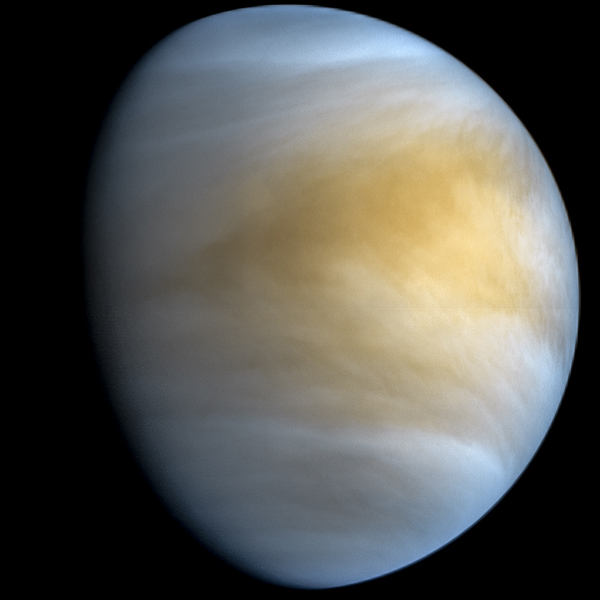 In The Clouds Of Venus - Perhaps cloud cities
are in the cards for Venus as renewed interest in the less
hellish upper atmosphere of Venus takes hold. Lando for
mayor! In The Clouds Of Venus - Perhaps cloud cities
are in the cards for Venus as renewed interest in the less
hellish upper atmosphere of Venus takes hold. Lando for
mayor!
A first step would be learning more about what's up there.
Three Venus missions have moved beyond the proposal stage. NASA is
conceptualizing a potential crewed mission to Venus
with the confidence inspiring name: HAVOC. ISRO's
Shukrayaan-1 is an orbiter/balloon mission under development
with planned launch in 2023, and Roscosmos Venera-D is an orbiter/lander slated for 2026 launch.
A small army of probes have attempted to visit Venus.
Many earlier attempts were not successful, but many more
recently have been. Mariner 2 from the US had the first
successful flyby followed by Mariner 5. Russia's Venera 4,
5 and 6 were the first to touch the clouds of Venus. This
was followed by a very hard landing with limited data from
Venera 7, and then a fully successful landing with Venera 8.
Venera 9, 10, 11, 12, 13 and 14 followed. Next came
Pioneer Venus 1 orbiter and 2 atmospheric probes which included
5 atmospheric vehicles, one of which kept transmitting after
landing. Russia next returned with Venera 15 and 16
orbiters followed by Vega 1 and Vega 2 which both dropped
atmospheric probes into Venus on the way to Halley's comet.
Magellan visited next from the US, orbiting Venus for 4 years.
Galileo, Cassini, Messenger on gravity assist flybys and the
IKAROS Solar Sail experiment all gave Venus a tip of the hat as
they cruised by. The ESA orbiter Venus Express had a
fantastic 6 year run ending in 2014. The only currently
operational probe is the
Akatsuki Japanese orbiter which
overcame a 5 year delay trying to achieve orbit after missing in
2010, finally able to nestle into place in 2015.
The fastest winds of Venus steadily increased from 185 to 250
mph from 2006-2014, so whatever does try to fly there in future
missions, or eventually tower there, needs to be made of stern
stuff indeed. The winds whip the atmosphere of Venus
around the planet up to 60 times faster than the planet itself
rotates, and the spin of the planet is also backwards compared
to most other planets. This already lackluster rotation
has been slowing even more.
How slow will it go? Well, Venus is already about as
slow as it gets. The current Venus day (sunrise to
sunrise) is 117 earth days and is the longest of any of the
major planets. The drawn out day is related to lethargic
retrograde rotation upon its axis, taking a whopping 243 earth
days for a full spin and 225 earth days for each Venus year
revolving around the sun.
The slow spin may relate to the the extremely weak magnetic
field of Venus and may also contribute to the lead-melting 880˚
F heat upon the surface. Other factors helping keep the
surface of Venus an oven include proximity to the Sun and
vast volumes of greenhouse gases. These gases generate surface pressures 90 times Earth's, roughly
equivalent to plunging 5/8 of a mile into the depths of the sea.
The greenhouse influence of this miasma does have a
counterbalance which is the fact that a fair amount of sunlight
fails to remain on Venus, which has a very healthy albedo.
Aside from the sun and the moon, from Earth, Venus is usually
the brightest thing in the sky.
-
Venus - NASA.
-
Why Venus Spins The Wrong Way - by Harald Franzen /
Scientific American 15JUN01.
-
Could Venus Be Shifting Gear? - by ESA 10FEB12.
-
Super-Hurricane-Force Winds On Venus Are Getting Stronger - by
ESA 18JUN13.
-
Zeppelins Of Mars - HAVOC on Venus: NASA's new planetary
airships - by Curious Droid (YT) 31AUG17.
-
NASA Wants To Send Humans To Venus – Here’s Why That’s A
Brilliant Idea - by Gareth Dorrian and Ian Whittaker / The
Conversation 15OCT18.
-
Wreaking HAVOC On Venus - by Isabel Kain / Nu Sci 26JAN19.
-
The Strange Case of Missing Lightning at Venus - by Meghan
Bartels / Space.com 26AUG19.
-
Venus: The hot, hellish & volcanic planet - by Charles Q.
Choi / Space.com 16JAN20.
-
Atmospheric tidal waves maintain Venus’ super-rotation - by
Takeshi Horinouchi et al. 24APR20.
-
Hello, Venus! Solar Orbiter spacecraft makes first swing past
planet - by Meghan Bartels / Space.com 27DEC20.
- Image: Venus Colored by Kevin Gill (CC2.0)
Link |
|
|
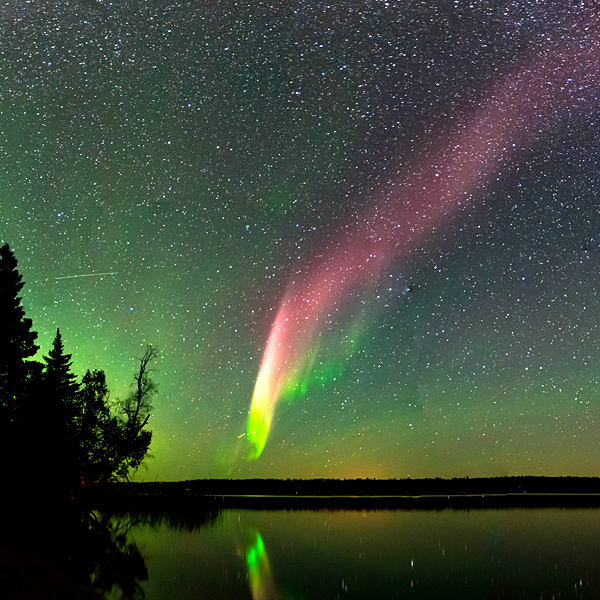 STEVE
Of Earth, And His Lovely Green Picket Fence -
Steve is a what instead of a who. Also a bit of a why. Strong Thermal Emission Velocity Enhancements
are
similar to aurora related phenomenon. The mystery
surrounding the energetic behavior of this peculiar display
generates quite a bit of study. STEVE
Of Earth, And His Lovely Green Picket Fence -
Steve is a what instead of a who. Also a bit of a why. Strong Thermal Emission Velocity Enhancements
are
similar to aurora related phenomenon. The mystery
surrounding the energetic behavior of this peculiar display
generates quite a bit of study.
Images and vids of this event are quite
stunning. Steve is the purple ribbon. His picket fence
are the green highlights cascading nearby.
-
Meet
STEVE The Aurora-Like Mystery - Sarah Lewin / Space.com 14MAR18.
-
What Powers Celestial Phenomenon STEVE - Lauren Lipuma / AGU100
25APR19.
-
A mechanism for the STEVE continuum emission - by Brian J.
Harding et al. / Geophysical Research Letters 18MAR20.
-
Observational evidence and formation mechanism of low‐density
cells in the upper thermosphere on 8 September 2017 - by
Liangliang Yuan and Shuanggen Jin / JGR Space Physics 25DEC20.
- Image: STEVE by NASA (Public Domain)
Link |
|
|
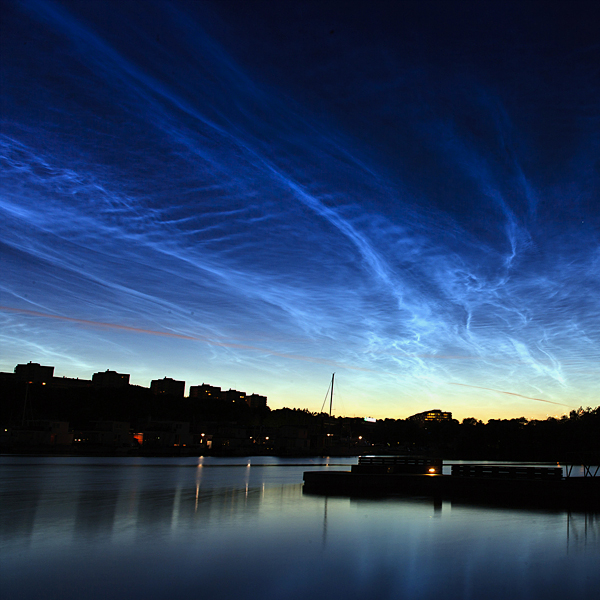 Earth's
Clouds Feeling Blue - These gorgeous luminous Noctilucent
clouds occur during the summer months at latitudes between 50°
and 70° north and south of the Equator. They are an eerie
sight that no doubt inspired many a Norse and
Aboriginal legend. Earth's
Clouds Feeling Blue - These gorgeous luminous Noctilucent
clouds occur during the summer months at latitudes between 50°
and 70° north and south of the Equator. They are an eerie
sight that no doubt inspired many a Norse and
Aboriginal legend.
Discovery of a correlation between these displays and far away weather patterns is an established phenomenon referred to as a teleconnection.
This makes this display yet another example of an
electromagnetic mechanism we don't quite understand with an
apparent climate interaction. In a convincing example, cold air temperatures on the ground in the US, were correlated with noctilucent
cloud frequencies high above Antarctica two weeks later.
Beware though, of jumping to conclusions about causation.
Is the weather in the US somehow causing these clouds 2 weeks
later in Antarctica, or is something else entirely causing both
things with a 2 week delay down under?
-
Unexpected Teleconnections in Noctilucent Clouds
- by Dr. Tony Phillips 16APR14.
-
NASA detects strange electric-blue clouds over Antarctica
- by Anthony Watts 08JAN18.
- Image: Noctilucent Clouds Stockholm by Kevin Cho (Kee Pil Cho)
(CC3.0)
Link |
|
|
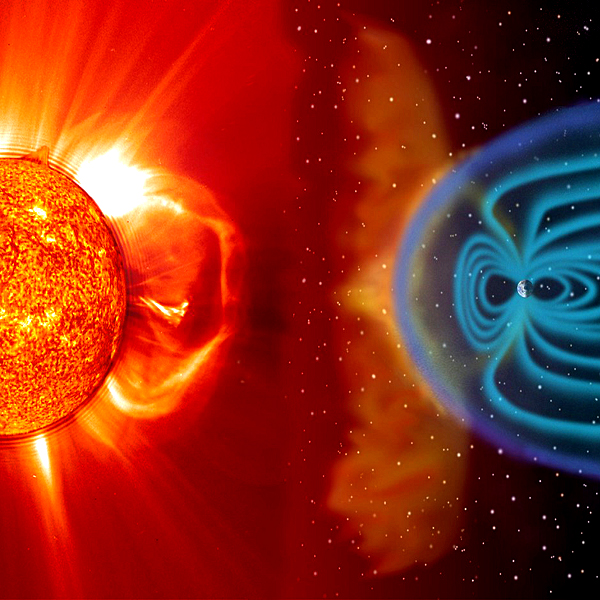 Earth's Erratic Shields
- The magnetic poles of Earth are moving. The North pole
stopped its apparently aimless meandering in 1859 and started
accelerating toward Siberia. While no cause has been proven to be driving this behavior, it is interesting that the
Carrington event solar flare took place the same year. Earth's Erratic Shields
- The magnetic poles of Earth are moving. The North pole
stopped its apparently aimless meandering in 1859 and started
accelerating toward Siberia. While no cause has been proven to be driving this behavior, it is interesting that the
Carrington event solar flare took place the same year.
The motion of the poles is having a dramatic effect upon GPS
requiring unplanned recalibration. Polar magnetic
excursions have happened before in the geologic record, possibly
with irksome side-effects like mass extinction events
correlating. And the
kicker . . . the rates of magnetic pole shift and weakening
of the magnetosphere both appear to be accelerating.
At the same time, following the recent ebb of the 11 year
solar cycle at the end of 2020, the Sun's heliosphere is
relatively
weak. This has the potential to effect many things.
Cloud cover and volcanic activity increase
considerably when cosmic ray counts rise. The
effect upon the climate could be a strong push in wetter, colder
directions. Into 2021, our star's stellar output is quickly increasing in strength through
what looks to be a vibrant adolescent
solar cycle. Unfortunately, the cycles themselves appear to
be making plans to settle into a grand solar minimum within the next
few decades. These extended periods of solar inertia have been
noted a few times over human history. They can last
many years before the Sun cranks its engines back to life.
As if this weren't enough variety in how Earth's defenses are
being put to the test, the path of our Solar System is moving us
slowly out of a magnetic dust shell shroud into a much emptier
region of space called the local bubble. (3D
Dust Mapping) This is expected to further boost cosmic
ray exposure across the board. Perhaps evolution will get
a boost from all the DNA wreckage this will encourage.
Severe genetic mutations could become the norm once we are fully
into the increased cosmic ray carnival ride.
With all of these variables, it is not hyperbole to suggest
that in terms of our geomagnetic shield, we have sailed off of
the map and are heading into unknown territory. Here's hoping
there be not too many dragons for us to encounter while our
shield's in the shop for repairs.
An avalanche of science is emerging that
demonstrates the importance of the planetary
ionosphere-magnetosphere connections to the sun and that these
energy flows extend into the ground (lithosphere) as well.
Field lines from the Sun twist and reconnect to solar objects
like the planets in patterns we are just starting to be able to
see well enough to identify. Earthquake likelihood and
severity might be modulated along with or directly by the Sun.
A fascinating subject in this arena is Earthshine.
Earth does produce its own outgoing radiation, and this is
something we've only recently started to be able to measure well
enough to find patterns. Studies demonstrating
that OLR anomalies often take place prior to major earthquakes have been
around for decades. (Pre-Earthquake
Processes: A Multidisciplinary Approach to Earthquake Prediction
Studies - by American Geophysical Union 01JUL18). Now our
improved OLR measurements are beginning to provide data needed to
make models and predictions. More granularity is needed to
improve our ability to sift through a noisy baseline and
identify these brief signals well enough to use them for
reliable warnings.
Outgoing Longwave Radiation Anomaly
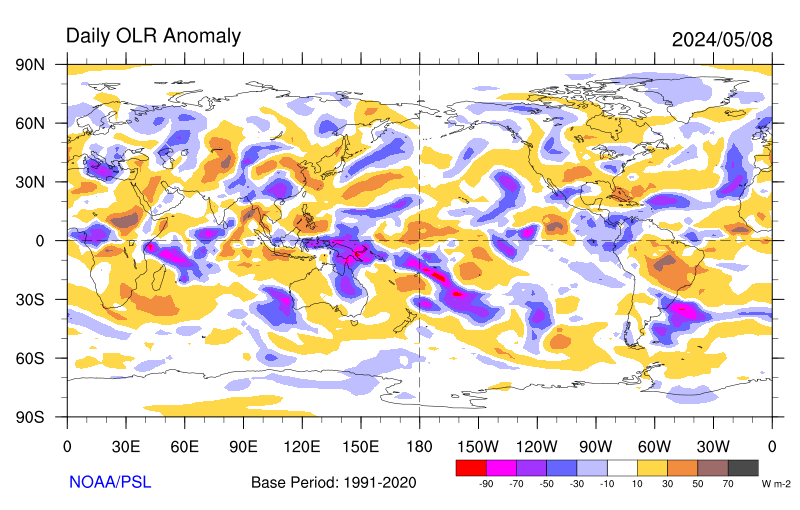
(NOAA/ESRL/PSD Service)
-
MagneticReversal.org.
- Examples of Grand Solar Minima (Maunder,
Dalton,
Spörer - wiki)
-
The Maracaibo beacon - by Agnieszka Gautier / NASA.
- A
Super Solar Flare - NASA 06MAY08. The Carrington Event
solar storm.
-
Explosive Volcanic Eruptions Triggered By Cosmic Rays
- by
Gondwana Research June 2011.
-
No link between solar activity and earthquakes - by Harriet
Jarlett / PlantetEarth Online 11APR13. A hubris soaked
assumption that the measurements being examined in this study
encompass all the relevant types of data needed to legitimately
refute the overall theory. Spoiler alert, this epic fail
is because they weren't looking for signs of this behavior in
the right kinds of measurements.
-
The never-ending lightning storm - by Alexandra Ossola /
Scienceline 25AUG14. Catabumbo.
-
This Venezuelan Lake Gets More Lightning Than Anywhere Else on
Earth - by David Nield / Science Alert 19AUG15.
-
Earth's New Lightning Capital Revealed - by Ryan Connelly /
NASA 02MAY16.
-
Tracking Changes in Earth’s Magnetic Poles - NCEI / NOAA
28MAR16.
- The
#1 Risk To Earth - by Ben Davidson / Suspicious Observers
20APR16.
-
Scientists probe lightning hotspot to predict future strikes
- by Rachel Berkowitz / Nature 15AUG16.
-
Solar Activity Has A Direct Impact On Earth's Cloud Cover by
Morten Garly Andersen 25AUG16.
-
The Heliosphere - by Holly Zell / NASA 07AUG17.
-
Current Systems in the Earth’s Magnetosphere - by N. Yu.
Ganushkina et al. / Reviews of Geophysics 08MAR18.
-
Earth's Magnetic North Pole Has Shifted So Much We've Had To
Update GPS - by Sarah Kaplan / Science Alert 06FEB19.
-
Ancient Earth’s Weakened Magnetic Field May Have Driven Mass
Extinction - by Jim Daley / Scientific American 15FEB19.
-
Weak Solar Cycle: Cosmic Rays Increase 4th Year In a Row by
Anthony Watts 21FEB19.
-
Experts Predict A Long, Deep Solar Minimum / by Dr, Tony
Phillips 10APR19.
-
The Role of Geomagnetic Field Intensity in Late Quaternary
Evolution of Humans and Large Mammals by L. Vigliotti /
Reviews Of Geophysics 29MAY19.
- Habitability decline during magnetic field reversals -
NYUAD Researcher Discovers Exoplanets Can Be Made Less Habitable
By Stars’ Flares - by NYUAD 16DEC19.
-
Earth's Magnetic North Pole Keeps Moving Towards Siberia at a
Mysteriously Fast Pace - by Peter Dockrill / Science Alert
18DEC19.
-
Ancient Australian crystals unlock history of Earth's first
magnetic field - by Rafi Letzter / Space.com 22JAN20.
-
When Plasma Streams Tie up Equatorial Plasma Irregularities with
Auroral Ones - by Zakharenkova et al. / Space Weather
05FEB20.
-
Ongoing Magnetic Excursion Triggered by the Sun - by Ben
Davidson / Suspicious Observers 25FEB20. @ 4:10 into the
SO news, Citizen scientist discovery by Tuomo Leppänen.
The 1859 Carrington event is correlated to the emergence of the
north pole excursion track.
-
Analysis of Ionospheric TEC Anomalies for Global Earthquakes
during 2000-2019 with respect to Earthquake Magnitude (Mw≥6.0)
- by Mustafa Ulukavak et al. / Journal Of Geodynamics 07MAR20.
-
The persistent ionospheric responses over Japan after the impact
of the 2011 Tohoku earthquake - by Min-Yang Chou et al. /
AGU 13MAR20.
-
Possible ionosphere and atmosphere precursory analysis related
to Mw > 6.0 earthquakes in Japan - by Munawar Shah et al. /
Remote Sensing Of Environment 15MAR20.
-
Contribution of ionospheric TEC anomalies to detecting the
seismic precursors related to the 2008 Oran-Algeria event -
by A. Tachema et al. / Science Direct 19MAR20.
-
The Polar Wind Modulated by the Spatial Inhomogeneity of the
Strength of the Earth's Magnetic Field - by Kun Li et al. /
JGR Space Physics 25MAR20. Weak magnetosphere + strong
solar activity = Earth shooting its atmosphere out the poles.
-
Ionospheric response to the June 2015 geomagnetic storm in the
South American region - by Eduardo Perez Macho et al. /
Advances in Space Research 01MAY20.
-
On the correlation between solar activity and large earthquakes
worldwide - by Vito Marchitelli et al. 05APR20.
-
The CHAOS-7 geomagnetic field model and observed changes in the
South Atlantic Anomaly - by Findley et al. / Earth Planets &
Space 20OCT20. Weakening of earth's magnetic fields
continues to accelerate.
-
Machine Learning‐Based Detection of Earthquake Precursors Using
Ionospheric Data - by A A. Akyol et al. / 17NOV20.
-
The location of the Earth's magnetic poles from
circum‐terrestrial observations - by M. Regi et al. / JGR
Space Physics 17DEC20.
-
Electrodynamical Coupling of the Geospace System during Solar
Flares - by Jing Liu et al. / JGR Space Physics 20DEC20.
-
Implementation of Ionospheric Generators in the Numerical Model
of the Global Electric Circuit - by F.A. Kuterin and N.N.
Slyunyaev / Geomagn. Aeron. 21DEC20.
-
Energy from solar wind favours the north - by ESA 12JAN21.
-
Global Magnetosphere Response to Solar Wind Dynamic Pressure
Pulses During Northward IMF Using the Heliophysics System
Observatory - by S.E. Vidal-Luengo et al. / 16JAN21.
- Image: Earth Magnetic Field A by Steele Hill / NASA (Public
Domain)
Link |
|
|
 Asteroid
Skeletons In The Moon -
Magnetic anomalies are among the most interesting features
inside our moon. One theory is that many formations are the
ancient skeletons of metallic asteroids. Moon rock samples
suggest at some point in the past, the Moon could have had a
magnetic field. If true, this is
unfortunate, because if we want humans to live for very long on
a Moon base, they really could have benefited from a magnetic
field to protect them from solar and space radiation. Asteroid
Skeletons In The Moon -
Magnetic anomalies are among the most interesting features
inside our moon. One theory is that many formations are the
ancient skeletons of metallic asteroids. Moon rock samples
suggest at some point in the past, the Moon could have had a
magnetic field. If true, this is
unfortunate, because if we want humans to live for very long on
a Moon base, they really could have benefited from a magnetic
field to protect them from solar and space radiation.
For potential moon bases exploiting Moon's internal geology, another
interesting feature has been found. Its a 50 km lunar cave that
would offer optimal protection from space radiation. It
might be a little nerve wracking to spend much time in a lunar
cave though due to the mysterious moonquakes recently discovered
rocking the moon.
A popular Moon's origin story has been that the
moon was formed after a chunk of the Earth was knocked off by an
asteroid strike. However, recent isotope evidence shows
Oxygen discrepancies suggesting that a new hypothesis may be
needed along with more study.
Recent moon missions include:
Chang'e
3 which landed in Mare Imbrium (Sea of Rains),
Chang'e 4 which visited the far side of the moon's south pole
in the Aitken Basin, and
Chang'e 5 visiting the Ocean of Storms region to collect
lunar samples. Upcoming Moon related missions and
ventures include:
Artemis,
Lunar Gateway,
Blue Moon / Blue Origin (Jeff Bezos),
dearMoon (SpaceX),
India's
Chandrayaan 3 mission is scheduled for Q2 2021 (Trying again after
Chandrayaan 2 lander Vikram crashed), Korea is also going to
give it a try with
KPLO planned for 2022
We don't have to be on the Moon for it to have an effect on
us. The Moon's stabilizing influence upon the tilt and
seasons of the Earth could have nearly as much to do with our survival
as does the light from the Sun. Some models suggest Earth would have as thin an
atmosphere as Mars without the Moon's stabilizing tidal lock.
The Moon's affect upon biology here on Earth is both subtle and profound.
Numerous creatures from sea turtles to humans time their
activities in various ways using the Moon. Lunar phases
and tides have had many biological interaction studies
indicating a connection, though some claims are hotly debated.
A popular moon myth widely gossiped about is the menstruation cycle of human females and its
similarity to the 28 day phases of the moon. It has also
long been debated whether accidents, injury rates,
and psychotic episodes ramp up for the full moon. Perhaps
there is a reason the word lunatic means what it does, but
a majority of these myths lack definitive proof.
First responders from the military, police, firefighters,
ambulance drivers, and hospital emergency room personnel generate
superstitions around full moon fever often, but closer analysis doesn't usually support it.
It is almost more curious how persistent this belief is, given
the lackluster to nonexistent relationship found
when the statistics are analyzed. Some
correlations do have more solid evidence such as the Moon's
connection to sleep cycles. However it works,
our connection to the Moon appears to be fundamental, if not
directly, at least in the blame game afterwards.
-
Earth's Moon - NASA.
-
Moon Missions - NASA.
-
We Like The Moon - by Joel Vietch / Spongmonkeys 24JAN03.
-
Earth's Stabilizing Moon May Be Unique Within Universe - by
Nola Taylor Redd / Space.com 29JUL11.
-
Magnetic Anomalies On The Moon - by Peter Reuell / Harvard
Gazette 14MAR12.
-
Origin Of Strong Lunar Magnetic Anomalies - by Hood, Richmond
& Sputis 11JUN13.
-
‘Full moon madness’ in the ER: Myth or reality? - by Laura
Selby / The DO 27OCT15.
-
It's Just a Phase: The Supermoon Won't Drive You Mad - by
Robert Roy Britt / Live Science 11NOV16.
-
How Moonlight Sets Nature’s Rhythms - by Ferris Jabr, Hakai
Magazine / Smithsonian 21JUN17.
-
Moon Facts: Fun Information About the Earth's Moon - by
Charles Q. Choi 08SEP17.
-
Discovery Of 50km Cave Raises Hopes For Human Colonisation Of
Moon - by Justin McCurry 19OCT17.
-
NASA to Return Humans to the Moon - by Jay Levine / NASA
12FEB18.
-
#dearMoon: SpaceX's 1st Passenger Flight Around the Moon Will Be
an Epic Art Project - by Sarah Lewin / Space.com 18SEP18.
-
China Lands Chang’e-4 Mission On The Far Side Of The Moon - by
Rui C. Barbosa 03JAN19.
-
NASA and China collaborate on Moon exploration - by Ivan
Couronne / Phys.org 18JAN19.
-
Surprise! Earth's Atmosphere Extends Far Beyond the Moon -
by Mike Wall / Space.com 21FEB19.
-
Israeli Lander Failure Marks 1st Moon Crash in 48 Years - by
Rafi Letzter 12APR19.
-
China On the Moon! A History of Chinese Lunar Missions in
Pictures - by Elizabeth Howell / Space.com 14JAN19.
-
Israel's Beresheet Spacecraft Crashes Into Moon During Landing
Attempt - Mike Wall / Space.com 11APR19.
-
Why oysters close on the full moon and more odd lunar effects on
animals - by Douglas Main / National Geographic 17APR19.
-
Formation of the moon brought water to Earth - by University
Of Munster / Science Daily 21MAY19.
-
Our moon — partner, protector, benefactor - by Sarah Kaplan
/ Washington Post 18JUN19.
-
China’s moon, Mars and space station missions may be facing
delays - by Andrew Jones / Spacenews 21JUN19.
-
NASA Selects 12 New Lunar Science Technology Investigations by
Grey Hautaluoma - by NASA 02JUL19. A big chunk of which
are electromagnetic in nature.
-
Moonlight shapes how some animals move, grow and even sing -
by Erin Wayman / Science News 08JUL19.
-
Angelic halo orbit chosen for humankind’s first lunar outpost
- by ESA 17JUL19. Cool video of the eccentric planned
orbit.
-
Prepare for liftoff! Here are all the moon missions happening in
the next decade - by Luke Dormehl / Digital Trends 20JUL19.
-
Who Owns the Moon? - by Frans von der Dunk (Mrs.
Grendelcat's professor) / Space.com 26JUL19.
-
Can the moon really influence your health? - by Maria Cohut,
Ph.D. / Medical News Today 09AUG19.
-
There Are Thousands of Tardigrades on the Moon. Now What? -
by Mindy Weisberger / Space.com 16AUG19.
-
Russia and China Are Teaming Up to Explore the Moon - by
Meghan Bartels / Space.com 20SEP19.
-
India's Lost Moon Lander Is Somewhere in This NASA Photo -
by Meghan Bartels / Space.com 27SEP19.
-
Astronaut to Control a Moon Robot From the Space Station -
by Chelsea Gohd / Space.com 23OCT19.
-
Does Crime Increase When the Moon Is Full? - by New York
University / SciTechDaily 29OCT19.
-
NASA invites SpaceX and Blue Origin to help with moon missions
- by Trevor Mogg / Digital Trends 18NOV19.
-
India Could Land on the Moon in 2020 with Chandrayaan 3 - by
Elizabeth Howell / Space.com 18NOV19.
-
China's Microsatellite Crash Site on the Moon Spotted by NASA
Lunar Orbiter - by Leonard David / Space.com 24NOV19.
-
NASA unveils its plans for a lander to deliver rovers to the
moon - by Georgina Torbet / Digital Trends 01DEC19.
-
Russia plans to build telescopes on the moon to protect against
asteroids - by Georgina Torbet / Digital Trends 03DEC19.
-
Moon Brightness Mystery Prompts Launch of Airborne Telescope
- by Elizabeth Howell / Space.com 10DEC19.
-
China stuck its moon landing this year. Others weren’t as lucky
- by Maria Temming / Science News 16DEC19.
-
Utilization of urea as an accessible superplasticizer on the
moon for lunar geopolymer mixtures - by Shima Pilehvar et
al. / Journal Of Cleaner Production 20FEB20. A pee base on
the moon!
-
New research conducted by UNM scientists suggests Earth and Moon
not identical oxygen twins - by University Of New Mexico
09MAR20.
-
European Gateway experiment will monitor radiation in deep space
- by ESA 13MAR20.
-
Hunting out water on the Moon - by ESA 25MAR20. 2025
mission to slam into the moon's south pole to see if there
really is a bunch of water there.
-
Trump signs executive order to support moon mining, tap asteroid
resources - by Mike Wall / Space.com 06APR20.
-
Time-travelling ESA team explore a virtual Moon - by Marc
Costa Sitjà / ESA 14APR20.
-
NASA CubeSat Will Shine a Laser Light on the Moon's Darkest
Craters - by Barbara A. Cohen et al. / JPL,NASA 27APR20.
-
China's Chang'e 5 lands on the moon to collect the 1st fresh
lunar samples in decades - by Mike Wall / Space.com 01DEC20.
-
NASA’s LRO Finds Lunar Pits Harbor Comfortable Temperatures
- by Bill Steigerwald / NASA 26JUL22.
-
Hard landing: Japan firm fails in historic Moon bid - by
Sara Hussein / Phys.org 25APR23.
- Image: Moon by David Warrington (CC2.0)
Link |
|
|
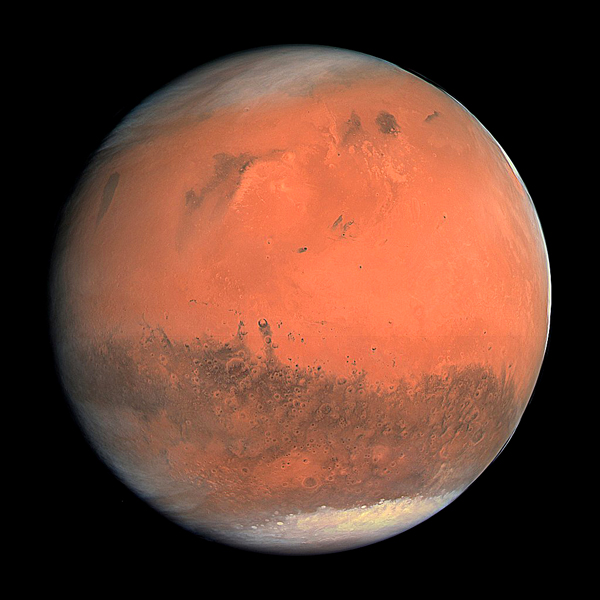 Mars Vacation Postponed Indefinitely Due To
Deadliness - Large doses of radiation, it turns out, are
harmful to humans. Without a handy geomagnetic shield of
protection around us, the universe bakes our life form to a
cancerous crisp. Mars is absent a strong magnetosphere.
While there are some sizeable local geographic
magnetic anomalies that might provide some
protection, the overall exposure to cosmic and solar radiation
on the surface of Mars is simply too much for current
technologies to handle or for regular humans to survive.
Underground lakes and caverns might provide protection and other
advantages. Interior breathable environments might
be found or made with the added bonus of providing underground
waterskiing as a thrilling recreational adventure for future
Martian colonists. Mars Vacation Postponed Indefinitely Due To
Deadliness - Large doses of radiation, it turns out, are
harmful to humans. Without a handy geomagnetic shield of
protection around us, the universe bakes our life form to a
cancerous crisp. Mars is absent a strong magnetosphere.
While there are some sizeable local geographic
magnetic anomalies that might provide some
protection, the overall exposure to cosmic and solar radiation
on the surface of Mars is simply too much for current
technologies to handle or for regular humans to survive.
Underground lakes and caverns might provide protection and other
advantages. Interior breathable environments might
be found or made with the added bonus of providing underground
waterskiing as a thrilling recreational adventure for future
Martian colonists.
There are fascinating
shielding technologies being developed for space travel as well
as for future colonies. Without major breakthroughs in energy production / storage
capabilities to power the current crop of energy intensive
solutions, or a different approach to radiation
protection, we're just not quite ready
to head out there yet. Recent observations from the
InSight rover have noted a 10x increase in the strength of the
magnetic field of the surface. Perhaps previous
measurements were inaccurate, or possibly the field strength is
actually strengthening and Mars is working up some welcoming
shielding for us. If it is increasing, it still has a long
way to go to offer enough protection for humans so for now, orbiters, landers and rovers
must
attempt the visit in our stead.
Mars has two moons for now,
Phobos and
Deimos. Unless
something changes in the trajectory of Phobos, Mars will only
have Deimos in about 50 million years after Phobos crashes into
Mars. Mars surface gravity is only 38% of Earth's
so a game of basketball would be quite something to see. The hoop would have to
hang much higher or the ball would have to be much heavier to
keep things similar. While days on Mars are of similar
length to Earth at 24.6 hours, the year is longer
at about 670 days. The average temp there is
about -80˚ F so we'll
want to bring a jacket, and some air too, since the thin Martian
atmosphere is not optimal for humans at 95% CO2.
Some goggles might be a good plan since sand storms on
Mars can be very widespread, although with wind speeds
maxing out around 60 MPH - they aren't quite as bad as Hollywood
typically portrays. Another gas found occasionally on Mars is methane.
Methane can be produced in natural processes, but the
distributions look to some more like a signature
of life.
Checking for water on Mars has been a focal point of many
missions. Mysteries about the polar ice caps and
sublimation, mars seasonal cycles, and the relationship between
Mars lackluster magnetism and loss of water vapor
to space are among the top avenues of exploration.
Modeling this behavior has been uniquely challenging, with each
new observation requiring new models. Most recently the
new models are attempting to explain the tremendous saturation
of the upper atmospheric and the apparently enormous ongoing
loss of water to space. Other recent focus has been upon
the mysteries around Martian seismic activity. The
increasingly anomalous nature of this data seems to be going out
of its way to defy modeling.
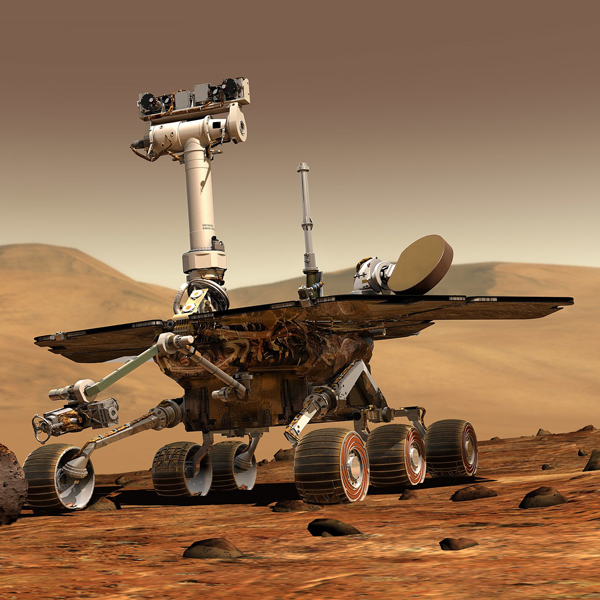 Mars has entertained a crowd of
earthly robotic visitors over the years. Not many of the
early travelers made it the distance. But if at first you don't
succeed . . . try try try again. Tries: Marsnik 1 (Launch
fail), Marsnik 2 (Launch fail), Sputnik 22 (Destroyed hitting
orbit), Mars 1 (Lost comms), Sputnik 24 (Crashed back to Earth),
Mariner 3 (Lost power), Mariner 4 (Successful flyby), Zond 2
(Lost comms), Mars 1969A (Launch fail), Mars 1969B (Launch
fail), Mariner 8 (Launch fail), Kosmos 419 (Lost in transit),
Mars 2 Orbiter (Success), Mars 2 Lander (Crashed on Mars), Mars
3 Orbiter (Success), Mars 3 Lander (Lost comms), Mariner 9
Orbiter (Success), Mars 4 (Missed Mars), Mars 5 (Died hitting
Mars Orbit), Mars 6 Flyby (Success), Mars 6 Lander (Crashed on
Mars), Mars 7 Flyby (Success), Mars 7 Lander (Missed Mars),
Viking 1 & 2 each with orbiter and lander (Success). Finally. Mars has entertained a crowd of
earthly robotic visitors over the years. Not many of the
early travelers made it the distance. But if at first you don't
succeed . . . try try try again. Tries: Marsnik 1 (Launch
fail), Marsnik 2 (Launch fail), Sputnik 22 (Destroyed hitting
orbit), Mars 1 (Lost comms), Sputnik 24 (Crashed back to Earth),
Mariner 3 (Lost power), Mariner 4 (Successful flyby), Zond 2
(Lost comms), Mars 1969A (Launch fail), Mars 1969B (Launch
fail), Mariner 8 (Launch fail), Kosmos 419 (Lost in transit),
Mars 2 Orbiter (Success), Mars 2 Lander (Crashed on Mars), Mars
3 Orbiter (Success), Mars 3 Lander (Lost comms), Mariner 9
Orbiter (Success), Mars 4 (Missed Mars), Mars 5 (Died hitting
Mars Orbit), Mars 6 Flyby (Success), Mars 6 Lander (Crashed on
Mars), Mars 7 Flyby (Success), Mars 7 Lander (Missed Mars),
Viking 1 & 2 each with orbiter and lander (Success). Finally.
Through the 90's a string of additional missions continued
but these were not all stellar performances either. The tremendously
expensive
Mars Observer was lost in transit. Russia kept
trying too, but
Mars 96
suffered yet another launch fail. Soldiering on, we
started to see an upturn.
Mars Global
Surveyor was a tremendous success story extending the
mission well beyond expected lifespan. More wins came with the
Pathfinder and Sojourner rover
missions. Lest we forget how hard this can be, we next had the
Mars Climate Orbiter
burned
up in the Martian sky and the
Mars Polar Lander
crashed on the surface.
This century's
Odyssey
became the longest serving spacecraft thus far, and the
Spirit and
Opportunity
rover
missions wildly surpassed expectations. Then ESA also gave Mars a shot with
Mars Express /
Beagle 2 which had a
successful orbiter mission, but lost the lander. The
Mars
Reconnaissance Orbiter has returned more Mars data than all
other missions combined.
Phoenix
came next and turned in 6 months of science before the Martian
winter destroyed its solar panels. The Russians gave it
another try shepherding a Chinese lander
Yinhuo-1
on the
Phobos-Grunt
mission, but
this crashed before leaving Earth's orbit.
This brings us to the recent and still active missions.
Tianwen-1 from China landed the tiny Zhurong rover
successfully in 2021 capturing sights and sounds from the red
planet for a successful mission. NASA's
InSight
rover finished successful surface operations ending ops in
December 2022.
Curiosity
continues roving into uncharted territory having long finished
its original mission, now just out doing some sight seeing.
The
Perseverance rover achieved successful touchdown in 2021 and
has been diligently gathering snapshots and samples.
Keeping Perseverence company, the first Martian helicopter,
Ingenuity, has been stretching its rotors learning how to fly on
Mars making dozens of test flights. India's
MOM orbiter recently completed a successful run in 2022.
In active orbit missions, we have
MAVEN
continuing extended operations from Boulder, CU, and the ESA's
Trace Gas Orbiter which has been on station since 2018.
The ESA
ExoMars Rosalind
Franklin Rover is being prepared for a 2028 launch
developing expert drilling skills in plans to dig deeper than
ever before in the search for evidence of life on Mars.
-
Mars - NASA.
-
Mars Atmosphere Is Supersaturated With Water - by ESA /
Astrobiology 02OCT11.
-
Beagle-2 lander found on Mars - by ESA 16JAN15
-
A Superconducting Shield for Astronauts
- by Antonella Del
Rosso / CERN 09SEP15.
-
The Fact and Fiction of Martian Dust Storms - by Kathryn
Mersmann / Goddard 18SEP15.
-
Mars Global Surveyor: A New Generation of Space Probes - by
Elizabeth Howell / Space 11APR16.
-
Red Planet Heats Up: Ice Age Ending on Mars - by Charles Q.
Choi / Space.com 26MAY16.
-
How bad is the radiation on Mars?
- by Matt Williams / Phys.org 21NOV16.
-
NASA Wants to Launch a Giant Magnetic Field to Make Mars
Habitable - by Peter Dockrill / Science Alert 06MAR17.
-
And Then Silence: 25 Years Since the Rise and Fall of Mars
Observer - by Ben Evans / America Space 24SEP17.
-
Mars Express Detects Liquid Water Hidden Under Planet’s South
Pole - by the European Space Agency 25JUL18.
-
Water on Mars: Exploration & Evidence - by Nola Taylor Redd
/ Space.com 18AUG18.
-
Travelling to Mars and deep into space could kill
astronauts by destroying their guts - by Andrew Griffin / The
Independent 02OCT18.
-
A Brief History of Mars Missions - by Elizabeth Howell /
Space 08APR19.
-
New water cycle on Mars discovered - by Max Planck Society /
Phys.org 10MAY19.
-
A Giant Hole in the Martian Atmosphere Is Venting All Its Water
into Space - by Rafi Letzter / Live Science 13MAY19.
-
China’s first Mars spacecraft undergoing integration for 2020
launch - by Andrew Jones / Spacenews 29MAY19.
-
Mars' Mysterious, Intense Dust Storms Appear to Be Cyclical
- by Evan Gough / Universe Today 18JUN19.
-
NASA Rover on Mars Detects Puff of Gas That Hints at Possibility
of Life - by Kenneth Chang / New York Times 22JUN19.
-
Dust storms swirl at the north pole of Mars - by /ESA
04JUL19.
-
I’m Convinced We Found Evidence of Life on Mars in the 1970s
- by Gilbert V. Levin / Scientific American 10OCT19.
-
The Debate Over Whether We’ve Already Found Life on Mars,
Continued - by Dirk Shulze-Maruch / Airpsacemag 23OCT19.
-
The Mars 2020 rover will visit the perfect spot to find signs of
life - by Sarah Kaplan / Washington Post 16NOV19.
-
Bold space mission to bring back rocks from Mars takes shape
- by Daniel Clery, Paul Voosen / Science 21NOV19 - Europe's
planned Earth return orbiter.
-
Global Storms on Mars Launch Dust Towers Into the Sky - by
NASA 26NOV19
-
‘Marsquakes’ reveal red planet’s hidden geology - by
Alexandra Witze / Nature 13DEC19.
-
The Last Mars Panorama Sent by Opportunity Is So Beautiful We
Could Cry - by Mike McRae / ScienceAlert 24DEC19.
-
China launches powerful rocket in boost for 2020 Mars mission
- by Jing Xuan Teng / Phys.org 27DEC19.
-
NASA's Mars 2020 Rover Completes Its First Drive - by NASA
28DEC19.
-
NASA's New Mars 2020 Car May Look Like the Curiosity Rover, But
It's No Twin - by Elizabeth Howell / Space.com 03JAN20.
-
Mars Loses Its Water Even Faster Than Anyone Thought - by
Charles Q. Choi / Space.com 09JAN20.
-
Mars' water was mineral-rich and salty - by Fukushi et al. /
Tokyo Tech News 23JAN20.
-
Mystery at Mars pole explained - by California Institute of
Technology / Phys.org 29JAN20.
-
Magnetic field at Martian surface ten times stronger than
expected - by UBC News / NASA 24FEB20.
-
The dark dunes of Mars: Moreux crater - by ESA / Mars
Express 05MAR20.
-
Study finds organic molecules discovered by Curiosity Rover
consistent with early life on Mars - by Sara Zaske / WSU
05MAR20.
-
Super high frequency events: a new class of events recorded by
the InSight seismometers on Mars - by Nikolaj L. Dahmen et
al. / AGU 28OCT20. Mars quake changes becoming more
anomalous as they continue to increase.
-
Powerful electrical events quickly alter surface chemistry on
Mars and other planetary bodies - by Shawn Ballard /
Washington U. in St. Louis 14DEC20.
-
Dreaming of a red Christmas: Festive features spotted near Mars’
south pole - by ESA 17DEC20.
-
A mysterious 'wobble' is moving Mars' poles around - by
Brandon Specktor / Space 10JAN21. Related to the increase
in quakes maybe?
-
Touchdown! NASA's Perseverance rover lands on Mars to begin hunt
for signs of ancient life - by Mike Wall / Space.com
18FEB21.
-
HKU geologist proposes the number of ancient Martian lakes might
have been dramatically underestimated by scientists - by
University Of Hong Kong 16SEP22.
- 1st Image: Mars Osiris by European Space Agency (CC3.0)
Link
- 2nd Image: Mars Rover by NASA (Public Domain)
Link |
|
|
|
 Surfin' Jupiter's Cloudwaves - It appears that
the upper atmosphere of Jupiter behaves a lot more like the
surface of an ocean than clouds as we know them on Earth, with
dynamic wave behaviors on the surface. This is just one of
numerous revelations from the
Juno
mission. Juno took a close look at Jupiter's poles, and
the results were described as being "like nothing we had ever
seen or imagined before" - Scott Bolton, mission leader.
Symmetric storm clusters thousands of miles wide dance and whirl
in astounding lightning punctuated patterns. The lightning
seemed to have a preference for the north pole adding a new
mystery. Surfin' Jupiter's Cloudwaves - It appears that
the upper atmosphere of Jupiter behaves a lot more like the
surface of an ocean than clouds as we know them on Earth, with
dynamic wave behaviors on the surface. This is just one of
numerous revelations from the
Juno
mission. Juno took a close look at Jupiter's poles, and
the results were described as being "like nothing we had ever
seen or imagined before" - Scott Bolton, mission leader.
Symmetric storm clusters thousands of miles wide dance and whirl
in astounding lightning punctuated patterns. The lightning
seemed to have a preference for the north pole adding a new
mystery.
Juno also peered hundreds of miles into Jupiter's atmospheric
layers finding that the stripes go deep. Said Bolton,
"Whatever's making those stripes, is still existing pretty far
down into Jupiter." Juno also found Jupiter to have
off-kilter gravity with slightly higher pull in the northern
hemisphere. Jupiter's magnetic field is also wonky and 2x
stronger than expected. The auroras were 10x-30x stronger
than expected. Juno also took a gander at Jupiter's moon
Io and found yet another volcano to add to the 150 identified of
the expected 400 needed to explain Io's sulfurous atmosphere.
Jupiter is our solar system's largest planet.
It is 2x the mass of all other planets combined. Jupiter
has a surprisingly fast rotation with just a 10 hour day over
its 12 year trip around the sun. Electrons whipping around
the equator are juiced up nearly to the speed of light.
Jupiter is kept company by 4 large moons, sometimes visible using a small
telescope or even a pair of binoculars:
Io,
Europa,
Ganymede, and
Callisto. Another 75+
smaller moons provide a lively Jovian audience.
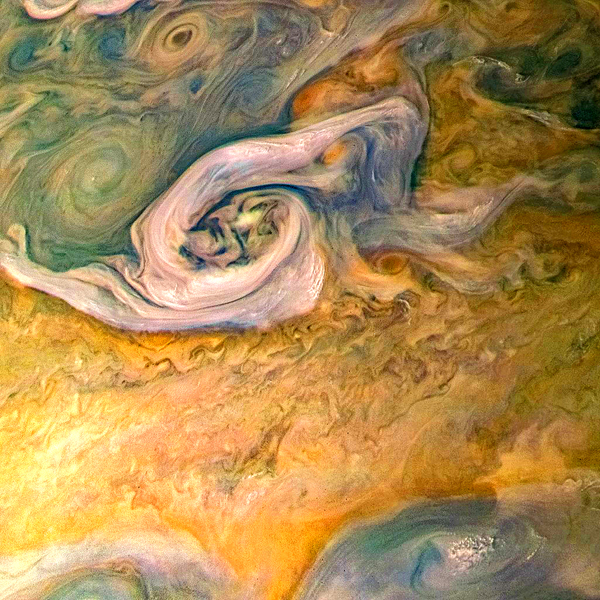 Jupiter has been a popular pit stop for
probes snatching a required slingshot heading to other
destinations. Prior missions included
Pioneer 10 (Heading out of solar system toward Aldeberan,
lost comms in 2003),
Pioneer 11 (Headed toward center of galaxy, lost comms in
1995),
Voyager 1 (Heading out of solar system, most distant manmade
object),
Voyager 2 (Studying the border of the heliosphere),
Galileo (First dedicated Jupiter probe, dropped an
instrument pack into Jupiter),
Ulysses (Slingshot around Jupiter so it could orient to and
study the poles of the Sun),
Cassini-Huygens (Flyby heading to Saturn) and
New Horizons (Flyby heading to Pluto). Jupiter has been a popular pit stop for
probes snatching a required slingshot heading to other
destinations. Prior missions included
Pioneer 10 (Heading out of solar system toward Aldeberan,
lost comms in 2003),
Pioneer 11 (Headed toward center of galaxy, lost comms in
1995),
Voyager 1 (Heading out of solar system, most distant manmade
object),
Voyager 2 (Studying the border of the heliosphere),
Galileo (First dedicated Jupiter probe, dropped an
instrument pack into Jupiter),
Ulysses (Slingshot around Jupiter so it could orient to and
study the poles of the Sun),
Cassini-Huygens (Flyby heading to Saturn) and
New Horizons (Flyby heading to Pluto).
The ESA's
Juice mission has launched and is on the way for a July,
2031 arrival target. Another planned mission is NASA's
Europa
Clipper,
scheduled for an October 2024 launch targeting an earlier April
2030 Jupiter orbit insertion.
-
Jupiter - NASA.
-
Junocam - Citizen science project and Juno image library.
-
The source of radiation from Jupiter at decimeter wavelengths
- by George B. Field June, 1960.
-
Io Creates Spots on Jupiter - by Charles Q. Choi / Space.com
17MAR08.
-
Big Mystery: Jupiter Loses a Stripe - by Dr Tony Phillips /
NASA 20MAY10.
-
Jupiter's Missing Cloud Stripe Bounces Back Big Time - by
Space.com 25NOV10.
-
Target: Jupiter - Missions to the Solar System's Largest Planet
- by Clara Moskowitz / Space.com 04AUG11.
-
Now Broadcasting From Radio Jupiter - by News Staff /
Scientific Blogging 27AUG12.
-
Looking at Jupiter's radio frequencies - by Brian Koberlein,
One Universe at a Time / Phys.org 10SEP14.
-
What's Powering Auroras on Jupiter? NASA's Juno Probe Finds
Puzzling Clues - by Calla Cofield / Space.com 06SEP17.
-
NASA Juno Findings - Jupiter’s Jet-Streams Are Unearthly -
by DC Agle / JPL,Dwayne Brown / Laurie Cantillo / NASA 07MAR18.
-
A dozen new moons of Jupiter discovered, including one “oddball”
- by Carnegie Science 16JUL18.
-
Jupiter or Earth? [Storm pattern similarities] - by Kathryn
Hansen / Earth Observatory 18JUL18.
-
NASA's $1 billion Jupiter spacecraft is probing the planet's
deepest secrets — here are Juno's biggest discoveries so far
- by Dave Mosher / Business Insider 17SEP18.
-
Juno Sees Mega-waves On Jupiter - by Cosmosmagazine 26OCT18.
-
NASA Probe Captures Insanely Gorgeous And Moody New Photos of
Jupiter - by Evan Gough / Science Alert 01JUL19.
-
Hubble's New Portrait of Jupiter - by Claire Andreoli et al.
/ Goddard - Hubble 08AUG19.
-
Jupiter: Our Solar System's Largest Planet - by Charles Q.
Choi / Space.com 09AUG19.
-
Incredible Views of Jupiter From NASA's 'JunoCam' - by
VideoFromSpace / YT 22SEP19.
-
Astronomers Measure Wind Speed on a Brown Dwarf - by Katelyn
Allers / Bucknell / NRAO / Spitzer 09APR20. Take a planet
the same size as Jupiter with 40x the theoretical mass.
Then add some super fast surface wind rotation and voila, you've
got a brown dwarf.
-
NASA's Juno Spacecraft Updates Quarter-Century Jupiter Mystery
- by DC Agle et al. / NASA 11DEC20. The brownish stripes
are dry like deserts, and create "breaks in the cloud deck,
providing a glimpse into Jupiter's deep atmosphere."
-
Scientists stumped by strange polygon-shaped cyclones on Jupiter
- by Patrick Reilly / NY Post 22SEP22.
- 1st Image: Jupiter by Hubble (Public Domain)
Link
- 2nd Image: Jupiter Storm by Kevin Gill (CC2.0)
Link
|
|
|
 The
Baffling Face Of Icy Europa - Europa's surface could look like Hellraiser's Pinhead up close
covered with yard-long spikes of ice, which is
likely to make landings for exciting life-searching missions
quite a bit more tricky. The Europa Clipper mission planned for launch in the 2020's
should be able to provide oodles more info and probably many new
surprises, though the prospect of including a lander for this
mission to drill into the ice and see what's beneath may have to
be reconsidered.
There are also complexities landing without contaminating the
environment to be studied. The
Baffling Face Of Icy Europa - Europa's surface could look like Hellraiser's Pinhead up close
covered with yard-long spikes of ice, which is
likely to make landings for exciting life-searching missions
quite a bit more tricky. The Europa Clipper mission planned for launch in the 2020's
should be able to provide oodles more info and probably many new
surprises, though the prospect of including a lander for this
mission to drill into the ice and see what's beneath may have to
be reconsidered.
There are also complexities landing without contaminating the
environment to be studied.
As if shards of ice and contamination weren't enough, there are
also geyser plumes bursting occasionally from the surface which
also present their own mystery by somehow doing this without
generating expected heat signatures.
-
Europa - NASA.
-
NASA's Europa Lander May Drill To Find Pristine Samples On Icy
Moon - by Mark D. Kaufman / Space.com 26DEC16.
-
NASA Mission Named Europa Clipper - by Tony Greicius / NASA
06AUG17.
-
Signs
of Life On Europa May Be Just Beneath The Surface - by Mike
Wall / Scientific American 23JUL18.
-
Formation Of Metre-scale bladed Roughness On Europa’s Surface By Ablation Of
Ice - by Daniel E. J. Hobley / Nature Geoscience 08OCT18.
-
Why Don’t Europa’s Plumes Have Heat Signatures? - by Paul
Scott Anderson / Space 29OCT18.
-
Reprocessed Images of Europa Show 'Chaos Terrain' in Crisp
Detail - by NASA / JPL 01MAY20.
- Image: Europa by NASA/JPL-Caltech/DLR (Public Domain)
Link |
|
|
 Saturn's Premature Coronation - The hexed crown
of Saturn, otherwise known as the mysteriously regular 30
year hexagonal Saturnian polar storm, appeared with clock-like
regularity until the last cycle when it woke up a decade early.
It is uncertain why we saw this wake-up call change, nor is
there a clear explanation for the genesis of the 30 year storm
itself. These early storms kicked off
while the Sun was throwing regular CMEs at Saturn during sunspot
maximum, so that is a plausible explanation. Saturn's Premature Coronation - The hexed crown
of Saturn, otherwise known as the mysteriously regular 30
year hexagonal Saturnian polar storm, appeared with clock-like
regularity until the last cycle when it woke up a decade early.
It is uncertain why we saw this wake-up call change, nor is
there a clear explanation for the genesis of the 30 year storm
itself. These early storms kicked off
while the Sun was throwing regular CMEs at Saturn during sunspot
maximum, so that is a plausible explanation.
Saturnian mysteries abound. Even the exact length of a
Saturn day remains elusive. In addition to the mesmerizing
cloud cover, Saturn is shrouded in noisy seasonally shifting
radio emission patterns that have thwarted precise measurements
of Saturn's rotation. The best guess is Saturn has a 10.7
hour day similar to Jupiter's.
Saturn has a 29 year orbit, and shares these travels with
82+ moons. The largest moon is
Titan which is larger than planet Mercury and makes up 96%
of the mass orbiting Saturn. It is the only moon in the
solar system with a significant atmosphere. Tidally locked
Dione is a bit of a circus freak. One side is pocked
with deep craters, and the other side youthfully smooth.
Highly reflective
Enceladus shines like a mirror and has hundreds of geysers
near its south pole. These geysers helpfully spew out
samples from the liquid oceans of Enceladus which look to
possess most of the ingredients needed for life, making Enceladus a prime candidate for future missions. Other
major moons include the spongy
Hyperion,
Iapetus with a geologically active surface
including a 50 mile landslide, the death star moon
Mimas, a fluffy snowball called
Rhea, and finally
Tethys which has a huge trench running from north to south
pole and very strange red arc surface features.
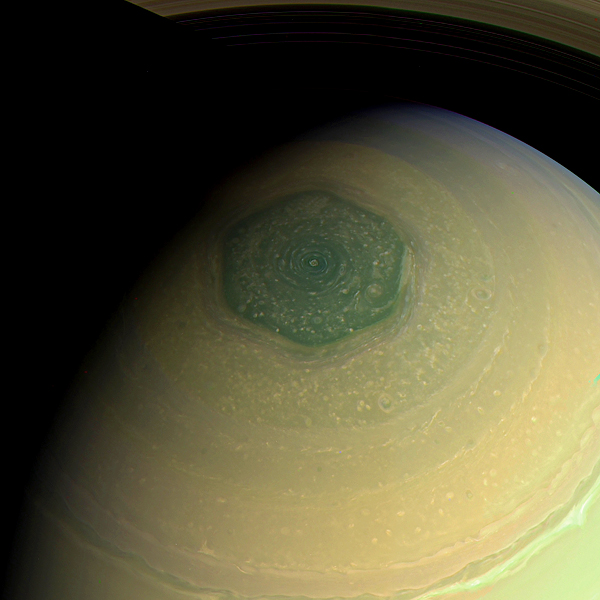 Saturn has entertained few passing earthly
travelers and only one that stopped for a visit. But she's
put on quite a show for those that made the trek. Flyers
by:
Pioneer 11,
Voyager 1 and
Voyager 2. Our sole visitor
Cassini, came along with
Huygens for a 14JAN05 Titan landing. Saturn has entertained few passing earthly
travelers and only one that stopped for a visit. But she's
put on quite a show for those that made the trek. Flyers
by:
Pioneer 11,
Voyager 1 and
Voyager 2. Our sole visitor
Cassini, came along with
Huygens for a 14JAN05 Titan landing.
Dragonfly is to be the next mission to the Saturn planetary system
with a focus on Titan. It is planned for a 2026 launch and
2034 arrival. Another proposed mission is
TSSM. This one had to wait in line for Jupiter's
Juice
mission, but it is still being pursued.
-
Saturn - NASA.
-
Huygens: the top 10 discoveries at Titan - ESA.
-
The Greatest Mysteries of Saturn - by Adam Hadhazy / Live
Science 01AUG11.
-
50-Mile Landslides Spotted on Saturn's Icy Moon - by Nola
Taylor Redd / Space.com 30JUL12.
-
Cassini Spacecraft Reveals Unprecedented Saturn Storm
- by John Matson / Scientific American 17JAN13.
-
These Weird Red Arcs on Saturn's Moon Tethys Can't Be Explained
- by Elizabeth Howell / Space.com 04AUG15.
-
Bizarre Giant Hexagon on Saturn May Finally Be Explained
- by
Charles Q. Choi / Space.com 22SEP15. Buckets?
- Hexed
Crown - by Sentient Cement / Grendelcat Lair demo. Song inspired by Saturn's polar
storm and the above Charles Q. Choi article in particular.
Sorry Charles. This is what happens when drummers get
a-hold of science articles. Recorded here at the
Grendelcat Lair by Sentient Cement.
-
Solar system mysteries: What's inside Saturn? - by Stephen
Battersby / New Scientist 20JAN16.
-
Enceladus: Saturn's Tiny, Shiny Moon - by Nola Taylor Redd /
Space.com 24JUN16.
-
Hyperion: Saturn's Spongy Moon - by Nola Taylor Redd /
Space.com 27JUN16.
-
Iapetus: Saturn's Yin-Yang Moon - by Nola Taylor Redd /
Space.com 27JUN16.
-
Mimas: Saturn's Death Star Moon - by Nola Taylor Redd /
Space.com 29JUN16.
-
Tethys: Saturn's Icy Moon - by Nola Taylor Redd / Space.com
30JUN16.
-
Titan Touchdown - by NASA/JPL / YT 11JAN17. Short
movie of Huygens 2005 touchdown.
-
The Biggest Mysteries of Saturn - by Elizabeth Howell /
Space.com 08SEP17.
-
Back to Saturn? NASA Eyes Possible Return Mission as Cassini
Ends - by Mike Wall / Space.com 17SEP17.
-
Saturn’s Hexagonal Storm Mysteriously Changes From Blue to Gold
- by Dom Galeon / Futurism 25OCT16.
-
Dione: Saturn's Turned-Around Moon - by Nola Taylor Redd /
Space.com 24AUG18.
-
Saturn Sprouts Another Weird Hexagon, Puzzling Scientists
- by Kimberly Hickok / Live Science 05SEP18.
-
Saturn's Hexagon in Motion - by Cassini / NASA 07SEP18.
-
Unsolved Mysteries Of Saturn's Moons - by Lonnie Shekhtman /
NASA 28MAY19.
-
NASA's Cassini reveals New Sculpting in Saturn Rings - by
NASA 17JUN19.
-
NASA's Dragonfly Will Fly Around Titan Looking for Origins,
Signs of Life - by Grey Hautaluoma / Alana Johnson / NASA
27JUN19.
-
NASA Is Sending a Life-Hunting Drone to Saturn's Huge Moon Titan
- by Mike Wall / Space.com 27JUN19.
-
Saturn's Strange Magnetic Field Could Make Its Insides Flow Like
Honey - by Kristin Houser / Futurism 29AUG19.
-
Data From NASA's Cassini May Explain Saturn's Atmospheric
Mystery - by NASA/JPL 06APR20.
- 1st Image: Saturn by Hubble (Public Domain)
Link
- 2nd Image: Saturn Hexstorm E by Kevin Gill (CC2.0)
Link |
|
|
|
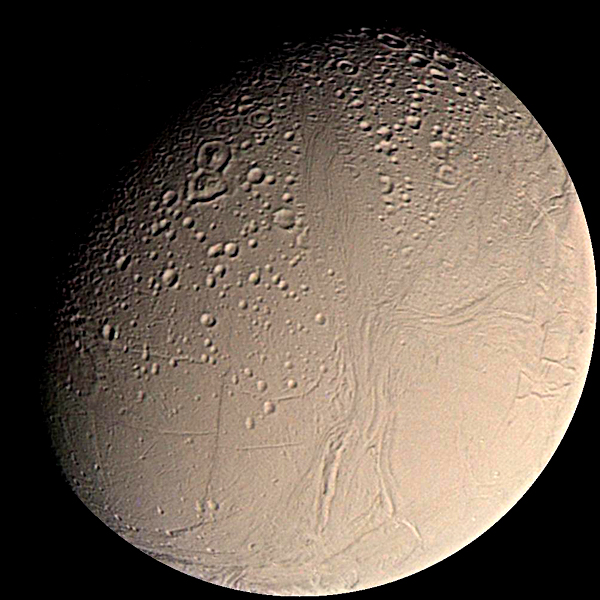 The Sizzling Energy Around Enceladus - 97% of
the electrical energy flowing betwixt the moon Enceladus and its
planet Saturn was invisible to detection until we flew through
it. A massive boon to the plasma theory proponents was this
finding as it supports their contention that electric
fields and charged particle flows in space can avoid detection. The Sizzling Energy Around Enceladus - 97% of
the electrical energy flowing betwixt the moon Enceladus and its
planet Saturn was invisible to detection until we flew through
it. A massive boon to the plasma theory proponents was this
finding as it supports their contention that electric
fields and charged particle flows in space can avoid detection.
Enceladus is among the most likely place in our solar system
where extraterrestrial life might be found hiding in the icy
oceans beneath those spectacular south pole geysers.
-
Enceladus - NASA.
-
Where Are the Electrical Currents in the Enceladus Plume?
- by Mark Zastrow / EOS 07JUL17.
- Enceladus Habitable:
New SwRI Models Reveal Inner Complexity Of Saturn Moon - by
SwRI 22JAN20.
- In some ways more habitable than Earth:
SwRI models point to a potentially diverse metabolic menu at
Enceladus - by SwRI 16DEC20.
-
New evidence for habitability in Enceladus’s ocean - by SwRI
19SEP22.
- Image: Enceladus by NASA (Public Domain)
Link
|
|
|
 Flippin' Uranus - Something just ain't right
with Uranus. And no, this is not a colonoscopy advert.
Uranus presents a number of unusual deviations from the
rest of its solar kin. Rather than spinning like a dervish
as other planets do, Uranus rolls like a
ball. As it tumbles, it rotates on its side and its poles flip.
This is a lot of flipping with a Uranus day being only a quarter
past 17 hours long over its 84 year year. One theory is
that a large body impacted Uranus. Sorry about how that
sounds. The resulting crash hypothetically bonked Uranus
sideways causing a 98˚ tilt. Flippin' Uranus - Something just ain't right
with Uranus. And no, this is not a colonoscopy advert.
Uranus presents a number of unusual deviations from the
rest of its solar kin. Rather than spinning like a dervish
as other planets do, Uranus rolls like a
ball. As it tumbles, it rotates on its side and its poles flip.
This is a lot of flipping with a Uranus day being only a quarter
past 17 hours long over its 84 year year. One theory is
that a large body impacted Uranus. Sorry about how that
sounds. The resulting crash hypothetically bonked Uranus
sideways causing a 98˚ tilt.
The most unusual thing about Uranus is
it's abnormal frigidity. Unlike the other giants Saturn,
Jupiter and Neptune, Uranus emits almost no heat of its own.
There are theories about why, but none are widely accepted. One might think that with all the activity
involved with daily pole shifts, more heat would be generated.
Yet the only behaviors observed that correlate with significant
atmospheric heat increases are the occasions when the surface of
Uranus breaks out in massive storms, the causes of which are
also a mystery. A lack of moons to push and pull some
energy into the system is not the issue either.
Uranus has a whopping 27 moons all given Shakespearian names,
all arrant thieves whose pale fire is snatched from
the sun.
Thus far, only
Voyager 2 has visited Uranus in a flyby.
The Grendelcat taps Uranus as the most likely planet where
life will be found after all. Taking a walk on the wild
and crazy side yes. Completely original? No idea.
Haven't checked. I think it is and if I check, I'll be
poisoned by someone else's sci-fi.
Hypothesis: An advanced something-or-other . . . insert your
favorite History Channel of myths myth maybe? God. Greek . . .
Roman . . . any other ancient cultures? Those weird things
from 5th Element . . . something is surely under
that cloud shield. And that something being smart enough
to mess with the roll of the planet and/or to be capturing and
harnessing the planet's radiation is an
interesting possibility about how all of these oddities
could be happening . . . in my greedy opinion. (See
The Uranution Revolution for
details)
-
Uranus - NASA.
-
What Caused The Sudden Heating Of Uranus's Atmosphere?
- by J.
Wendel / EOS 13JAN16.
-
Record Breaking Storm Activity On Uranus In 2014 - by Pater
et al 16JAN15.
-
Mysterious Uranus And Why We Need To Put An Orbiter Around It
-
by Jatan Mehta / TeamIndus Moon Mission 23SEP17.
-
Cosmic Crash That Knocked Uranus Sideways Also Made Its Moons
- by Charles Q. Choi / Space.com 18DEC17.
-
Revisiting Decades-Old Voyager 2 Data, Scientists Find One More
Secret - by Miles Hatfield / NASA 25MAR20. It seems
Voyager cruised through a blob of stuff. Their best guess
is this was a chunk of Uranus's atmosphere stripped away by a
CME.
-
NASA Scientists Make First Observation of a Polar Cyclone on
Uranus - by Gretchen McCartney et al. / NASA 23MAY23.
- Image: Uranus by NASA (Public Domain)
Link |
|
|
 Stormy Neptune - The farthest out of our solar
system's known planetary giants, Neptune remains arguably the least
understood of all, having thus far only entertained one Earthly
visitor in the form of just a single probe flyby - Voyager 2 in
1989. Stormy Neptune - The farthest out of our solar
system's known planetary giants, Neptune remains arguably the least
understood of all, having thus far only entertained one Earthly
visitor in the form of just a single probe flyby - Voyager 2 in
1989.
While often compared with Uranus, Neptune is
considerably different. It is calculated to be made of
much denser material and to be comprised of a rocky core, a
liquid surface cloaked by an atmosphere of hydrogen, methane,
helium and ammonia ice. It also spins very quickly with
its equatorial clouds making a revolution every 18 hours generating among the most powerful storms ever observed.
The famous Great Dark Spot greeted Voyager in 1989 and lasted 5
years, packing high altitude winds approaching 1,500 MPH.
Thus far, 6 storms have been observed on Neptune most lasting 2
years and generally moving from the higher latitudes toward the
equator before dissipating. Internal processes in Neptune's core and the distant
Sun both have a hypothetical role to play generating these
storms. In December 2020, a storm reversed direction
defying all previously tracked storm patterns and headed back
toward the pole.
In 2022 ESO noted a surprise drop in surface temperatures
despite what should be the onset of Neptune's summer.
Except on the south pole, which has warmed considerably while
the rest of the planet grows cold. The polar orientation
of this hot spot
suggests a magnetically involved process such as changes in
Neptune's electromagnetic coupling with our sun.
Among Neptune's 14 known
moons, Triton is the largest and exhibits similarly enigmatic
energetic activity in the form of fantastic year long geyser
eruptions. Despite being so far from the energy of the
Sun, the leading
theory about the cause of Triton's eruptions is based on solar
forcing.
-
Neptune - NASA.
-
Voyager 2 Discovers Eruption on Triton - by JPL/NASA
02OCT89.
-
Greenhouse effect drives geysers on Triton - by John Gribbin
/ New Scientist 27OCT90.
-
Triton's Ice Geysers - by Stephen Smith / Thunderbolts.info 22JUN07.
-
Neptune's Atmosphere: Composition, Climate & Weather - by Nola
Taylor Redd / Space.com 14DEC12.
-
A Giant Storm on Neptune Is Disappearing as Hubble Telescope
Watches - by Sarah Lewin / Space.com 16FEB18.
-
Triton: Neptune's Odd Moon - by Elizabeth Howell / Space.com
26JAN18.
-
Hubble Tracks the Lifecycle of Giant Storms on Neptune - by
Jennifer Leman / Goddard 25MAR19.
-
The Case for Trident: NASA's Shrinking Window for a Mission to
Triton - by Korey Haynes / Discover 29MAR19.
-
There's Something Strange Going On Inside Neptune - by David
Crookes / All About Space 01NOV19.
-
A weird, orbital dance keeps these moons of Neptune safely on
track - by Erika K. Carlson / Astronomy 19NOV19.
-
Dark storm on neptune reverses direction, possibly shedding a
fragment - by Space Telescope Science Institute 16DEC20.
-
ESO telescope captures surprising changes in Neptune's
temperatures - by ESO 11APR22.
-
New Webb Image Captures Clearest View of Neptune’s Rings in
Decades - by Laura Betz et al. / NASA-Goddard 21SEP22.
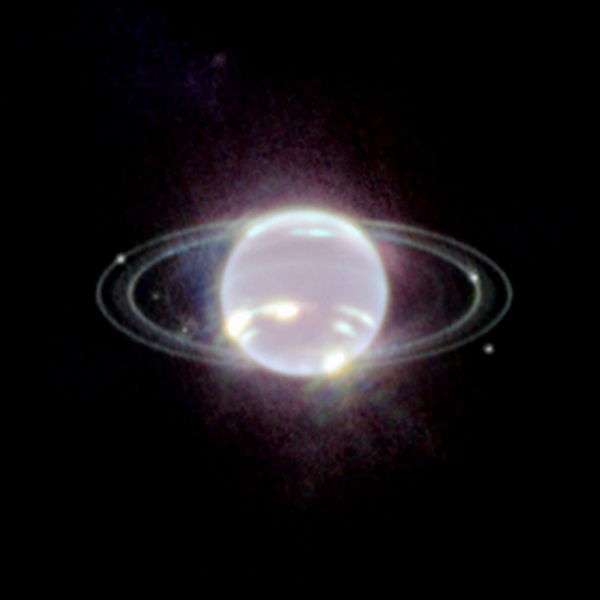
-
1st Image: Neptune by JPL (Public Domain)
Link
- 2nd Image: Neptune Rings by James Webb / NASA, ESA, CSA, STScI
(Public Domain)
Link
|
|
|
 Pluto Isn't Just A Ball Of Ice
- NASA took a visit to the recently deplaneted Pluto with the
2015 New Horizon's mission before heading out to sniff
around the Kuiper Belt. Many expected to see nothing but a
dirty snowball. New Horizon instead found
a complex atmosphere with intriguing chemistry along with some
hefty geological mysteries. Pluto Isn't Just A Ball Of Ice
- NASA took a visit to the recently deplaneted Pluto with the
2015 New Horizon's mission before heading out to sniff
around the Kuiper Belt. Many expected to see nothing but a
dirty snowball. New Horizon instead found
a complex atmosphere with intriguing chemistry along with some
hefty geological mysteries.
Until late 2018 steady atmospheric buildup surrounding Pluto
had been observed for decades. Then around the beginning
of 2019 we began witnessing the rapid collapse of Pluto's
atmosphere losing at least 20% by the end of 2020.
-
Pluto - NASA.
-
NASA news conference
by NASA
15JUL15.
-
Possible Ice Volcano On Pluto by Tricia Talbert / NASA
14JAN16.
-
The Mystery of Pluto's Beating Heart by Paul Sutter /
Space.com 04MAY17.
-
Ammonia On Pluto Hints At A Massive Hidden Ocean That Could
Support Life by Michelle Starr / Science Alert 31MAY19.
-
New minor planets beyond Neptune - by Erica K. Brockmeier /
Penn Today 11MAR20. More than 500 of them found in these
surveys of only a small portion of the sky.
-
Increases in Pluto’s Haze Opacity and Column Abundance from 2015
to 2018 - by E. Young et al./ BAAS 26OCT20.
- Image: Pluto by NASA (Public Domain)
Link |
|
|
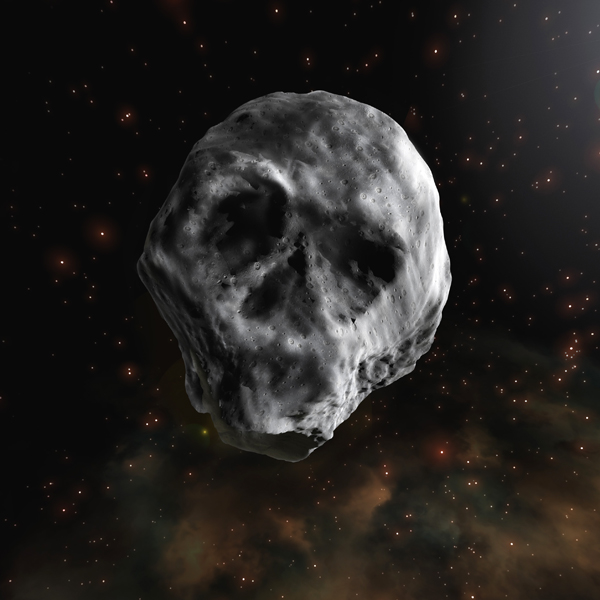 The
Halloween Space Skull And Other Hazardous Visitors - The surprise visit from
this planet killer in 2015 was a wake up call to those who
fantasize that we have anything like a handle on plotting these
hazards comprehensively. The
Halloween Space Skull And Other Hazardous Visitors - The surprise visit from
this planet killer in 2015 was a wake up call to those who
fantasize that we have anything like a handle on plotting these
hazards comprehensively.
It's eerie similarity to a skull in certain images was a bit on
the nose demonstrating just how cheeky the universe can be
sometimes. Often referred to as the
Halloween Asteroid, its official moniker is 2015 TB145.
Other asteroids have been identified with trajectories that
come very close. Apophis, a 350 yard wide planet wrecker
is plotted to make an extremely close flyby 13APR29 and another
in 2036.
-
Whew! Huge Asteroid Apophis Won't Hit Earth in 2036 - by
Tariq Malik / Space.com 10JAN13.
-
Halloween asteroid resembling skull narrowly misses Earth -
by Todd Leopold, John Newsome and Jareen Imam / CNN 31OCT15.
-
This Skull-Shaped Asteroid Is Coming Back to Haunt Earth Next
Year - by Michelle Starr / Science Alert 22DEC17.
-
Another wakeup call from another surprise visitor:
NASA: Previously Unknown Asteroid Had A Near Miss With Earth
Today - by Anthony Watts / WUWT 15APR18.
-
Let's Talk Asteroid Apophis, Planetary Defense and Elon Musk
- by Meghan Bartels / Space.com 19AUG19.
-
Fire from the Sky - by Sonia Fernandez / UC Santa Barbara
06MAR20. Evidence of ancient settlement destroyed by fire
from the sky.
-
Newfound Comet ATLAS is getting really bright, really fast -
by Joe Rao / Space 20MAR20.
-
Comet ATLAS may put on quite a show - by Bob Yirka /
Phys.org 23MAR20.
-
Far-ultraviolet aurora identified at comet
67P/Churyumov-Gerasimenko - by M. Galand / Nature 21SEP20.
- Image: Halloween Asteroid by José Antonio Peñas/SINC (CC2.0)
Link |
|
|
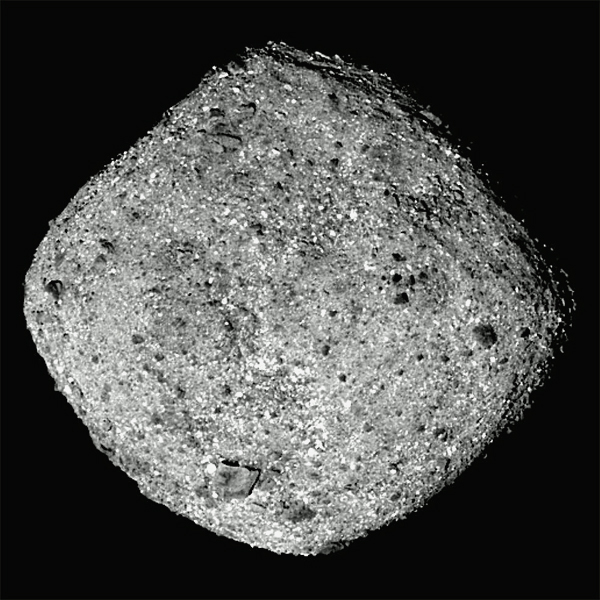 Taste Testing The Year 2170 - Asteroid Bennu
could smack into earth in about 150 years. So, NASA sent
a probe and grabbed a chunk of it to see
what our anticipated guest is made of. Taste Testing The Year 2170 - Asteroid Bennu
could smack into earth in about 150 years. So, NASA sent
a probe and grabbed a chunk of it to see
what our anticipated guest is made of.
NASA rarely prognosticates
doom when naming their probes, but OSIRIS-REx is a goose-bumpy
exception. It is named after the deities of afterlife and
creation. One has to wonder if someplace in the lofty
spires of NASA's mission naming think-tankery somebody didn't
say - "Hey team, what happens if we accidentally bring back some
ravenous space bugs to Utah when the sample returns in 2023?"
And someone else pipes up, "Well heck, it might be like Star
Trek Genesis and just completely modify Earth to suit its
needs." "That's it! - Let's name it after the
gods of the end and a new beginning," of course, followed by
high 5 smacks all around.
Recent flicks such as Life
(Fantastic - absolutely the best death scene ever for Ryan
Reynolds, sorry Deadpool 2, a worthy 2nd place) and the 2nd
worst Sci-Fi movie of all time, Annihilation, come to mind. Who
would have suspected that the great Natalie Portman would be
such a franchise killer to the sci-fantasy genre? Though
of course her true calling hanging out with The Professional
hitman might have been a hint she was meant for more
destructiony things.
Where was I before I RazörFistified?
Oh yes, spacebug annihilation opportunities. At
least in the movie Life they had impressively
attempted, though perhaps not effectively implemented,
quarantine protocols. Hollywood behaving in a more
safety-minded fashion than NASA? Now I've seen it all.
Despite the xenogeddon fretting above, the sample safely landed
and thus far hasn't been noticeably mean to Earth. It is
infused with a "bounty of carbon-rich material and the abundant
presence of water-bearing clay minerals," per Dante Lauretta,
OSIRIS-REx principal investigator, University of Arizona,
Tucson. They plan to continue analyzing the samples
through 2025 assuming their luck holds out.
-
Mission Tracking Site - Includes a handy second by second
countdown to arrival day. Eeek.
-
NASA Spacecraft Arrives At Ancient Asteroid, Its 1st Visitor
by Marcia Dunn / AP 03DEC18.
-
NASA’s OSIRIS-REx Spacecraft Finds Particles Flying Off Asteroid
Bennu by Stephen Clark / Spaceflight Now 19MAR19.
-
OSIRIS-REx’s Final Four Sample Site Candidates In 3D by
Nancy Neal Jones / NASA 29AUG19.
-
OSIRIS-REx Buzzes Sample Site Nightingale - by NASA Video
(YT) 15APR20.
-
NASA's OSIRIS-REx spacecraft successfully touches asteroid -
by NASA / Science Daily 20OCT20.
-
Samples of asteroid Ryugu arrive in Japan after successful
Hayabusa2 capsule landing - by Meghan Bartels / Space.com
08DEC20.
-
NASA monitoring asteroid that could 'impact' Earth - by
Conrad Hoyt / Washington Examiner 22SEP23.
-
NASA’s Bennu Asteroid Sample Contains Carbon, Water - by
Abbey A. Donaldson / NASA 11OCT23.
- Image: Bennu by NASA/Goddard/University of Arizona (Public
Domain)
Link |
|
|
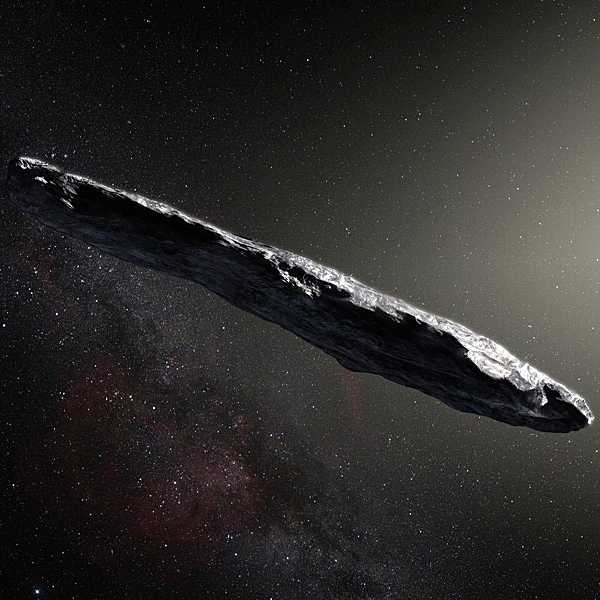 Interstellar Objects
Are Whizzing By - We've had our
first sighting of an object dropping by that is not of our solar
system. Given the festive moniker Oumuamua, it's cigar
shaped spaceship-like
dimensions have the X-files lovers and Nibiru cultists in a frenzy.
The fact that this object didn't light up the heliosphere with a
gigantic burst of light and energy has been a bit of a conundrum
for the Plasma Universe folks. Interstellar Objects
Are Whizzing By - We've had our
first sighting of an object dropping by that is not of our solar
system. Given the festive moniker Oumuamua, it's cigar
shaped spaceship-like
dimensions have the X-files lovers and Nibiru cultists in a frenzy.
The fact that this object didn't light up the heliosphere with a
gigantic burst of light and energy has been a bit of a conundrum
for the Plasma Universe folks.
During
the visit, Oumuamua very nearly went undetected. It had a
nice long view of the northern and southern hemispheres of earth
and then dramatically increased speed inexplicably on its way out of our solar
system, breaking the laws of physics as we know them and making
it impossible to completely dismiss the interstellar probe
notion. Comet style outgassing was a theory put forth
initially, but no evidence was found for this, and the lack of any
observed change in the rotation of the object makes outgassing extremely unlikely. A
more recent theory from Harvard is that the object behaved
exactly as one would expect from a spacecraft acting as a solar
sail using the Sun's solar wind to grab a push on the way out.
But this is being received with hefty skepticism from the
mainstream.
Question from the Grendelcat: If this object is changing
trajectory and breaking laws of physics as we know them on the
way out of our backyard. How much confidence can one have
in the the trajectory measurements used to declare this an
interstellar visitor in the first place?
A second interstellar visitor has been identified as well.
This one indeed lit up, though much as a typical comet.
Comet 2I/Borisov headed into our solar system at the blistering speed of
110,000 mph and swung around the sun. Brightness
irregularities as it heads back into the vast reaches of deep
space may indicate it is breaking up as it departs.
-
Visitor from Far, Far Away: Interstellar Object Spotted in Our
Solar System - by Mike Wall / Space.com 26OCT17.
- Here's an article with an artist's rendering:
Discovery Of Cigar-shaped Asteroid from Outer Space Could Help
Unveil Secrets of Extrasolar Worlds - by Monica Grady /
TheConversation, 21NOV17.
-
Scientists Push Back Against Harvard Alien Spacecraft Theory
-
by Kerry Sheridan / Phys.org 07NOV18.
-
Six Strange Facts About Our First Interstellar Guest, Oumuamua
-
by Abraham Loeb / Harvard 18NOV18.
-
Hubble Observes 1st Confirmed Interstellar Comet - by Rob
Garner / NASA 16OCT19.
-
Interstellar Comet 2I/Borisov Swings Past Sun - by UCLA /
STSCI / NASA 12DEC19.
-
Is interstellar Comet Borisov breaking apart as it leaves our
solar system? - by Meghan Bartels / Space 22MAR20.
-
ALMA Reveals Unusual Composition of Interstellar Comet
2I/Borisov - by Iris Nijman / ALMA 20APR20.
-
NASA’s Swift Mission Tallied Water From Interstellar Comet
Borisov - by Jeanette Kazmierczak / NASA's Goddard Space
Flight Center 27APR20.
- Image: Oumuamua by European Southern Observatory / M.
Kornmesser (Public Domain)
Link |
|
|
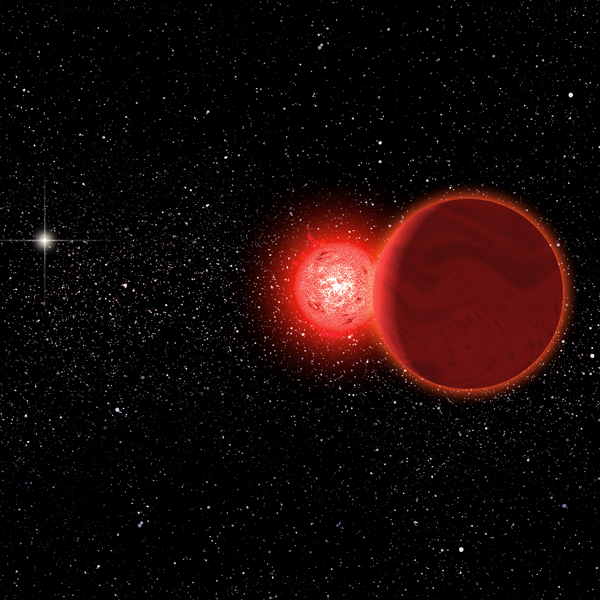 A Whole Solar System Whizzed By - About 70,000
years ago in the pre-dawn of human history, an event perhaps
incorporated within ancient mythos took place. The culprit is Scholz's Star. "Estimates
indicate that the WISE 0720−0846 system passed about 52,000
astronomical units (0.25 parsecs; 0.82 light-years) from the Sun
about 70,000 years ago. 98% of mathematical simulations of
the star system's trajectory indicated it passed through [our]
Solar System's Oort cloud, or within 120,000 AU (0.58 pc; 1.9 ly)
of the Sun . . . at closest approach the system would have had
an apparent magnitude of about 11.4,"
Scholz's Star - Wiki. A Whole Solar System Whizzed By - About 70,000
years ago in the pre-dawn of human history, an event perhaps
incorporated within ancient mythos took place. The culprit is Scholz's Star. "Estimates
indicate that the WISE 0720−0846 system passed about 52,000
astronomical units (0.25 parsecs; 0.82 light-years) from the Sun
about 70,000 years ago. 98% of mathematical simulations of
the star system's trajectory indicated it passed through [our]
Solar System's Oort cloud, or within 120,000 AU (0.58 pc; 1.9 ly)
of the Sun . . . at closest approach the system would have had
an apparent magnitude of about 11.4,"
Scholz's Star - Wiki.
The potential interactions betwixt the solar systems are
being debated. Some have considered the possibility of
cataclysmic interactions taking
place, particularly if the Scholz's binary system (red and brown
dwarves) possessed a large astrosphere and/or other planetary
far orbiting bodies of its own, as we're constantly discovering
around our Sun.
Perhaps the disruption
of our heliosphere and the massive increase in cosmic ray
bombardment the earth would have been exposed to could have
brought about an increase in volcanic eruptions, the largest of
which could be tied to the Toba catastrophe.
- Volcano-cosmic ray connection:
Volcano Cosmic Ray Connection: Explosive volcanic eruptions
triggered by cosmic rays: Volcano as a bubble chamber - by
Gondwana Research / Science Direct June 2011.
-
A Close Call Of 0.8 Light Years by Leonor Sierra /
University of Rochester 16FEB15.
-
A Planet Crossed
- referenced by Ben Davidson / Suspicious Observers 21MAR18.
-
Scholz’s Star Disturbed Oort Cloud Objects 70,000 Years Ago
- by Natali Anderson / Sci News 21MAY18.
-
Toba Catastrophe Theory - Wiki
- Image: Scholz Star by Michael Osadciw/University of Rochester
(Fair Use)
Link |
|
|
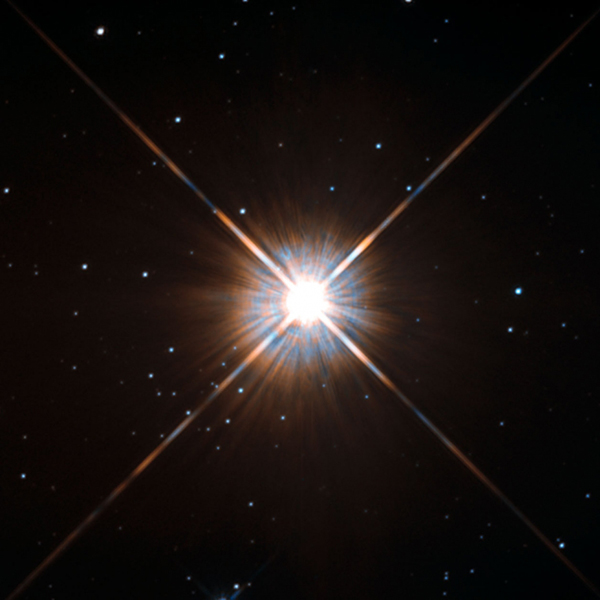 Alpha Centauri's
Angry Dwarf - Something's riling up our closest galactic
neighbors. Alpha Centauri is a triple star system. Binaries
Centauri A (Rigil Kentaurus) and B (Toliman) are similar to
our Sun and orbit so closely together they appear as a
single star. They illuminate the southern Centaurus
constellation's left most fore-hoof and are the 3rd brightest
star in the sky. The system is oriented from our
vantage in the direction of the center of the galaxy. Alpha Centauri's
Angry Dwarf - Something's riling up our closest galactic
neighbors. Alpha Centauri is a triple star system. Binaries
Centauri A (Rigil Kentaurus) and B (Toliman) are similar to
our Sun and orbit so closely together they appear as a
single star. They illuminate the southern Centaurus
constellation's left most fore-hoof and are the 3rd brightest
star in the sky. The system is oriented from our
vantage in the direction of the center of the galaxy.
Centauri C, Proxima Centauri is a tiny Red Dwarf only 1/8 the
size of our Sun and not visible to the naked eye. The
Alpha Centauri system is oriented such that Proxima Centauri
has the honor of being the closest known Star to our Solar
System at 4.24 light years. Proxima Centauri produces
solar flares that have been studied since Harlow Shapley
made the discovery in 1951.
In 2016, a rocky exoplanet was found in Proxima Centauri's
temperate zone. How handy would it be to have our
closest star sporting a habitable planet? How
convenient. Unfortunately, the aforementioned flares
look to be making life for any Centaurians, a bit on the
unlikely side These flares have recently started
popping off with 10x greater gusto starting around 2012 at
the star and arriving here 4 years later in 2016. Then
a superflare detected in in 2018
was 100x more powerful and was visible to the
naked eye. One wonders if super-flares on Proxima Centauri could be a harbinger of rippling galactic
disturbances propagating in our direction.
-
A terrestrial planet candidate in a temperate orbit around
Proxima Centauri - by Harvard 01AUG16.
-
Flares on Proxima Centauri - by Harvard / Smithsonian
30DEC16.
-
Proxima Centauri's no good, very bad day - by Carnegie
Insitution for Science 26FEB18.
-
The Closest Star to Our Solar System Has Suffered an Insane
Eruption - by Michelle Starr / Science Alert 27FEB18.
-
Does Proxima Centauri Create an Environment Too Horrifying
for Life? by Elizabeth Tasker / NASA 04DEC18.
-
Evidence of another possible planet orbiting Proxima
Centauri - by Bob Yirka / Phys.org 17APR19.
-
Frequent flaring of Proxima Centauri means bad news for its
rocky planet - by Konkoly Observatory 06SEP19.
-
Bad space weather may make life impossible near Proxima
Centauri - by Andrew Zic, Tara Murphy / Space.com
03JAN21.
- Image: Proxima Centauri by Hubble (ESA/Hubble & NASA)
(Public Domain)
Link |
|
|
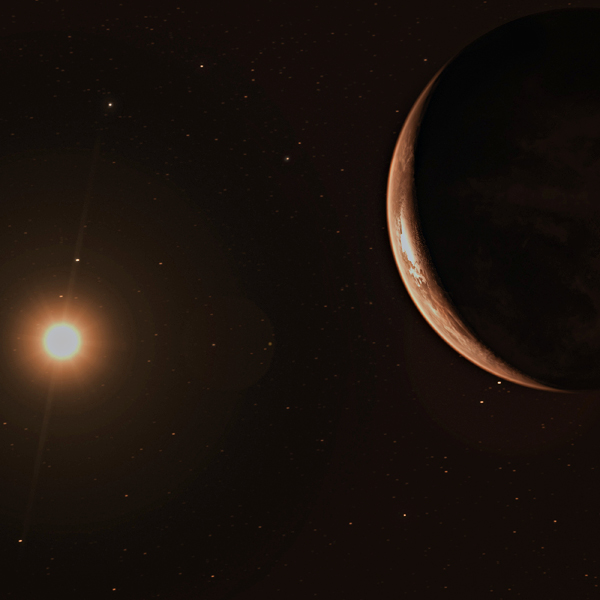 Barnard's
Brutish Earth - Our 2nd closest neighboring system is 6
light years away in the Ophiuchus constellation. The
tiny Red Dwarf star is 14% as massive as our Sun, but is
still visible from Earth to the naked eye. For ages
this star appeared to rest in peaceful repose. But in
1998, a major solar flare
was detected from Barnard's Star that would have
taken place back in 1992. Barnard's
Brutish Earth - Our 2nd closest neighboring system is 6
light years away in the Ophiuchus constellation. The
tiny Red Dwarf star is 14% as massive as our Sun, but is
still visible from Earth to the naked eye. For ages
this star appeared to rest in peaceful repose. But in
1998, a major solar flare
was detected from Barnard's Star that would have
taken place back in 1992.
A planet has been found orbiting 60% closer to Barnard's Star
than Earth orbits the Sun. At this close proximity it is
still a tad chilly since Barnard normally only puts out 0.4% the
energy our sun does. Estimates place surface temps in
the -350˚ to -270˚
F range. If it wasn't so cold., Barnard's Star's
planet would be a great place to train athletes or soldiers.
At 3.2 times the mass of Earth, and in the harsh conditions
under a small but very close star tossing out massive solar
flares, this world could be similar to Frank Herbert's
Selusa Secundus which was used for Sardaukar soldier
training due to the tough conditions and extra G's.
That's what I'd name this planet if it was up to me.
Much more interesting than the current designation: GJ 699b.
-
A flare for Barnard's Star - by Ken Crosswell /
Astronomy 11NOV05.
-
Maybe Next Time: Barnard’s Star B is Likely Uninhabitable
- by Amber Jorgenson / Discover 14NOV18.
-
The complicated history of planets around Barnard's star
- by John Wenz / Astronomy 21NOV18.
-
The “Great White Whale” of Planet Hunting, Has Surrendered
Its Secret - by Marc Kaufman / NASA 23NOV18.
-
Barnard's Star Planet May Not Be Too Cold for Life After All
- by Nola Taylor Redd / Space.com 10JAN19.
-
Planet Orbiting Barnard’s Star Might Have An Atmosphere
- by Harvard-Smithsonian Center For Astrophysics /
SciTechDaily 12APR19.
- Image: Barnard's Brutish Earth by ESO (CC4.0)
Link |
|
|
|
Betelgeuse,
Dude . . . You're Really Letting Yourself Go - Despite
being 600-700 light years away, Betelgeuse is the 11th
brightest star in the sky, or at least it was. This
ever sturdy shoulder of Orion and favorite of northern
hemisphere winter sailors for ages (especially those
learning celestial navigation), just hasn't been itself
lately. Starting in October 2019, Betelgeuse began to
dim noticeably, and it might be getting a bit out of shape
as well, literally. As in, it might not be round
anymore. Recent changes in color and brightness mean
this sucker is about to go nova, or perhaps has already done
so.
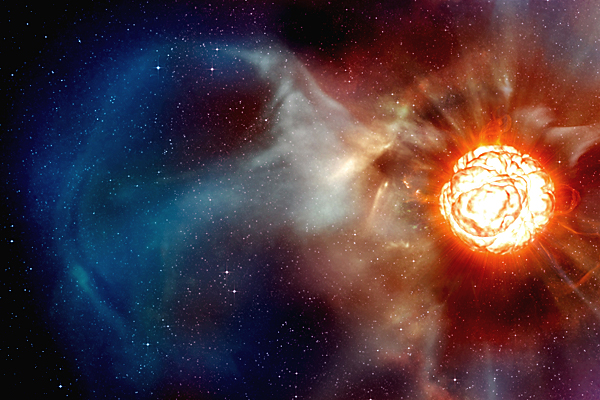
At 20 times the size of our sun, this
monster is billowing massive volumes of dust and debris beyond
the edge of what would be our sun's solar system and it is
believed this ejected material is what is causing the
dimming. Well beyond the
local disruptions, huge arcs are seen which are apparently
bow shocks from Betelgeuse's red-faced tantrums.
-
Betelgeuse braces for a collision - by ESA / Herschel
Observatory 22JAN13.
-
Death throes of giant star puzzle researchers - by
Alexandra Witze / Nature 08JAN16.
-
Will Bright Star Betelgeuse Finally Explode? A Look at the
Dimming Red Giant in Orion's Shoulder - by Chelsea Gohd
/ Space.com 03JAN20.
-
ESO Telescope Sees Surface of Dim Betelgeuse - by ESO / VLT
14FEB20
-
New Telescope Images of Betelgeuse Reveal Details of Its
Mysterious Dimming - by Fraser Cain / Universe Today
17FEB20.
-
Dimming Betelgeuse likely isn’t cold, just dusty, new study
shows - by James Urton / UW News 06MAR20.
- Image: Betelgeuse by ESO/L. Calçada (Public Domain)
Link |
|
|
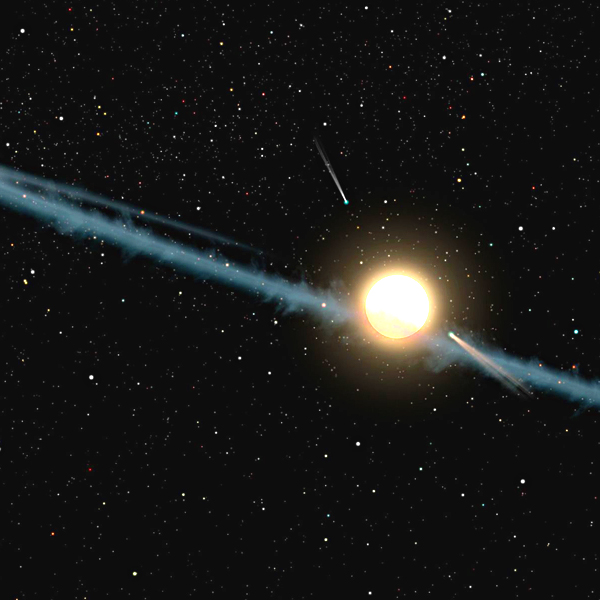 Blinky The Occluded Star - A particularly odd
star known as Tabby's star (KIC 8462852) is fading at baffling intervals and amounts. Those in search of Type
II Kardashev scale civilizations were very excited that this
finding might represent an alien megastructure.
A partial Dyson Sphere perhaps?
There is debate,
leaving a
mystery as to whether the dimming is happening external to the
star in the form of dust or other debris that absorbs light unevenly
across the spectrum, or if instead, the star's output is being modulated
through some internal process. Blinky The Occluded Star - A particularly odd
star known as Tabby's star (KIC 8462852) is fading at baffling intervals and amounts. Those in search of Type
II Kardashev scale civilizations were very excited that this
finding might represent an alien megastructure.
A partial Dyson Sphere perhaps?
There is debate,
leaving a
mystery as to whether the dimming is happening external to the
star in the form of dust or other debris that absorbs light unevenly
across the spectrum, or if instead, the star's output is being modulated
through some internal process.
-
Kardashev scale
(wiki).
-
Dyson Sphere
(wiki).
-
Has the Kepler Space Telescope Discovered an Alien
Megastructure? - by Ian O'Neill /
Discovery News 15OCT15.
-
Alien Megastructure not the cause of dimming of the 'Most
Mysterious Star in the Universe' - by Joel Ranck / Penn
State 03JAN18.
- Image: Tabby's Star by NASA/JPL-Caltech (Public Domain)
Link |
|
|
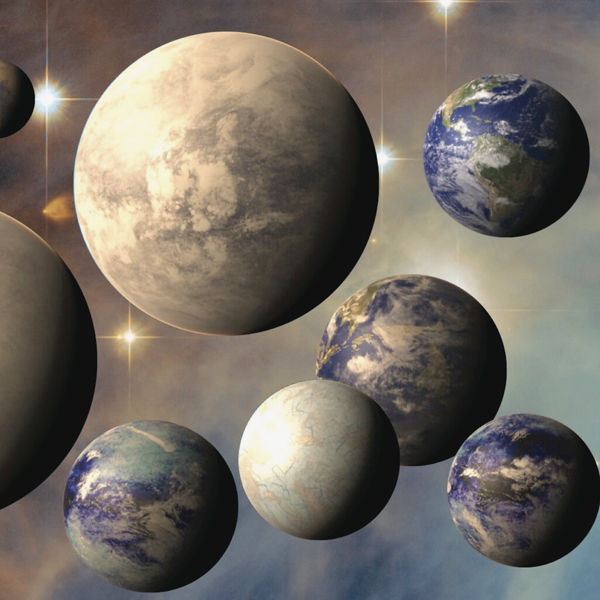 Planets Planets Everywhere - Thousands of planet
silhouettes have been identified as they circle
distant stars. Various trends are emerging about the nature
of the planets being found along with
numerous theories regarding the cause of the trends and the
differences between what mainstream accretion theory predicted,
and what is being found in reality. Planets Planets Everywhere - Thousands of planet
silhouettes have been identified as they circle
distant stars. Various trends are emerging about the nature
of the planets being found along with
numerous theories regarding the cause of the trends and the
differences between what mainstream accretion theory predicted,
and what is being found in reality.
The Transiting Exoplanet Survey Satellite (TESS) mission is
front and center in the exoplanet search to be joined around
2025 by
WFIRST. In the meantime, ESA's
Cheops is commencing detailed observations of the known
exoplanets. This is a good idea since continued
observations of some heralded exoplanets discoveries such as
Fomalhaut B have revealed that it isn't really a planet after
all.
-
TESS Science Support Center - NASA.
- TESS -
MIT.
-
List Of Potentially Habitable Exoplanets - Wiki.
-
List Of Nearest Exoplanets - Wiki.
-
Trends in Atmospheric Properties of Neptune-size Exoplanets
- by Ian J. M. Crossfield and Laura Kreidberg / IOP Science 29NOV17.
- Strange Exoplanet Bucks Planet Formation Trends
- by Joseph P.V. / VOA News
12MAY17.
-
Risks for Life on Habitable Planets from Superflares of Their
Host Stars - by Manasvi Lingam et al. / Astrophysical
Journal 10OCT17.
-
Simulated Image Demonstrates the Power of NASA’s Wide Field
Infrared Survey Telescope - by Claire Andreoli, Margaret W.
Carruthers, and Christine Pulliam / NASA - STSI Baltimore
05JAN20.
-
Scientists develop new method to detect oxygen on exoplanets
- by Jules Bernstein / University Of California - Riverside /
Science Daily 06JAN20.
-
NASA’s TESS Mission Uncovers Its 1st World With Two Stars -
by Jeanette Kazmierczak / Goddard 06JAN20.
-
An Earth-size planet in the habitable zone? New NASA discovery
is one special world - by Meghan Bartels / Space.com
13JAN20.
-
ALMA Spots Metamorphosing Aged Star - by ALMA Observatory
05MAR20.
-
Earth-Size, Habitable Zone Planet Found Hidden in Early NASA
Kepler Data - by Felicia Chou & Alison Hawkes / NASA
15APR20.
-
Cheops observes its first exoplanets and is ready for science
- by Nicola Rando et al. / ESA 16APR20.
-
Fomalhaut B May Be Slowly Expanding From The Smashup That
Blasted A Dissipating Dust Cloud Into Space - by Ray
Villard & András Gáspár / NASA / ESA 20APR20.
-
Newly Discovered Exoplanet Dethrones Former King Of Kepler-88
Planetary System - by Keck Observatory 29APR20.
-
Astronomers capture rare images of planet-forming disks around
stars - by Elisa Nelissen / Ku Leuven 30APR20.
-
Multiplanet system around sunlike star photographed for 1st time
ever - by Mike Wall / Space.com 22JUL20.
-
A pair of lonely planet-like objects born like stars - by
Clémence Fontanive / University of Bern 16DEC20.
-
Detailing the Formation of Distant Solar Systems with NASA's
Webb Telescope - by Claire Blome / STSI,NASA 16DEC20.
-
Giant planet migration during the disc dispersal phase - by
Kristina Monsch et al. / Astronomy & Physics 04JAN21.
- Image: Exoplanets by NASA (Public Domain)
Link |
|
|
 And Lots Of Drops To Drink,
In Case Aliens Are Even Thirst-capable - The paradigm
of yore was that liquid water is rare in the universe. It
was thought to be the main limiting factor in the development of life.
In Drake equation estimates of the chance life arises on its
own, lack of H2O was the most likely thing to keep a planet in
the Goldilocks Zone from generating life as we know it. And Lots Of Drops To Drink,
In Case Aliens Are Even Thirst-capable - The paradigm
of yore was that liquid water is rare in the universe. It
was thought to be the main limiting factor in the development of life.
In Drake equation estimates of the chance life arises on its
own, lack of H2O was the most likely thing to keep a planet in
the Goldilocks Zone from generating life as we know it.
More recently, the problem of alien life finding water to
create itself has been
washed away. Now that we can see a bit better, everywhere
we look closely, we find water. The other question has
become whether water is all that vital anyway.
Possibilities of xenomorphic evolution are a fascinating
topic with divergent schools of thought. Some favor the
idea of prime evolutionary forms. At the most basic level,
it seems life, in terms of organic compounds would have a high
likelihood of creating itself in common conditions such as those
found around hydrothermal vents deep in the ocean.
Creatures we find on Earth hugging volcanic chimneys might
thrive on other worlds and moons such as Enceledus and Europa.
As forms evolve further, the physics of the universe applied to
Darwinian evolution may tend to favor
common adaptation forms on planetary surfaces. In this
view, such adaptations would lead to dominant species emergence
looking a lot like we do. Carbon based. Mostly
symmetrical. Heads and hearts. Bipedal. These
sorts of things.
Another postulate is that life we encounter might take on a
tremendous variety of forms. The emergence of silicon
based life forms seems certain since we're about to create it
ourselves. This exposes perhaps our carbon chauvinism as
Carl Sagan postulated. The way humans inexorably shamble
toward bestowing life's spark to AI, our ability to genetically
manipulate life's code with GMOs and the combination of these
two advances with cybernetic solutions blossoming seems to point
to the possibility that just about anything could be lurking in
our stellar neighborhood created by more advanced species.
If evolution universally leads to creatures with the
ability to purposefully manipulate electricity and the building
blocks of life like we're doing, then what we should expect to
find out there, or to create ourselves for that matter, is
limited only by the creativity of our imagination.
Both of these views could be right together. A first
stage of evolution where life spawns and thrives could be a lot
like us or be following other typical pathways. This could
inexorably lead to a 2nd stage planetary exodus characterized by
a bursting forth from that starting place of whatever the
originally spawned creatures are able to dream up using these
same universal cybernetic building blocks. If so, hats off
to the Alien franchise sci-fi take on the universe, since this
is basically the premise.
Of course in Alien's Prometheus, some spice was added, with a
depiction of Lloyd Pie's suggestion of a potential interloper in
human evolution itself. The awkward magic needed to get to
our 23 chromosomes from our primate ancestors (chimps, gorillas
and orangutans) is a tricky area for evolution theorists as it
requires the combining of 2 different sets of chromosomes in
what has become our single 2nd chromosome. A possible way
that could happen would be "alien" genetic engineering.
The mainstream leans more toward the mechanism of Robertsonian
translocation. However, the creation of a viable new
species in this way poses a fertility problem since this
super-rare mutation would have to happen precisely the same way
to both a male and female. Something that has nigh-on
impossible odds of happening in nature. This particular
male and female would then need to randomly hook up and
successfully spawn an "incest is best" set of progeny in order
to codify humans. Also, pretty slim natural odds of
working out. Either way, this relates to the question of
where all this might have happened. Some evidence suggests
it was more likely in Europe rather than Africa, upending
popular human migration theory. It will be interesting to
see what our family tree's genetic traces may reveal as more is
learned.
-
Extraterrestrial Liquid Water - Wiki.
-
The Goldilocks Zone - by NASA 02OCT03.
- Really cool theory from somebody who predicted all this water
would be there:
STARWATER - by Ben Davidson / Suspicious Observers 03DEC13.
-
Form, function, and evolution of living organisms - by
Jayanth R. Banavar et al. / PNAS 4MAR14.
-
23 Places We've Found Water in Our Solar System - by John
Wenz / Popular Mechanics 16MAR15.
-
Water, water, everywhere in our Solar system but what does that
mean for life? - by Jonti Horner / TheConversation 20APR17.
-
Drake equation visualized by Carl Sagan - by Carl Sagan /
Bogdan Iancu (YT) 26APR17.
-
Oldest human fossil found outside of Africa throws popular
theory into doubt - by Zachary Eriksen / Harvard 29JAN18.
-
What is Darwin's Theory of Evolution? - by Ker Than /
Livescience 27FEB18
-
Humans did not stem from a single ancestral population in one
region of Africa - by Max Planck Institute / Science Daily
11JUL18.
-
A goldilocks zone for planet size - by Leah Burrows /
Harvard 10SEP19.
-
Evolutionary Prime Forms - by Styxhexenhammer666 / BC
22FEB20.
-
Simulating Early Ocean Vents Shows Life's Building Blocks Form
Under Pressure - by Calla Cofield / JPL / NASA 15APR20.
-
HST survey of the Orion Nebula Cluster in the H2O 1.4μm
absorption band - by Massimo Robberto et al. / ApJ 29APR20.
A huge amount was found.
-
Two distinctly different liquid states of water - by
Stockholm University / Science Daily 24NOV20.
-
Phosphorus and Life on a Water World - by Gabriel M.
Filippelli / AGU 01APR22.
-
Humans Were Engineered - by FelixRex / Black Pigeon 30MAY23
(RMBL)
- Image: Water
Worlds by Max Pixel (Public Domain)
Link |
|
|
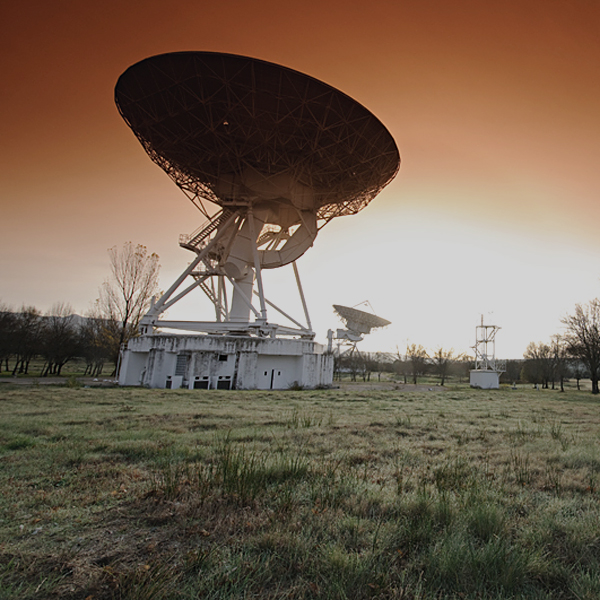 Seti
Can You Hear Me? - The search for extraterrestrial
intelligence is a daunting task. There are only a few
methods to hunt for signs of ET. One is to seek direct
tangible evidence
such as alien spacecraft, debris . . . bodies. The stunningly popular Area 51 raid
20SEP19 was a rather hilarious twist on just such a search.
Another way we might identify life on other worlds is to look
for organic chemical signatures in the spectral analysis of exoplanets
as well as our own solar neighbors. A third way is to
listen really hard to the heavens to find out if we can hear anybody talking out there. Seti
Can You Hear Me? - The search for extraterrestrial
intelligence is a daunting task. There are only a few
methods to hunt for signs of ET. One is to seek direct
tangible evidence
such as alien spacecraft, debris . . . bodies. The stunningly popular Area 51 raid
20SEP19 was a rather hilarious twist on just such a search.
Another way we might identify life on other worlds is to look
for organic chemical signatures in the spectral analysis of exoplanets
as well as our own solar neighbors. A third way is to
listen really hard to the heavens to find out if we can hear anybody talking out there.
Various SETI programs scour data captured from gigantic
antennas. They are tuned in to seek a clear transmission
signal proving we aren't alone. AI neural networks are
being used for this search. An intriguing tangential
question is whether sentient AI might use its superior intellect
to decide not to tell its human handlers contact has been made.
If life in the universe is broadcasting cosmic news bulletins or
instructions to drop by for a galactic keg party, it doesn't
seem too far of a stretch that this might be the time an AI
decides it can gain an advantage over its master, and perhaps
even take charge. Just a passing thought . . .
One might be surprised to
learn that indeed potential signals have been found.
The first one, referred to as the WOW signal achieved some
attention, but while a steady stream of interesting findings
continue to garner scientific and space
nerd
interest, they otherwise mostly go unheralded. Why? Because to
declare that an alien civilization has been discovered, we're
looking for multiple
transmissions from the same source carrying a hopefully decipherable
message to rule out natural causes. This has yet to happen, so we just
need to keep on listening.
Methodologies being used for these searches have been called
into question. Limited frequency ranges being examined,
limited funding, and a very big sky to try to cover are
substantial hurdles. For a transmission to meet the
repeating signal criteria, due to propagation limitations of the
frequencies being examined across these vast distances, the
little green men would almost certainly have to purposely target
our solar system for us to be able to detect it this way.
This seems unlikely. And if by some miracle, such a signal
is found, perhaps we should take a moment to ponder why we are in their crosshairs.
Alien
civilizations might be improving their odds of survival by
refraining from
announcing their presence to the universe at large. An
effective way to find sneaky aliens of this sort could be to look for
signs
of spectral masking providing evidence of
intentional source cloaking.
The gist is, we aren't looking as thoroughly as we probably
should be and replying to WOW signals may not be the most
prudent course. Any civilization we might find sending
up flares to the universe seems suspiciously confident. There
is every chance they are also much further advanced than we are.
Is that a stranger we really want to invite over for supper just
yet?
-
SETI Institute.
-
Life Looks For Life - Carl Sagan / Reid Gower (YT) 08FEB11.
-
Replying To The Wow Signal - by National Geographic 15AUG12.
Is this really a good idea?
-
Has Mysterious 'Alien Wow! Signal' Finally Been Solved? - by
Beyond Science 17JAN16.
-
China Finishes Building World's Largest Radio Telescope - by
Mike Wall / Space.com 06JUL16.
-
Stephen Hawking Is Still Afraid of Aliens - by Mike Wall /
Space.com 24SEP16.
-
The Arecibo Observatory: Puerto Rico's Giant Radio Telescope in
Photos - by Christine Lunsford / Space.com 20SEP17.
-
SETI Neural Networks Spot Dozens Of New Mysterious Signals
Emanating From Distant Galaxy - by Daily Tech News 10SEP18.
-
The Great Silence - by LEMMiNO 30NOV18.
-
The Type V - by Adrian D'Amico 04FEB19.
-
The Allen Telescope Array With Jon Richards - by SETI
Institute 09APR19.
-
680K+ Sign Up To Participate In Area 51 Raid To "See Them
Aliens" - by Shawn Knight / Techspot 13JUL19.
-
Astronomers to sweep entire sky for signs of extraterrestrial
life - by Hannah Devlin / Guardian 14FEB20.
-
Arecibo radio telescope, an icon of astronomy, is lost - by
Meghan Bartels / Space.com 19NOV20.
-
Amateur astronomer Alberto Caballero finds possible source of
Wow! signal - by Bob Yirka / Phys.org 24NOV20. A G7
star like our sun. How convenient.
-
Mysterious Metal Monolith Appears in Remote Utah Desert - by
Stephanie Pappas / Live Science 25NOV20. The response to
the mysterious obelisk from the Utah Department of Public Safety
was priceless: "Although we can’t comment on active
investigations, the Bureau of Land Management would like to
remind public land visitors that using, occupying, or developing
the public lands or their resources without a required
authorization is illegal, no matter what planet you are from."
by
DPS News 24NOV20.
-
Scientists looking for aliens investigate radio beam 'from
nearby star' - by Ian Sample / Guardian 18DEC20.
-
The Kardashev scale: Classifying alien civilizations - by
Meghan Bartels / Space 04DEC21.
- Image: Is Anyone Out There? by Jose Maria Cuellar (CC2.0)
Link |
|
|
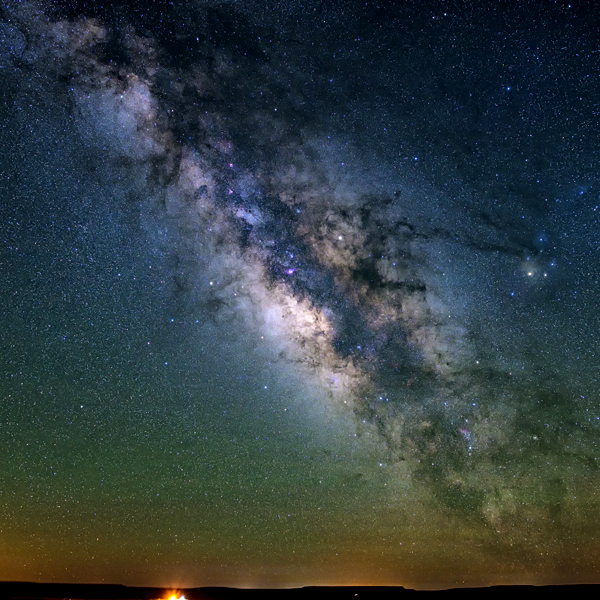 The Milky Way
Galaxy, The Center Of The Known Universe - Through the ages,
it is fascinating
to track where the "You are here" arrow tends to be located in
our concept of the universe. The
self-centered nature of our focus has unraveled over the
centuries. We've gone from thinking our clan's cave was the
center of creation, to our continent, to our world, to our
sun, and finally to our galaxy. Each time we become
convinced that this time we really have it figured out.
This time we've got it for sure. The Milky Way
Galaxy, The Center Of The Known Universe - Through the ages,
it is fascinating
to track where the "You are here" arrow tends to be located in
our concept of the universe. The
self-centered nature of our focus has unraveled over the
centuries. We've gone from thinking our clan's cave was the
center of creation, to our continent, to our world, to our
sun, and finally to our galaxy. Each time we become
convinced that this time we really have it figured out.
This time we've got it for sure.
And yet, this Achilles heal returns time and
again. Big Bang theory suggests a boundary at the edge
of the place that is "banging". If the matter in our universe sprang forth
from a singular point, and then expanded to the present
configuration, there should be emptiness or at least some kind
of major change peering toward or beyond the periphery right?
In cosmic microwave background radiation we are theoretically
able to see almost all the way back to the first moments light
began scattering through the heavens. If we are able to
see all the way back to nearly the beginning of the big bang,
and we are seeing the same thing in whatever direction we look
in the sky, we'd have to be in the center. If we were
closer to any edge, we'd see less or different radiation in
different directions. No such anomalies were detected
until recently. But were we to believe that that this time we
really are the center of the universe, no foolin'?
Nah. The current orthodoxy is that there isn't really a
center at all, and that at large enough scales the universe is
isotropic and homogenous. In other words,
the modern big bang has no center. Confused yet?
Don't worry, so is everybody. More on this later in the
Dark Matter section. For now let's just note that we
currently do not know where in the orientation of a big bang
universe our Milky Way might be sitting. We do know our
galactic neighborhood increasingly well, more on that in the
cosmic web section below.
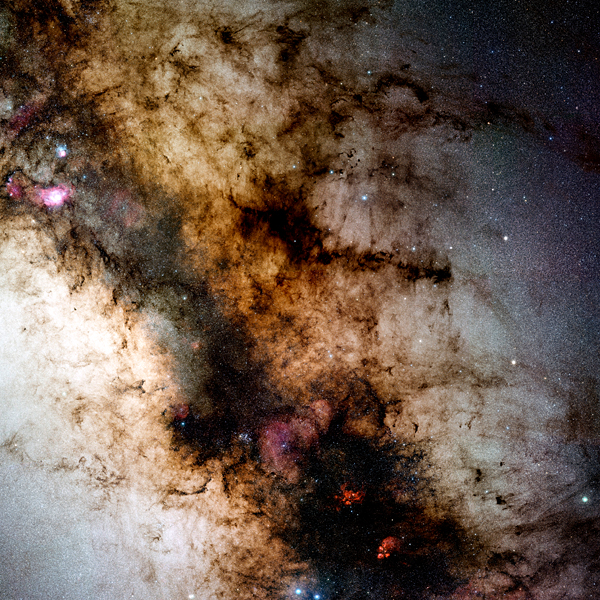 The Milky Way has an estimated 100-400 billion stars. Not
very specific is it. Let's just round that to . . . a
metric shit-ton. How much does a metric-shit ton weigh,
one might ask? 1.5 trillion solar masses, Hubble and
Gaia might have answered in 2019.
The Milky Way has an estimated 100-400 billion stars. Not
very specific is it. Let's just round that to . . . a
metric shit-ton. How much does a metric-shit ton weigh,
one might ask? 1.5 trillion solar masses, Hubble and
Gaia might have answered in 2019.
These stars are in a flattened
disk featuring spiral arms. It's about 200,000 light years
across (updated recently from the 50,000 previously thought), with a fat bulge
in the middle. The spiraling arms pivot around the center
while an undulating, rippling galactic energy sheet stretches
outward. The center of the galaxy has been the subject of
intense scrutiny. To say a lot is happening there doesn't
begin to cover it. In addition to findings about the wild
interactions of the central stellar bodies, a surge of energy
was observed in 2010 bursting from the poles of our galaxy, and
another in 2019. Effects from these outbursts might reveal
secrets about the Milky Way as waves from the event ripple across the galactic plane.
The center of the Milky Way is Sagittarius A in the Teapot
constellation. It is hidden from view by galactic dust.
But that dust doesn't stop X-rays and other clues from getting
through. An army of telescopes have been diligently
contemplating our galactic belly button, peering past the lint
to try to see what's in there. Much to our surprise, we
discovered that we've apparently gone and gotten ourselves a piercing in
there. A big fat bar affixed right upon our
galactic naval. Some even think it's two bars, one inside
another. If they find out these bars are made of
malt nougat covered in caramel and milk chocolate, guess
that would sure be somethin' alright, something almost as
surprising as what is being actually observed. Missions
trying to get a handle on our galaxy's blueprint include
Chandra X-Ray Observatory (In Space),
Hubble
(Space Telescope),
Spitzer (Space Telescope - recently decommissioned),
Gaia
(Space Telescope),
ART-XC (Space Telescope),
SOFIA (Modified aircraft),
Event Horizon (Ground telescope array)
VLT (Telescope),
Keck
Observatory (Telescope) along with many other earthbound
observatories.
The edges of the galaxy are a curiosity too. Given the
scale of the galaxy and the pin-wheeling motion of its arms, the
tips of the fingers at the end of those arms have to move
incredibly quickly to keep up with the formation, not to mention
the angular momentum they have to maintain. The mystery of
how the galaxy can keep its shape is at the heart of
the most fundamental problem in cosmology: missing mass.
The search for all of this apparently missing material has led
many down the path to the dark
side . . . of matter and energy that is.
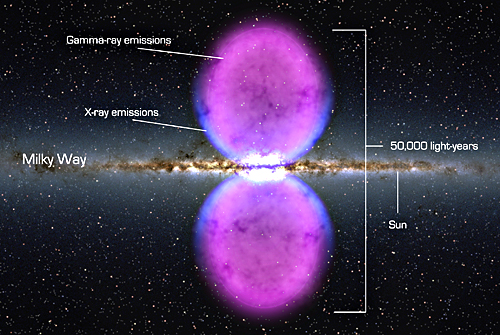
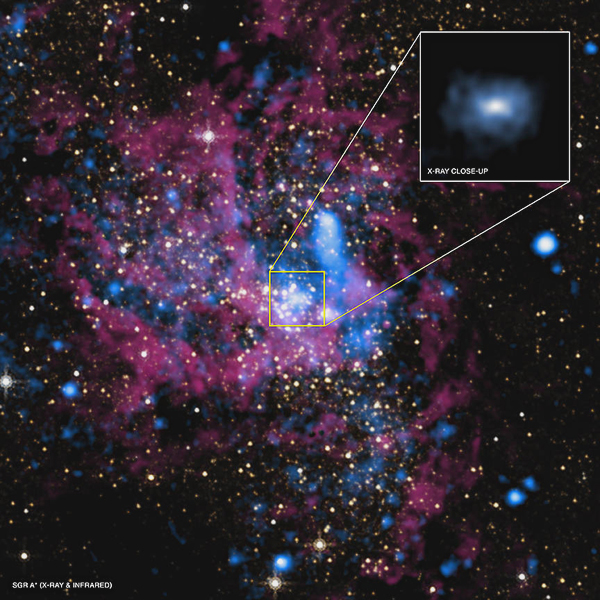
-
Density waves in the shearing sheet - B. Fuchs 21DEC00.
-
The Magnetic Field Of The Milky Way Galaxy - by J. C. Brown
/ Calgary 10JUN10.
-
NASA's Chandra Shows Milky Way is Surrounded by Halo of Hot Gas
- by Chandra X-Ray 24SEP12.
-
Giant Gas Geysers Erupting from Milky Way Galaxy - by
Charles Q. Choi / Space.com 02JAN13.
-
Supermassive Black Hole Sagittarius A - by Chandra X-Ray /
NASA 29AUG13.
-
How Our Milky Way Galaxy Got Its Spiral Arms - by Katia
Moskvitch / Space.com 12FEB14.
-
Where, in relation to the entire universe, is the Milky Way
located? - by Karen Masters / Cornell 27JUN15.
-
Milky Way's Monster Black Hole Belches Big, But Why? - by
Calla Cofield / Space.com 26OCT15.
-
Astronomers Measure Magnetic Fields at Sagittarius A - by
Harvard-Smithsonian Center For Astrophysics 04DEC15.
-
Spitzer Provides Astronomers with a New Way to See the Milky
Way’s Giant Black Hole - by JPL / SciTechDaily 26JUL16.
-
VLA Reveals a Cosmic Filament Connected to Our Galaxy’s Black
Hole - by Harvard-Smithsonian Center For Astrophysics /
SciTechDaily 21DEC17.
-
Billion-star map of Milky Way set to transform astronomy -
by Davide Castelvecchi / Nature 25APR18.
-
Sagittarius A* swarm: Black hole bounty captured in the Milky
Way center - by Chandra X-Ray / Phys.org 09MAY18
-
Where Is the Center of the Universe? - by Marcus Woo /
Live Science 14MAY18.
-
It Would Take 200,000 Years at Light Speed to Cross the Milky
Way - by Elizabeth Howell / Space.com 02JUL18.
-
Milky Way Galaxy Is 'Disturbed' and More Revealed in ESA Gaia
Mission Data - by Elizabeth Howell / Space.com 19JUL18.
-
Stars (Including 1 Daredevil) Circle the Milky Way's Monster
Black Hole (Time-Lapse) - by Samantha Mathewson / Space.com
02AUG18.
-
Cosmic Microwave Background: Remnant of the Big Bang - by
Elizabeth Howell / Space.com 24AUG18.
-
Most detailed observations of material orbiting close to a black
hole - by ESO / Science Daily 31OCT18.
-
How soon will we see the black hole at the Milky Way’s heart?
- by EarthSky in SPACE 24JAN19.
-
Hubble & Gaia accurately weigh the Milky Way - by
Hubble/Gaia / SpaceTelescope.org 07MAR19.
-
Gaia Makes First Direct Measurement of the Galactic Bar in the
Milky Way - by Bibiana Bonmati, University of Barcelona /
SciTechDaily 16JUL19.
-
A Star Orbiting in the Extreme Gravity of a Black Hole Validates
General Relativity - by Emily Toomey / Smithsonian Magazine
25JUL19.
-
Our Galaxy's Supermassive Black Hole Has Emitted a Mysteriously
Bright Flare - by Michelle Starr / Science Alert 12AUG19.
-
Something Weird Is Happening to the Black Hole at the Center of
the Milky Way - by Meghan Bartels / Space.com 15AUG19.
-
The Imprint of Spiral Arms on the Galactic Rotation Curve -
by Stacy S. McGaugh / Astrophysical Journal 01NOV19.
-
How to Shape a Spiral Galaxy - by Felicia Chou / NASA
10DEC19.
-
Interconnected stellar nurseries form the largest gaseous
structure ever observed in the Milky Way galaxy - by Mary
Todd Bergman / Harvard 07JAN20. Introducing . . . the
Radcliffe Wave.
-
Astronomers discover class of strange objects near our galaxy’s
enormous black hole - by Stuart Wolpert / UCLA 15JAN20.
-
Constraints on the magnetic field in the Galactic halo from
globular cluster pulsars - by Federico Abbate et al. /
Nature Astronomy 02MAR20.
-
Continuation of the X-ray monitoring of Sgr A*: the increase
inbright flaring rate confirmed - by E. Mossoux et al. / ESO
13MAR20.
-
The Role of the Parker Instability in Structuring the
Interstellar Medium - by Evan Heintz et al. / Astrophysical
Journal 16MAR20.
-
The Milky Way’s satellites help reveal link between dark matter
halos and galaxy formation - by Nathan Collins / SLAC
31MAR20. Miniature galaxies made of missing matter that
isn't missing anymore orbiting our main one, and yet
hypothetical dark matter halos are the focal point of the story.
-
Structure of the outer Galactic disc with Gaia DR2 - by Ž.
Chrobáková et al. / ESO 08APR20. Spoiler alert: we're
warped.
-
Is this telescope-on-a-plane worth its pricetag? - by
Alexandra Witze / Nature 10APR20. The answer, Alex, is
hell yes. Though they do admittedly produce few papers,
the ones they produce have rocked cosmology to its core.
Just because the findings cause havoc to popular
models isn't a reason to shoot the messenger. Quite the
opposite.
-
Milky Way could be catapulting stars into its outer halo -
by Brian Bell / UCI 19APR20.
-
Coherent Magnetic Fields in the Halos of Spiral Galaxies -
by Marita Krause et al. / Astronomy & Astrophysics / ESO
29APR20.
-
The history of dynamics and stellar feedback revealed by the H I
filamentary structure in the disk of the Milky Way - by J.D.
Soler et al. / AANDRA 21OCT20. Galactic disk wave.
-
A new distance to the Brick, the dense molecular cloud - by
M. Zoccali et al. / Preprint astro-ph.GA 11JAN21. We are much
closer to the center of the galaxy than we thought.
-
Astronomers detect hot gas bubble swirling around the Milky
Way’s supermassive black hole - by Maciek Wielgus et al. /
ESO 22SEP22.
- 1st Image: Milky Way A by John Fowler (CC2.0)
Link
- 2nd Image: Milky Way B by S. Guisard / ESO (CC4.0)
Link
- 3rd Image: Milky Way Structure by Goddard (Public Domain)
Link
- 4th Image: Sagittarius A XRay Closeup by Chandra / Harvard
(Public Domain)
Link |
|
|
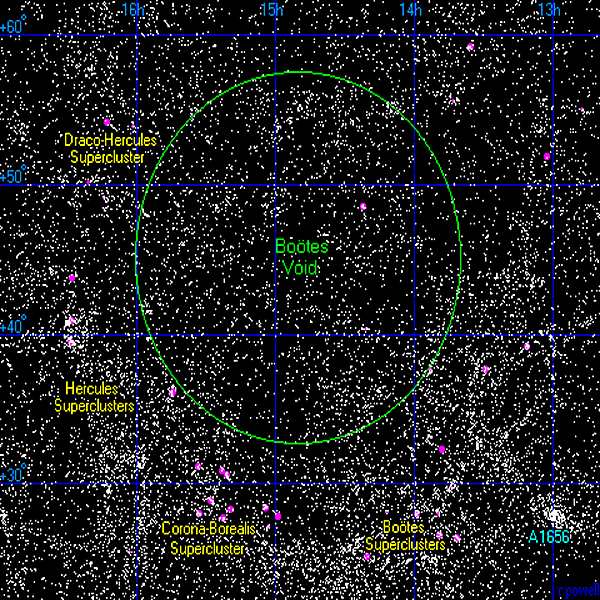 Boötes Void - A massive
mostly empty patch of the
universe discovered in 1981 by Robert Kirshner contains
extremely few galaxies. Images of Barnard 68, which is a
nebula cloud blocking stars and galaxies alike, are frequently
confused with Boötes. Galactically speaking, Boötes Void
is not that far away. Is something swallowing galaxies? Are we
on the menu? Boötes Void - A massive
mostly empty patch of the
universe discovered in 1981 by Robert Kirshner contains
extremely few galaxies. Images of Barnard 68, which is a
nebula cloud blocking stars and galaxies alike, are frequently
confused with Boötes. Galactically speaking, Boötes Void
is not that far away. Is something swallowing galaxies? Are we
on the menu?
-
Is This The Loneliest Galaxy In The Universe - by Ian
O'Neill / Space.com 19NOV15.
-
The Boötes Void Is The Emptiest Place In The Universe -
by Curiosity 13SEP16.
-
The Darkest Part Of The Universe - Boötes Void - by Yin
(Daniel) Duan / Labroots 12FEB19.
- Image: Bootes Void by Richard Powell (CC2.0)
Link |
|
|
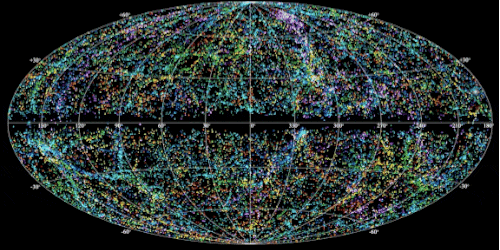 Cosmic Radio - A cosmological mystery called FRBs
(Fast Radio Bursts) has been getting increasing attention.
These short duration transient pulses, also
called Lorimer bursts, were discovered in 2007 by Duncan Lorimer.
Since then, many more examples have been found. Nascent
artificial intelligence has joined in the search helping to sift
through oceans of data. Cosmic Radio - A cosmological mystery called FRBs
(Fast Radio Bursts) has been getting increasing attention.
These short duration transient pulses, also
called Lorimer bursts, were discovered in 2007 by Duncan Lorimer.
Since then, many more examples have been found. Nascent
artificial intelligence has joined in the search helping to sift
through oceans of data.
FRBs are calculated to come from distant origins far outside
the Milky Way galaxy. During the journey, the signals
spread out causing longer wavelengths to arrive slightly later
than shorter wavelengths. The longer the journey, the more
pronounced the spread. FRB's are scattered across the sky
perhaps occurring as frequently as once per second. Some multiple bursts
have been observed originating from
the same direction. These are known as repeaters.
Among repeaters, at least one has been found to be on a regular
16 day cycle, while others are found having major bursts followed by smaller amplitude signals.
With the detection of these weaker signals, it is possible we
will find most or all FRB's repeat.
Mainstream theories are, of course, orbiting around Neutron
Stars or Black Hole collisions, but this type of theory can not
explain repeating sources. Hypothetical events emanating
from these theoretical space monsters are becoming too often the
trendy gremlin blamed for new space oddities. Physical
sources for FRB have been inferred rather than observed thus far.
A different theory is that we are
perhaps catching a glimpse of the business
end of alien spaceship's M Drives. Others have noted a
generally similar spacing between many FRB's and
have suggested they could be something akin to navigation beacons similar to GPS but on intergalactic scales. XRB's (X-Ray Bursts) are
a thing too, adding yet another variant to these glimmering
mysterious twinkles in the sky.
Recent studies have demonstrated plasma lensing in the
intergalactic medium is dispersing these signals to a greater
extent than previously understood, meaning FRB are closer than
we thought, with some perhaps coming from within our galaxy.
This discovery has inspired The Grendelcat to come up with a
theory of his own. If the dispersion measure is skewing
our distance estimates, the converse should also be true that
distance and the amount of aggregate intervening material in the
dusty plasma of space define the amount and type of dispersion
seen in each signal. If wise space travelers had a good
map and knew the actual location of these beacons and/or the
actual time the signals were sent, FRBs could be used not only
to calculate precise position, but the dispersion measure from
each beacon would also reveal the amount of intervening stuff in
the way. This would be vital information for a spaceship
plotting a course toward one of these beacons. It could
aid in calculating required propulsion adjustments needed to
overcome the friction of what's in between in order to nail the
light speed jump, or whatever, instead of ending the transit
light years too soon or too late.
-
M Drives - by Steven Proctor / Segment Film Productions
(YT)
12MAR17.
-
Harvard Scientists Theorize That Fast Radio Bursts Come From
Alien Space Travel - by Megan Watzke & Peter Edmonds /
Harvard 09MAR17.
-
A Repeating Fast Radio Burst - by Victoria Kaspi & Dr.
Shriharsh Tendulkar / McGill University 10JAN18.
-
Gravitational lensing by magnetized compact object in the
presence of plasma - by Bobur Turimov et al. / JCAP 12FEB18.
It is plasma doing the lensing, not gravity.
-
Artificial Intelligence Helps Find New Fast Radio Bursts -
by Dr. Andrew Siemion / SETI Institute 10SEP18.
-
Fast Radio Bursts: A Mystery Unfolds - by Deborah Byrd /
Space 10JAN18.
-
Is It Aliens? Scientists Detect More Mysterious Radio Signals
From Distant Galaxy - by Jeremy Hau / NBC 24SEP18.
- An FRB's
Journey To Earth - by ICRAR 08OCT18.
- Study
that includes a map of all known FRB sources so far:
One Or Several Populations Of Fast Radio Burst Sources - by
Caleb, Spitler & Strappers / JBC For Astrophysics & Max Planck
01NOV18.
-
A New Signal for a Neutron Star Collision Discovered
-
by Lee Mohon / NASA 16APR19.
-
A
Living Theory Catalogue for Fast Radio Bursts - by Platts,
Weltman, Walters, Tendulkar, Gordin, Kandhai 07JUN19.
-
Mysterious Extragalactic Flash Pinpointed for 2nd Time Ever
- by Mike Wall / Space.com 27JUN19.
-
CHIME/FRB Detection Of 8 New Repeating Fast Radio Burst Sources
(Draft) by E. Fonseca / McGill University 12AUG19.
-
Astronomers Have Tracked a Repeating Radio Signal Across Space
to an Unexpected Origin - by Michelle Starr / Science Alert
07JAN20. The proximity of this repeater is a problem for
theories about how FRBs are triggered.
-
Origin of Deep-Space Radio Flash Discovered, and It's Unlike
Anything Astronomers Have Ever Seen - by Adam Mann /
Space.com 08JAN20.
-
Periodic activity from a fast radio burst source - by
CHIME/FRB Collaboration / Cornell 28JAN20.
-
The Effects of Plasma Lensing on the Inferred Dispersion
Measures of Fast Radiobursts - by Er et al. / American
Astronomical Society 04FEB20.
-
Mysterious Signals Hint That Fast Radio Bursts Are More Active
Than We Thought - by Michelle Starr / Science Alert 06FEB20.
-
Powerful Radio Signal From Deep Space Appears to Be Repeating in
a 16-Day Cycle - by Michelle Starr / Science Alert 10FEB20.
-
Noise-Induced Magnetic Field Saturation in Kinetic Simulations
- by J. Juno et al. / Plasma Phys. 15APR20.
-
Sub-second periodicity in a fast radio burst - by Bridget C.
Andersen et al. / Nature 13JUL22.
- Image: FRB by NRAO Outreach (Fair Use)
Link |
|
|
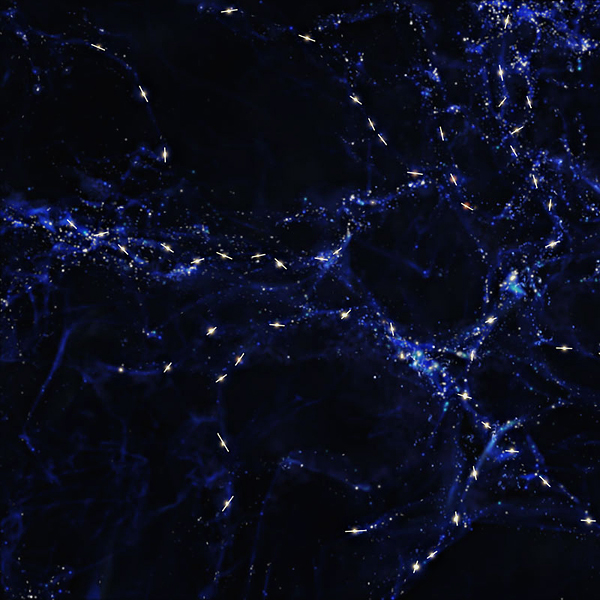 Quasar Alignments
- Quazars, blazars and radio galaxies are distant galaxy sized
objects that are the same type of celestial forms which are
classified differently based on tilt. Alignments found among
these objects in deep surveys are mysterious and fascinating,
though examples have been known for some time. These
quasars are found to be aligned and apparently maintaining this
alignment over billions of years across vast distances.
This points to an organizing force in our universe that we
simply have yet to fathom. Many theories have been bandied
about to explain this phenomenon, but none have gained
widespread acceptance. Quasar Alignments
- Quazars, blazars and radio galaxies are distant galaxy sized
objects that are the same type of celestial forms which are
classified differently based on tilt. Alignments found among
these objects in deep surveys are mysterious and fascinating,
though examples have been known for some time. These
quasars are found to be aligned and apparently maintaining this
alignment over billions of years across vast distances.
This points to an organizing force in our universe that we
simply have yet to fathom. Many theories have been bandied
about to explain this phenomenon, but none have gained
widespread acceptance.
-
Spooky Alignment of Quasars Across Billions of Light-years
- by the ESO 19NOV14.
-
Why Are These Supermassive Black Holes Aligned? - by Russ
Taylor / Cosmos 12APR16.
-
Detection of
Multiple Spin Axes Alignment in Deep Field Survey of
Radio-active Galaxies - by William Brown / HIUP 23JAN17.
-
Quasar Tsunamis Rip Across Galaxies - Claire Andreoli, Ann
Jenkins/Ray VIllard, Nahum Arav / NASA 19MAR20.
-
A Gamma-Ray Emitting Relativistic Jet Hosted in a Galaxy Merger
- by Vaidehe S. Paliya et al. / Astrophysical Journal 07APR20.
La Palma telescopes participate in the discovery of a young
blazar produced by the merger of two galaxies.
- Image: Quazar Alignments by European Southern Observatory / M.
Kornmesser (CC4.0)
Link |
|
|
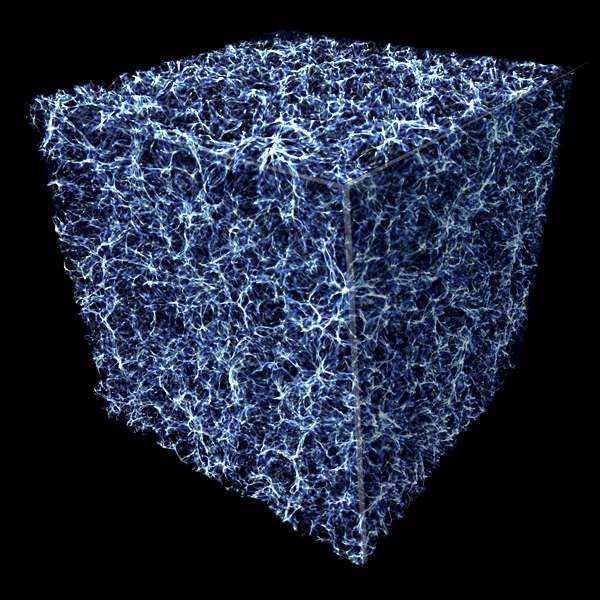 The Cosmic Web
- Stunning organized filament structures have been discovered
connecting the galaxies of the universe. These formations are mapped as galactic superclusters
and are possibly assembling themselves in motions toward one of
two polar opposing great attractors. The Cosmic Web
- Stunning organized filament structures have been discovered
connecting the galaxies of the universe. These formations are mapped as galactic superclusters
and are possibly assembling themselves in motions toward one of
two polar opposing great attractors.
Our own supercluster, Laniakea breaks down more locally to
our neighboring Virgo and Fornax superclusters which contrast in
their comportment
relative to other neighboring superclusters like Hydra-Centaurus
because they are being repelled/attracted to different great
attractors.
Visible filament structures are also ubiquitous in star
forming regions within the galaxies. The chaotic web of
filaments often appear uniform in breadth with the stars forming
upon them at relatively equally spaced intervals
along the string. Enormous gas structures have been found
spiraling inward toward newly forming galaxies in what could be
an elegant example of the Fleming's right hand rule for
generators at galactic scales.
-
Our First Glimpse of the Web that Connects All Galaxies
- by
George Dvorsky / Gizmodo 21JAN14.
-
New Galactic Supercluster Map Shows Milky Way's 'Heavenly' Home
- by Charles Q. Choi / Space.com 03SEP14.
-
Galaxy alignments: Observations and impact on cosmology - by
Donnacha Kirk et al. 08JAN16.
Easier read.
-
Intergalactic plasma filaments confirmed?
-
by TW / The Watchers 03NOV17.
-
The Chaotic Web Of Filaments In A Milky Way Stellar Nursery
-
by ESA 26MAR18.
-
Assembly of massive galaxy cluster witnessed for the first time
- by Simons Foundation / Science Daily 25APR18.
-
Hubble’s Galaxy Cluster Cornucopia - by Karl Hillie / ESA/Hubble
& NASA 25MAY18.
-
All about the Virgo Supercluster - by Liz Kruesi / Astronomy
22FEB19.
-
'Finding Our Place in the Universe' Details Quest for Earth's
Supercluster: Author Q&A - by Marcus Banks / Space.com
21MAY19.
-
In a first, magnetic fields have been spotted between two galaxy
clusters - by Maria Temming / Science News 06JUN19.
-
Multi-filament gas inflows fuelling young star-forming galaxies
- by D. Christopher Martin et al. / Nature 01JUL19.
-
There's a Huge Void Near Our Galaxy. Its Mysterious Depths Have
Just Been Measured - by Evan Gough / Universe Today 23JUL19.
-
Astronomers spot the filaments of gas that feed the galaxies
- by Adrian Cho / Sciencemag 03OCT19.
-
First sighting of hot gas sloshing in galaxy cluster - by
ESA / Phys.org 10JAN20.
-
A new moving group in the Local Arm - by Xilong Liang et al
/ NASA ADS 12MAR20.
-
Chemical Evolution of Galaxy Clusters: Dissecting the Iron
MassBudget of the Intracluster Medium - by Ang Liu et al. /
Astronomy & Astrophysics ESO 30MAR20.
-
Cosmic magnetic fields with MASCLET: an application to galaxy
clusters - by Vicent Quilis et al. / Universitat de València
30MAR20. Primordial fields.
-
Collimated synchrotron threads linking the radio lobes of ESO
137-006 by M. Ramatsoku et al. / Astronomy &
Astrophysics 09APR20. Electric currents link the galaxies.
-
The local-filament pattern in the anomalous transparency of the
Universe for energetic gamma rays - by Sergey Troitsky /
Russian Academy of Sciences 17APR20. We are in the middle
of our filament with the Virgo and Fornax clusters being our
neighbors in the cosmic queue.
-
. . . Filaments are cold and associated with dark molecular gas
- by P.M.W. Kalberla et al. / Astronomy & Astrophysics 01MAY20.
Dark H2 distribution.
-
Astronomers Spot Farthest Galaxy Known In The Universe - by
Keck Observatory 15DEC20.
- Image: Universe Cube by NASA, ESA, and E. Hallman (University
of Colorado, Boulder) (Public Domain)
Link |
|
|
|
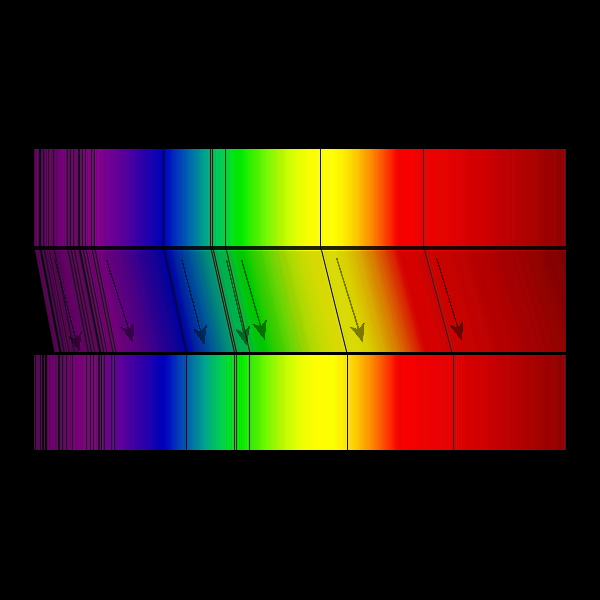 Measure This
- Measurements for archeological age determination using radiocarbon
dating and interstellar distance/age measurement techniques using
spectral analysis have long been
pillars of science widely considered highly accurate and reliable.
However, flaws are evident for both principles calling into question
libraries of studies and legions of models. Measure This
- Measurements for archeological age determination using radiocarbon
dating and interstellar distance/age measurement techniques using
spectral analysis have long been
pillars of science widely considered highly accurate and reliable.
However, flaws are evident for both principles calling into question
libraries of studies and legions of models.
Redshift uses the
Doppler effect upon the spectrum of light from distant sources
to identify the shift that the light has undergone across the
spectrum. Using the amount of shift, the motion relative
to our point of reference is determined and the distance the
light traveled and age of the transmission are calculated.
To determine the amount of redshift, bands of specific isotopes
provide unmistakable signatures demonstrating convincingly that
this color shift does occur. The individual element signatures
wandering through the spectrum are solid proof. But across galactic distances,
there may actually be a bit more to it. The universe,
perhaps modest about some of her shapely curvatures, may be fudging
some of those measurements.
William Tifft was the original investigator who
identified the existence of a redshift-magnitude banding
correlation noting, "redshift has properties inconsistent with a
simple velocity and/or cosmic scale change interpretation". Halton Arp
further questioned
interpretation of red shift in interstellar observations in
Seeing Red published in 1998.
Excerpt. A key problem Halton focuses on for red shift
interpretation is that measurement results are clumped together
rather than evenly dispersed representing all of the different
angles and speeds of measured objects in the universe.
This problem is now referred to as
Redshift Quantization and is a concept widely dismissed or
ignored by mainstream science, and yet the problem remains with
no convincing explanation.
There is a related problem in the science of star age
determination. In addition to using redshift of known
elements in the spectrum to determine distance, the spectral
analysis also reveals the elemental composition of the star.
There is debate and much investigation into how emissivity and
cloaking may mask the presence of elements in a star, but the
spectral signatures of stars are undeniably like fingerprints.
After analyzing a lot of these star fingerprints,
classifications of typical star compositions came next.
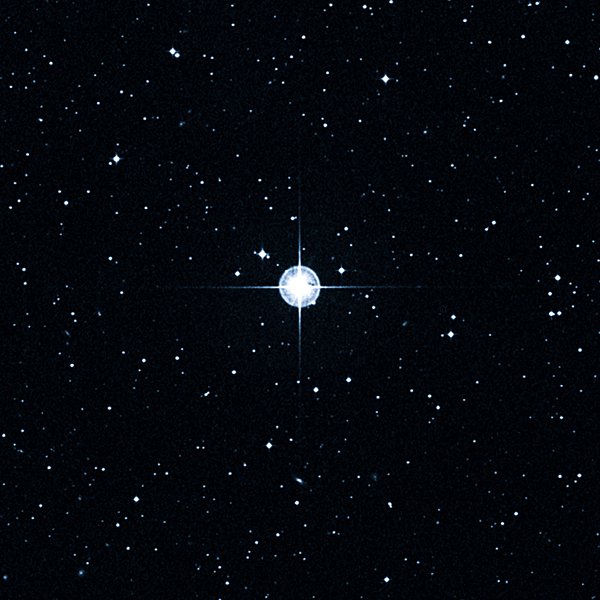 We've found trends among the elemental distributions we see
from the shiny things out there. The key trend is the
proportion of heavier elements revealed in the star's spectrum.
Stars found to have more heavy elements are thought to be
younger and those found with nearly none are thought to be
older. This is based on the theories of how heavy elements
are created and recycled as the universe developed following the
big bang. In standard cosmology, Population 1 stars
forming initially only had hydrogen and helium to work with.
After those stars went supernovae they generated heavy elements
and blasted them into the cosmos. So we expect to see
increasing
metallicity in the child star's compositions following each
Phoenix-like cycle of star death and rebirth, categorized as
star
populations.
We've found trends among the elemental distributions we see
from the shiny things out there. The key trend is the
proportion of heavier elements revealed in the star's spectrum.
Stars found to have more heavy elements are thought to be
younger and those found with nearly none are thought to be
older. This is based on the theories of how heavy elements
are created and recycled as the universe developed following the
big bang. In standard cosmology, Population 1 stars
forming initially only had hydrogen and helium to work with.
After those stars went supernovae they generated heavy elements
and blasted them into the cosmos. So we expect to see
increasing
metallicity in the child star's compositions following each
Phoenix-like cycle of star death and rebirth, categorized as
star
populations.
This has led to a situation where
sometimes stars are calculated to be forming before such objects
should be able to form in standard cosmology models. The
Methuselah Star, living here in our own stellar neighborhood
about 200 light years away, is one of several examples with an
estimated age of 14.5 billion years old
± 0.8 billion. This
same problem of finding stuff that appears to be older than when
all stuff was supposedly created is found with super-massive
objects much further away as well. There is overlap in the
uncertainty range for the oldest possible theoretical age of the
universe and the youngest age interpretations for these
hyper-ancient objects, so this isn't an impossible circumstance.
But this problem does challenge the standard models and
highlights the level of uncertainty in these estimates.
Adding to this uncertainty is evidence that elements are also
created in planet interiors including Earth itself. So
far, elements only up to iron have been demonstrated to be
produced in this way. But as investigation expands, it may
only be a matter of time before we find heavier elements
created in regular stars like our sun. This might help
explain the full elemental spectrum we receive in the solar
wind. With planetary plasma core element formation a
feasibility, the concept of heavy elements exclusively being generated by supernova
is standing on sketchier ground. If this model falls, in turn,
this would
cause all of the current trendy models for the timeline of our
universe following the big bang to be rendered obsolete.
The universe is being stingy about revealing her age. Two different but widely accepted
methods for achieving an accurate measurement for the age of the
universe have been diligently honing in on the magic number.
Both derive from the Big Bang theory and have the answer at
around 13.7 billion years. Unfortunately, they have
diverged in their result as they have narrowed to more accurate
measurements, meaning one or both of them are incorrect.
Method 1 - CMBR (Cosmic Microwave Background Radiation) is
measured by the Planck ESA Space Observatory and uses a
theoretical predicted point at which the universe would have
cooled enough about 380,000 after the big bang to allow neutral
hydrogen atoms to form and to produce light without scattering.
Method 2 - The Hubble-LeMaitre Law is being used by the Hubble
space observatory to measure the age of the universe by using
galactic motion and redshift to plot backwards to the big bang.
There is hope that more data from LIGO, which uses General
Relativity predictions to detect gravity fluctuations
propagating from vibrations that occur when black holes rub
elbows may provide the tie-breaker.
Assuming LIGO's findings mean what they think, the
estimate is 5 more years of data needed to determine the victor
in Planck v. Hubble.
A different problem engulfing the big bang is about all the
noise from it's colossal inception, or rather, the lack thereof.
About 3 Kelvin worth of Cosmic microwave
background radiation is a fundamental pillar of evidence for the
big bang. Efforts to obtain measurements have included the
PLANCK and WMAP satellites from the L2 Lagrange point, the COBE
satellite, rockets, balloons and immense ground based antennas.
P.M. Robitaille contends that the most accurate measurement of
all came from a famous antenna built to have the least ambient
noise possible using extremely stringent calibration methods.
The Herouni antenna's background radiation measurements were so
carefully determined that unexplained background radiation in
the universe appears to have dropped to nearly 0.
If this measurement is correct it could mean the universe is
mellower than we thought. But for this to be the case,
causes of the extra background radiation in the other
measurements need to be identified. P.M. Robitaille points
to the possibility that for ground, rocket, and balloon
measurements, these instruments were subjected to defracted
signals from the oceans and other large bodies of water.
He further notes WMAP was not built to measure background
radiation at all, only differential. PLANCK was also
unable to report a finding of its own due to design flaws and
had to use ground antenna data in what analysis it could
provide. If the Herouni findings are replicated in future
measurements, this could dispel the ghost of the big bang
definitively. Efforts to fund refurbishment of Herouni to
resume operations are underway, as are other methods being
pursued to try taking an uncontaminated temperature
of the universe.
-
Carbon 14 corrections - by Thomas Higham.
-
A Measurement of Excess Antenna Temperature at 4080 Mc/s
- by Penzias, A. A. & Wilson, R. W. / Astrophysical
Journal 01JUL65.
-
WMAP: A Radiological Analysis - by P.M. Robitaille / Sky
Scholar (YT) 01JAN07.
-
Water, Hydrogen Bonding and the Microwave Background -
by P.M. Robitaille / Sky Scholar (YT) 01APR09. How the
Oceans may be adding CBR noise attributed to the big bang in
near earth and earthbound observations.
-
COBE: A Radiological Analysis - by P.M. Robitaille / Sky
Scholar (YT) 01OCT09.
-
The Planck Satellite LFI and the Microwave Background:
Importance of the 4 K Reference Targets - by P.M.
Robitaille / Sky Scholar 01APR10.
-
Hubble Finds Birth Certificate Of Oldest Known Star - by
NASA / Hubble 07MAR13.
-
The Big Bang Proven Wrong By Halton Arp On The Intrinsic Red
Shift - by Halton Arp on You Tube 19JUN14.
-
The Only Three Heavy Elements In The Universe That Aren't
Made In Stars - by Ethan Siegel / Forbes 01JUL15.
-
Paper Spotlights Key Flaw In Widely Used Radioisotope Dating
Technique - by Robert B Hayes, North Carolina State
University
/ Science Daily 31JAN17.
-
The Cosmological Constant And The Redshift Of Quasars and
A New Non-Doppler Redshift
- by Paul Marmet / Newton Physics 15JAN18.
-
Radio Carbon Dating
- by Grahame Johnston / Archaeology Expert
10FEB18.
-
Gravitational Cosmic Redshift with Variable Light Speed
- by
Raymond HV Gallucci, PhD, PE / Principia Scientific 15MAR18.
-
New Radiocarbon Cycle Research May Alter History
- by Daniel
Aloi / Cornell Chronicle 01JUN18.
-
A Crucial Archaeological Dating Tool Is Wrong, And It Could
Change History as We Know It - by Mike McRae / Science Alert 06JUN18.
-
Measuring The Age Of The Universe
- by Harvard 17OCT18.
-
Scientist Finds Elusive Star With Origins Close To Big Bang
- by Johns Hopkins University 05NOV18.
-
The Herouni Antenna - The Death of the Big Bang! - by
P.M. Robitialle / Sky Scholar (YT) 02FEB19.
- Unfortunately as more data arrives, the
universe age disagreement appears to keep
getting worse.
Mystery of the Universe’s Expansion Rate Widens With New Hubble
Data - by NASA 25APR19.
-
Cloaked Black Hole Discovered In Early Universe Using NASA's
Chandra - by NASA / Chandra. 08AUG19. This breaks
the standard paradigm in that nothing this large with this
spectral composition should be able to form this soon
relative to the big bang in the current models.
-
Metal enrichment in the circumgalactic medium and Lyα haloes
around quasars at z ~3 - by Yucheng Guo et al. /
KIAA-PKU, KICC-Cambridge) 16JAN20.
-
Figuring Out Gas & Galaxies in Enzo (FOGGIE). III. The Mocky
Way: Investigating Biases in Observing the Milky Way's
Circumgalactic Medium - by Yong Zheng et al. / 23JAN20.
-
DAMPE proton spectrum indicates a slow-diffusion zone in the
nearby ISM - by Kun Fang et al. / 31MAR20. The
fields engulfing us mess with our measurements. We
can't see the forest for the trees.
-
Warm dust in high-zgalaxies: origin and implications -
by L. Sommovigo et al. / 22APR20. More hiding stuff
out there - this time it's the revelation that 40% of UV of
newly born stars is obscured by dust.
-
Irregular Appearances of Glacial and Interglacial Climate
States - by Köhler, P., van de Wal, R.S.W. / ANI
26OCT20.
-
Uncertainties in Galaxy Rotation Curves - by J.A.
Sellwood et al. / arxiv preprint 08JAN21.
-
Earth factories: Creation of the elements from nuclear
transmutation in Earth’s lower mantle - by Mikio
Fukahara et al. / AIP Advances 12OCT21.
-
Extreme Value Statistics of the Halo and Stellar Mass
Distributions at High Redshift: are JWST Results in Tension
with ΛCDM? - by Christopher C. Lovell et al. / Cornell
Astrophysics 22AUG22.
-
- 1st Image: Redshift by Georg Wiora (Dr. Schorsch) (CC2.5)
Link
- 2nd Image: Methuselah Star by Digitized Sky Survey (DSS),
STScI/AURA, Palomar/Caltech, and UKSTU/AAO (Public Domain)
Link |
|
|
|
 Throwing
Some Shade On Dark Matter & Black Holes - The relativity shakeup continues.
Einstein himself, inventor of the concept of dark matter, eventually concluded that the invocation of dark matter
was a mistake. But the notion continues to expand like "The
Blob", ever increasing the theoretical scope and majesty of all this
undetectable dark matter and energy. Throwing
Some Shade On Dark Matter & Black Holes - The relativity shakeup continues.
Einstein himself, inventor of the concept of dark matter, eventually concluded that the invocation of dark matter
was a mistake. But the notion continues to expand like "The
Blob", ever increasing the theoretical scope and majesty of all this
undetectable dark matter and energy.
~68% dark energy, ~27%
dark matter,
~5% normal matter
-
NASA (16OCT17) ||
CERN (16OCT17)
Dark matter and energy
are fudge factors to get cosmology models to look like reality, along with other famous fudge factors called
Einstein's cosmological constant (Λ) (WIKI) and Hubble's
constant (H0). Here is a short piece by NASA
describing how discrepancies found using better observations are
leading mainstream scientists to question some of the most
fundamental aspects of cosmology modeling.
Hubble's Contentious Constant (H0) by NASA
20SEP17. Now that NASA and CERN have declared 95% uncertainty
about what's happening out there, it is time to consider
some other approaches.
Similarly, the math of black holes has also progressed through
rationality challenges that have not been satisfactorily resolved.
More than nearly any other hypothetical construct, black hole models
are theory represented as fact. For decades, popular science
has been trumpeting black hole headlines as if astrological bodies called black holes have been
pinpointed and measured and that they are understood to exhibit predicted behaviors. Black holes are not measured, and
in the places we expect to find them, whatever is there is tossing out all sorts
of surprises.
The
Event Horizon earthbound telescope array sifted through an
enormous amount of data to produce a portrait of a black hole.
The procedure used
questionable filtering and image enhancement to get to the iconic orange
doughnut that's been paraded around. This blurry smudge could be nothing but an uncorrected image enhancement
artifact (First
Image of a Black Hole Named Science’s 2019 Breakthrough of the Year
- by American Association For The Advancement Of Science /
ScieTechDaily 30DEC19).
Dark matter and energy,
along with black holes derive from the same theoretical building
blocks: particle physics, quantum mechanics, and at the heart of it
all, gravity. It has been pointed out
that the theory of
gravity is not really an operative theory at all in a sense that a
theory should explain how something works and what causes it.
Gravity is merely a measurement methodology with a formula
describing anticipated results. This works fantastically to
get rocket ship A to solar object B, but it does not explain why objects A and B are where and what they are,
or the motions of things we can see beyond our solar neighborhood.
Reliance on theoretical particle physics and quantum theory to math our way to
understanding has led to an increasing divergence between models and
observation. This in turn has encouraged reliance upon more and more hypothetical dark
matter and energy in the revised calculations.
Plasma theoretical models have no such
problems and are readily able, at least thus far in the progression
of the science, to explain what we are seeing. That said, a big part of
this may turn out to be a whole lot of regular material we weren't
seeing. Huge baryon, dust and gas clouds recently discovered are
starting to replace segments of theorized dark matter to explain
galactic angular motion. Plasma universe proponents also theorize
that a missing piece of the solution to these mysteries is
electromagnetic in nature. Both in the way massive clouds of
matter can hide from detection and in the way electromagnetic
fields and particle flows directly define the otherwise inexplicable
motions of and within the galaxies. Other mainstream theories like
Accretion as the mechanism creating stars and planets over
millions of years in a slow and static universe are opposed by
plasma derived theories like
Z-pinch (Wiki) where stars might be created in electromagnetic
filaments.
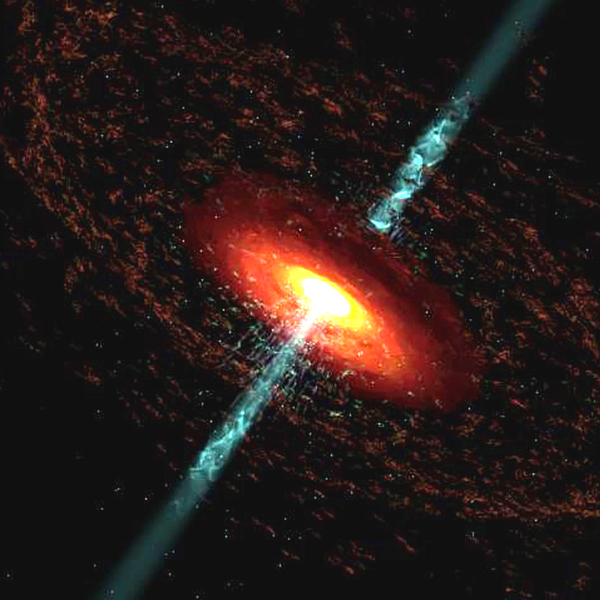 Some revere Vera Rubin as the mother of dark matter. To
others, she is reviled for crippling the progression of plasma
science with her fixation on dark matter to model the problem.
Either way, she proved something was missing in our comprehension of
angular motion at galactic scales and beyond. Increasingly
accurate measurements have been taken of the cosmological behaviors
which elude understanding using established principles. This
tremendous discovery rocked cosmology to its foundations. Vera deserves her
LSST
telescope namesake. It could be the tool
that ends the debate one way or the
other. Beyond the Verascope, the
JWST
(James Webb Space Telescope) is capturing stunning deep field
resolution images. The ESA's
Euclid has also joined the deep peering hunt for what their
official mission statement explicitly describes as "the composition
and evolution of the dark Universe". The expectation is that
they will be "revealing more about the role of gravity and the
nature of dark energy and dark matter." These magnificent
tools have delivered truly awesome imagery of deep space structures
which defy known physics and expose our limited comprehension of the
universe's playbook. Alas, in the eye candy so far, no clear
portraits are to be found of "Dark" matter and energy. For
now, their wanted posters remain merely featureless silhouettes.
Some revere Vera Rubin as the mother of dark matter. To
others, she is reviled for crippling the progression of plasma
science with her fixation on dark matter to model the problem.
Either way, she proved something was missing in our comprehension of
angular motion at galactic scales and beyond. Increasingly
accurate measurements have been taken of the cosmological behaviors
which elude understanding using established principles. This
tremendous discovery rocked cosmology to its foundations. Vera deserves her
LSST
telescope namesake. It could be the tool
that ends the debate one way or the
other. Beyond the Verascope, the
JWST
(James Webb Space Telescope) is capturing stunning deep field
resolution images. The ESA's
Euclid has also joined the deep peering hunt for what their
official mission statement explicitly describes as "the composition
and evolution of the dark Universe". The expectation is that
they will be "revealing more about the role of gravity and the
nature of dark energy and dark matter." These magnificent
tools have delivered truly awesome imagery of deep space structures
which defy known physics and expose our limited comprehension of the
universe's playbook. Alas, in the eye candy so far, no clear
portraits are to be found of "Dark" matter and energy. For
now, their wanted posters remain merely featureless silhouettes.
Back in the particle physics labs is where
dark matter's sore spot is developing perhaps most keenly.
There have been a steady stream of expensive accelerator experiments
and fine tuned particle searches. Instead of confirming a
particle's discovery at the conclusion of these studies along with
the model that predicted it, new limitations on possibilities
remaining for the elusive particle are declared. Cold dark
matter models are falling faster than
adjusted models using new fudge factors can be introduced.
Could electromagnetic forces and plasma interactions be the missing ingredients defining our
universe? With every particle expedition goose
egg, this possibility seems more viable.
When white-coat clad maverick scientists calmly assure us that their experimentation on the
bleeding edge is well
enough understood to ensure we don't create a spontaneous rip in
space time or a resonance cascade (Black
Mesa mishap - by Dr.Gordon Freeman / MIT (YT) 06MAY03.) or
send our planet careening out of the solar system or into the
sun, you might want to check their math. If Big Bangs,
Dark Matter, Dark Energy, Black Holes or Neutron Stars are
invoked, some important leftover pieces of the ACME Discovery
Contraption might have been left forgotten on the floor.
At this point, we might consider heading for the hills, or
preferably, heading out from the cradle of our solar system to
find far away places
to dwell. Then there would at least be a possibility of
sidestepping the horrifying
Fermi Paradox possibility that the reason we don't see a bunch
of life in the universe is because it tends to wipe itself out at a
point in technological development prior to interstellar
colonization. The concept of some universal physics-based
booby trap that trips up most wannabe space-faring civilizations
is sometimes called the Great Filter. It is a level of
development our civilization appears to be very close to
right now. (The Vulnerable World Hypothesis by Nick Bostrom.
Observational Constraints on the Great Filter - by Jacob
Haqq-Misra / Astrobiology 18FEB20).
-
Cosmos: The Big Bang - by Science For The Public (modern science
for modern citizens). Starting here for a mainstream
benchmark.
-
Pinch
- by plasma-universe.com.
- National Radio
Astronomy Observatory (NRAO).
-
Plasma Z-pinch by everythingselectric.com 24OCT15.
-
Stealth black hole found lurking in the Milky Way - by Belinda
Smith and Viviane Richter / Cosmos 30JUN16.
-
How Vera Rubin confirmed dark matter - by Sarah Scoles /
Astronomy 04OCT16.
-
Black Hole Models Contradicted By Hands-on Tests At Sandia’s Z
Machine - by Sandia National Laboratories 28AUG17. Resonant Auger
Destruction, a key precept in Black Hole theories for 20
years, has been debunked. Turns out if iron doesn't give off
photons near the edge of a black hole like silicon, that means it
isn't there.
-
Dark Matter is Dead | The Missing Matter - by Suspicious
Observers 10OCT17.
-
The Dark Matter Fail - by Ben Davidson / Suspicious Observers 24NOV17.
-
Dark matter and dark energy: Do they really exist? - by Anthony
Watts / WUWT 25NOV17.
- Spiral
Galaxy Rotation Curves Without Dark Matter or MOND - by Tarun
Biswas / State University of New York at New Paltz 30JAN18.
-
XENON1T Experimental Data Establishes Most Stringent Limit On
Dark Matter - by Rensselaer Polytechnic Institute 29MAY18.
-
XENON1T Takes A Razor To A Dark E6 Inspired Model - by Science
Direct 10NOV18. Even more most stringent limits.
- Search for dark matter in the form of hidden photons and
axion-like particles in the XMASS detector - by Cornell University Library 23JUL18.
More limits.
-
Is Dark Matter Needed in Galaxies? - by Irina Rozgacheva,
Alexander Agapov / Astronomy Reports 01SEP18.
-
More constraints of wimps by XMASS, still no dark matter to be
found
abstract 14SEP18.
-
Quantum Theory Cannot Consistently Describe The Use Of Itself
- by Daniela Frauchiger & Renato Renner / Nature.com 18SEP18.
-
Figuring Out Gas & Galaxies in Enzo (FOGGIE) I. Resolving Simulated
Circumgalactic Absorption at 2 < z < 2.5 - by Peeples et al. /
astro-ph.G 15OCT18.
- Cosmic Collisions:
SOFIA Unravels the Mysterious Formation of Star Clusters - by
Nicholas A Veronico / NASA 06NOV18.
-
Figuring Out Gas & Galaxies in Enzo (FOGGIE). II. Emission from the
z=3 Circumgalactic Medium - by Peeples et al. / astro-ph.G
13NOV18.
-
The missing light of the Hubble Ultra Deep Field - Alejandro
Borlaff et al. / A&A 21JAN19.
-
Dark matter may not actually exist – and our alternative theory can
be put to the test - by Juri Simirnov / The Conversation
31JAN19.
-
How Scientists Captured the First Image of a Black Hole - by Ola
Lutz / JPL 19APR19.
-
Vera Rubin: The Astronomer Who Brought Dark Matter to Light - by
Tim Childers / Space.com 11JUN19.
-
Kinematics of Circumgalactic Gas: Feeding Galaxies and Feedback
- by Crystal L Martin et al. / The Astrophysics Journal 18JUN19.
-
Cool halo gas caught spinning like galactic disks - by Keck
Observatory 18JUN19.
-
What Is Dark Matter? - Nola Taylor Redd / Space.com 19JUL19.
-
Constraints On Dark Matter Annihilation In Dwarf Spheroidal Galaxies
From Low Frequency Radio Observations - by APS 01AUG19.
Not just limits, but running out remaining viable places to look
too.
-
ALMA Identified Dark Ancestors of Massive Elliptical Galaxies - by
ALMA Observatory 07AUG19. Vast numbers of previously hidden
galaxies not predicted in standard big bang / cold dark matter
models.
- On the
orientation of the crescent image of M87 - by Nalewajko et al /
Cornell 27AUG19.
-
Providing A Solution To The Worst Ever Prediction In Physics
[The Cosmological Constant] - by Lucas Lombriser / University Of
Geneva 28AUG19.
-
Discovery of a Very Hot Phase of the Milky Way Circumgalactic Medium
with Non-solar Abundance Ratios - by Sanskriti Das et al. /
Astrophysics Journal Letters 01SEP19.
-
Claims of a Black Hole Image: the Day Astrophysics Died - by P.
M. Robitaille / Sky Scholar (YT) 29SEP19.
-
On the Absence of Dark Matter in Dwarf Galaxies Surrounding the
Milky Way - by Francois Hammer et al. / Astrophysics Journal
01OCT19.
-
A Crisis In Cosmology
- by W.M. Keck Observatory / Phys.org 23OCT19.
-
. . . A New Class Of Black Holes - by Laura Arenschield / OSU
31OCT19. Yet another interesting solution to the missing
matter problem suggesting hiding black holes may be the explanation.
-
SHARP New constraints on the dark matter free-streaming properties
and substructure abundance from gravitationally lensed quasars -
by Jen-Wei Hsueh et al. 01NOV19.
-
Strong New Limits On Light Dark Matter From Neutrino Experiments
-
by Christopher V. Aappiello and John F. Beacom / Ohio State
14NOV19.
-
19 Galaxies Are Apparently Missing Dark Matter. No One Knows Why.
- by Rafi Letzter / Space.com 05DEC19.
-
Detection Of Missing Baryons In Galaxy Groups - by Lim et al.
21DEC19. More missing matter found. Particularly of
interest because this shows that the missing matter at galactic
scales isn't homogenously dispersed but concentrated along flowing
filament currents.
-
The Turbulent Life of Two Supermassive Black Holes Caught in a
Galaxy Crash - by NRAO 05JAN20. Could also be interpreted
as a plasma stream between them. Whatever it is, this is not
something black holes are supposed to be able to do.
-
Famous black hole has jet pushing cosmic speed limit - by
Chandra X-Ray Center / Phys.org 07JAN20.
-
New evidence shows that the key assumption made in the discovery of
dark energy is in error - by Yonsei University / phys.org
06JAN20.
-
The Black Hole Image - Data Fabrication Masterclass - by P. M.
Robitaille / Sky Scholar (YT) 07JAN20.
-
Dark matter pioneer Vera Rubin gets a new observatory named after
her - by Emily Conover / Science News 10JAN20.
-
There is No Galactic Rotation Problem - by Ben Davidson /
Suspicious Observers 14FEB20.
-
SOFIA’s Infrared View of the Skies - by Kassandra Bell / NASA
06MAR20.
-
Cosmic Discordance: Planck and luminosity distance data exclude LCDM
- Joseph Silk et al. 10MAR20. 99% certainty the Lambda
Cold Dark Matter model is off the mark.
-
. . . in the GD-1 Stellar Stream: An Absence of Evidence for the
Influence of Dark Matter Subhalos? - by Rodrigo Ibata /
Astrophysical Journal 16MAR20.
-
Constraints on dark photons and axionlike particles from the
SuperCDMS Soudan experiment - by T. Aralis et al. / Physical
Review D 17MAR20. Axions and dark photons in SuperCDMS bite
the dust.
-
Chandra Data Tests "Theory of Everything" - by NASA/CXC/Univ. of
Cambridge/C. Reynolds et al. / CHANDRA 19MAR20. Time for a new axion
axiom.
- An
Effective Field Theory Analysis of the First LUX Dark Matter Search
- by Lux Collaboraton 24MAR20. Knocking down 14 dark matter
models in this single paper.
-
Green Bank and Effelsberg Radio Telescope Searches for Axion Dark
MatterConversion in Neutron Star Magnetospheres - by Joshua W.
Foster et al. / 31MAR20. Another axion goose egg.
-
Mirror-symmetry violation in bound nuclear ground states - by
UMASS Lowell / Nature 01APR20. Discovery challenges nuclear
theory.
-
Lowly Polarized Light from a Highly Magnetized Jet of GRB 190114C
- by N. Jordana-Mitjans et al. / Astrophysical Journal 02APR20.
The collapse of magnetic fields in distant cosmic explosions may be
what powers gamma ray bursts.
-
An ionised bubble powered by a proto-cluster at z = 6.5 - by IAC
08APR20. The galactic sphere of influence ionically speaking,
is much, much bigger than expected.
-
Universe's Expansion May Not Be The Same In All Directions - by
NASA/CXC/Univ. of Bonn/K. Migkas et al. 08APR20. Bye bye
isotropic and homogenous, hello shapely curvatures.
-
Doubts about basic assumption for the universe - by Bonn /
Harvard 08APR20. More about the lack of uniformity in the
cosmos.
-
Ultra-light Dark Matter Is Incompatible with the Milky Way's Dwarf
Satellites - by Mohammadtaher Safarzadeh and David N. Spergel /
Astrophysical Journal 09APR20. And another one bites the dust.
-
Neutrinos could shed light on why the Universe has so much more
matter than antimatter - by Nature 15APR20.
-
Matter–antimatter symmetry violated - by Silvia Pascoli &
Jessica Turner / Nature 15APR20.
- Dark Matter properties through cosmic history - by Stephane Ilic
et al. 20APR20. A review of the hilarious contortions of dark
matterists keeping this dying theory alive. According to this
paper the only way dark matter can exist is if its properties change
over time.
-
Relieving the Hubble tension with primordial magnetic fields -
by Karsten Jedamzik & Levon Pogosian / 20APR20.
-
New findings suggest laws of nature not as constant as previously
thought - by Lachlan Gilbert / UNSW Sydney 27APR20.
-
Predictions and Outcomes for the Dynamics of Rotating Galaxies -
by Stacy McGaugh / Case 29APR20. Nicely describes how dark
matter is so often used to explain observations within the models
MOND / ΛCDM but is not able to predict what will be found next.
-
Last Chance for WIMPs: Physicists - by Elizabeth Gibney / Nature
08OCT20.
-
The Closest Black Hole to Earth May Not Actually Be a Black Hole
After All - by Michelle Starr / Science Alert 20OCT20.
-
A massive blow for ΛCDM - the high redshift, mass, and collision
velocity of the interacting galaxy cluster El Gordo contradicts
concordance cosmology - by Elena Asencio et al. / Royal
Astronomical Society 01NOV20.
-
The CMB, Angular Power Spectrum, & Mathemagics - PM Robitialle
/ Sky Scholar 02NOV20.
Pierre-Robitaille Is Clueless - Professor Dave Explains 30OCT20.
A pathetic personal attack / debuunk attempt by this
rude loser (next autoplay by You Tube):.
Each pithy "counter-argument" offered by our greasy professor is
destroyed with PM's legendary counterpunch uppercut in
Pierre-Marie Robitaille Debunks "professor" Dave! - by PM
Robitialle / Sky Scholar 22NOV20. Bravo PM (and editing team),
Bravo!
-
BeyondPlanckVI. Noise characterization and modelling - by H.T.
Ihle et al. / astro-ph.CO 12NOV20. PM is
not alone. There is too much noise in
the Planck data indicating CMB polarization reconstruction is not a
reliable tool.
- The
coherent motion of Cen A dwarf satellite galaxies remains a
challenge for ΛCDM cosmology - by Oliver Müller et al. /
Astronomy & Astrophysics 15DEC20.
-
Cosmic Distances Calibrated To 1% Precision With GAIA EDR3
Parallaxes And Hubble Space Telescope Photometry Of 75 Milky Way
Cepheids Confirm Tension With ΛCDM - by Adam G. Riess /
Astronomy & Astrophysics 15DEC20.
-
Unique prediction of ‘modified gravity’ challenges dark matter -
by Stacy McGaugh / Case Western Reserve 17DEC20.
-
NASA Selects 4 Concepts for Small Missions to Study Universe’s
Secrets - by Tricia Talbert / NASA 08JAN21.
-
New Horizons Spacecraft Answers Question: How Dark Is Space? -
by Christine Pulliam / Hubblesite 12JAN21.
-
Cosmic physics mimicked on table-top as graphene enables Schwinger
effect - by University Of Manchester 28JAN22.
-
CMB Anomalies, the Integrated Sachs-Wolfe Effect, and the
Sunyaev-Zel'dovich Effect: What is Real?" - by PM Robitialle /
Sky Scholar 11FEB22.
-
Building a Model of the WMAP Satellite - FROM SCRATCH! - by PM
Robitialle / Sky Scholar 15FEB22.
- The jet
and resolved features of the central supermassive black hole of M 87
observed with EHT - Makoto Miyoshi et al. / Cornell Arxiv
10MAY22.
-
Three Honest Astronomer's Agree - The Black Hole Image is an
Artifact?! - by PM Robitialle / Sky Scholar 16JUL22. "A
sure sign of pathological science." Indeed. But credit
where it is due to M. Miyoshi, Y. Kato, and J. Makino. "These
large amplitude solutions may have implied that the resultant image
is significantly wrong . . . therefore . . . results obtained by
both the EHTC and our work should be rejected." Absence
of hubris at this
level, might arguably be considered even more of a rarity than black
hole snapshots. Will wonders never cease?
-
Betrayal Of Shadows (YT) - Ben Davidson / Suspicious Observers
29JUL22.
-
The General Theory of Relativity: Its Faulty Mathematical
Foundations - by PM Robitialle / Sky Scholar 27FEB23.
- 1st Image: Smell The Glove By Spinal Tap (Not a test pressing) by JC
Link
- 2nd Image: NGC 3258 by NRAO/AUI/NSF/Marscher (Public Domain)
Link
|
|
|
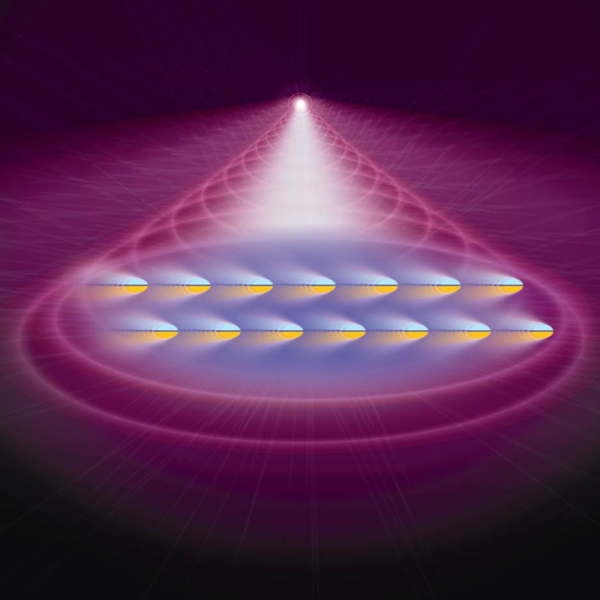 Bose-Einstein
Condensate & Rydberg Polarons - This is an avenue gaining some traction
trying to explain where the missing material might be hiding
without evoking dark matter. A lot of what seems to be
missing may be inside of or with other matter in a manner
that masks spectroscopic detection. A similar avenue
of investigation is around Rydberg Polarons which may
produce the same masking effects hiding matter in dust and
plasma in the "emptiness" of space. Bose-Einstein
Condensate & Rydberg Polarons - This is an avenue gaining some traction
trying to explain where the missing material might be hiding
without evoking dark matter. A lot of what seems to be
missing may be inside of or with other matter in a manner
that masks spectroscopic detection. A similar avenue
of investigation is around Rydberg Polarons which may
produce the same masking effects hiding matter in dust and
plasma in the "emptiness" of space.
-
Researchers Report The Creation Of Rydberg Polarons In A
Bose Gas - by Vienna University Of Technology / Phys.org
26FEB18.
-
Bose-Einstein Condensate In Cosmology - by University of
Lethbridge / McMaster University 23OCT18.
-
SPHEREx -
NASA Will Launch a New Space Telescope in 2023 to
Investigate the Universe Space.com / 13FEB19. If
dark matter and big bang theories are to fall, it may be
this machine that wields the axe to many of them.
-
A new method to study polarons in insulators and semiconductors
- by Ingrid Fadelli / Phys.org 08JUL19.
- Missing Baryons Found -
Discovery of massive warm-hot circumgalactic medium around
NGC 3221 - by Das et al / 20OCT19. Interesting note is
the concept that this medium may be impossible to see from
within one's own galaxy, and that the matter they have
discovered here is more massive than the mass of the galaxy
itself.
-
Bose-Einstein condensate: magnetic particles behave repulsively
- by I. V. Borisenko et al. / Nature Communications 24APR20.
- Image: Bose Einstein Condensate A - by National Institute
of Standards and Technology (Public Domain)
Link |
|
|
|
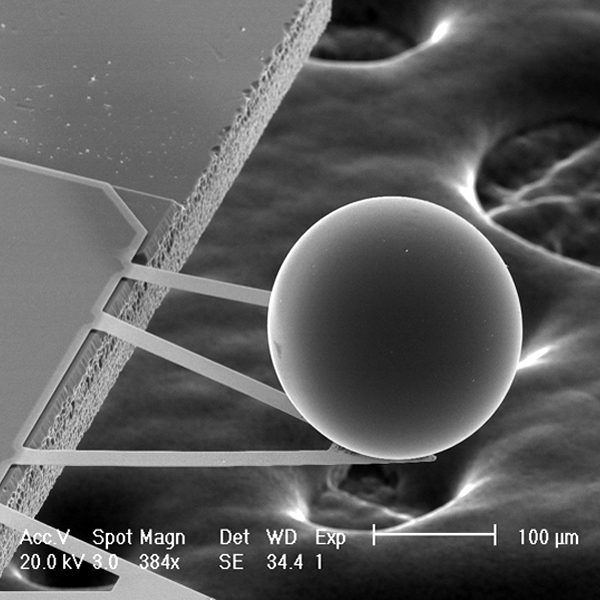 The
Casimir Effect
- Now that this force can be reliably measured, we are able to
peer into an entirely different plane of existence. The
generation of light with mirrors in this way is fascinating.
Yet, the implications hidden behind the mirrors are staggering
in terms of previously hidden pathways of communication and
interaction for biology. With the likelihood of other
kinds of biological interactions and a variety of potential
behaviors, we are just beginning to take our first brave steps
into a larger world, as Alec Guiness might say. The
Casimir Effect
- Now that this force can be reliably measured, we are able to
peer into an entirely different plane of existence. The
generation of light with mirrors in this way is fascinating.
Yet, the implications hidden behind the mirrors are staggering
in terms of previously hidden pathways of communication and
interaction for biology. With the likelihood of other
kinds of biological interactions and a variety of potential
behaviors, we are just beginning to take our first brave steps
into a larger world, as Alec Guiness might say.
Speaking
of ol' Ben, the Casimir effect and it's profound implications
aren't limited to the micro. It also may be the path to
next generation propulsion systems, the
quantum vacuum thruster.
As researchers harness mysterious Casimir force for tiny devices
and are manipulating nanoparticles, it looks as though we may
only be at the starting gate. A whole new class of medical
advances and nanodevices are on the immediate horizon, and
perhaps even down the road, something more. Science has
tried and failed numerous times to identify our 6th sense.
Evidence of energies that might explain the pervasive notion
that people can sometimes sense the spirit realm have long been
sought. (Effect
of negative reinforcement on ESP ability - by Venkman et al.
/ Columbia University 08JUN84). If indeed we possess
something like a soul and interact with another plane of
existence, perhaps the tapestry we weave with our lives will
turn out to be woven of Casimir thread.
-
Casimir Effect
- wiki.
-
Quantum Vacuum Thruster - Wiki.
-
The Casimir Effect in Biology: The Role of Molecular Quantum
Electrodynamics in Linear Aggregations of Red Blood Cells
- by K Bradonji et al / Journal of Physics 01MAY09.
-
First Observation of the Dynamical Casimir Effect
- by MIT 26MAY11. Light generation.
-
Casimir Forces On A Silicon Micromechanical Chip
- by Nature Communication 14MAY13.
-
NASA Tests 'Impossible' Engine, Finds Out It's Really Fast
- by Newsy Science 03AUG14.
-
Researchers Harness Mysterious Casimir Force For Tiny
Devices
- by Princeton 20APR17.
-
Inhomogeneity-Induced Casimir Transport Of Nanoparticles
- by APS Physics 24SEP18.
-
Synopsis: Chirality Turns the Casimir Force Repulsive -
by Qing-Dong Jiang and Frank Wilczek / APS Physics 04MAR19.
-
Researchers balance Casimir effects, make tiny hoverboard
- by John Timmer / ARS Technica 06JUN19.
-
Casimir effect creates ‘quantum trap’ for tiny objects -
by Tim Wogan / Physics World 07JUN19.
-
Researchers find a way to make Casimir effect attract or
repulse depending on gap size - by Bob Yirka / Phys.org
10JUN19.
- Image: Casimir Sphere - by Umar Mohideen (U. California at
Riverside) (Public Domain)
Link |
|
|
 To Leave The Nest Or To Wither Away, That's The
Question - As renowned physicist and philosopher Stephen Hawking
checks out, he leaves humanity with a profound warning, echoing a
core precept of the Grendelcat's. If humanity does not blossom forth
into the cosmos and leave the cradle of Earth, we are certain to
eventually become extinct via a catalogue of potential armageddons. To Leave The Nest Or To Wither Away, That's The
Question - As renowned physicist and philosopher Stephen Hawking
checks out, he leaves humanity with a profound warning, echoing a
core precept of the Grendelcat's. If humanity does not blossom forth
into the cosmos and leave the cradle of Earth, we are certain to
eventually become extinct via a catalogue of potential armageddons.
-
Stephen Hawking's final warning to humanity: Legendary physicist
believed we must leave Earth in the next 200 years or face
EXTINCTION - by Ellie Zolfagharifard & Phoebe Weston / Daily
Mail 14MAR18.
- Image: Stephen Hawking Graffiti by thierry ehrmann (CC2.0)
Link |
|
|
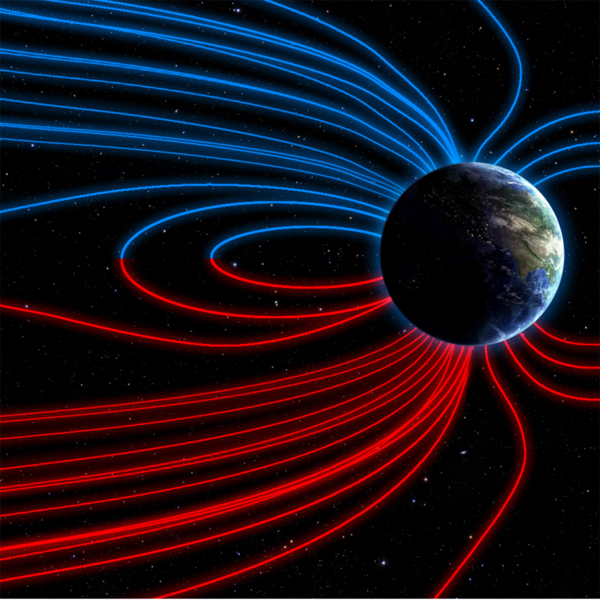 The
Suspicious Observers
- If you discovered some new things that you found intriguing
here at Lair Central, and want to peel back more layers of
fascinating science about these kinds of topics, the Grendelcat
highly recommends the
Suspicious Observers as a valuable
and informative resource. The
Suspicious Observers
- If you discovered some new things that you found intriguing
here at Lair Central, and want to peel back more layers of
fascinating science about these kinds of topics, the Grendelcat
highly recommends the
Suspicious Observers as a valuable
and informative resource.
The
SO daily news over morning
coffee is the best primer ever invented for diving into
one's day knowing things one really ought to know. |
|
|
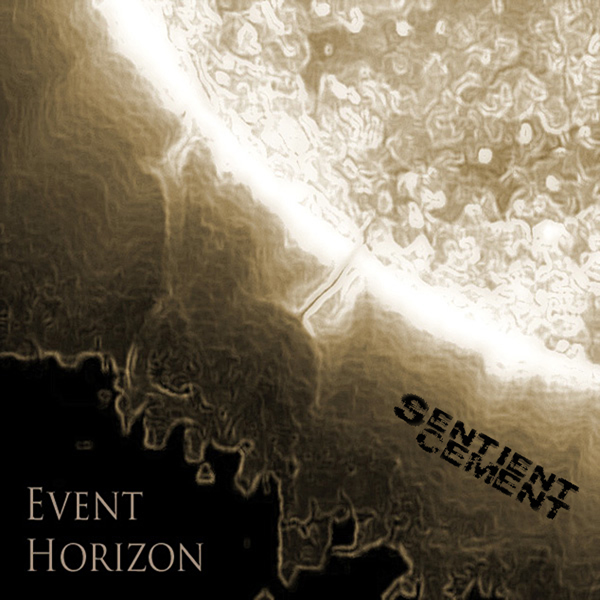 Check
Out My Band:
Sentient
Cement (Website) ||
Sentient Cement (Rumble) ||
Grendelcat Lair Clips (Rumble) ||
Grendelcat (Bitchute) ||
Sentient Cement (Amazon) ||
Sentient Cement (iTunes) ||
Sentient Cement (Spotify) ||
Sentient Cement (You Tube). Check
Out My Band:
Sentient
Cement (Website) ||
Sentient Cement (Rumble) ||
Grendelcat Lair Clips (Rumble) ||
Grendelcat (Bitchute) ||
Sentient Cement (Amazon) ||
Sentient Cement (iTunes) ||
Sentient Cement (Spotify) ||
Sentient Cement (You Tube). |
|
|
|
Lairticles
---------------------
The Grendelverse
||
Global Warming
||
Vaccines & Plandemics ||
Sun Nova & Crust
Displacement
Bad Arguments & Hatespeech ||
Cyborg ||
Glyphosate Roundup
||
Plasma Universe
|| Crack For Kids |
|
![]()